
- Indoor Gardening
- Houseplants
- Hydroponics
- Houseplants Made Easy Book


How To Care For A Wandering Jew Plant (Your Complete Guide)
When it comes to houseplants able to brighten up indoor spaces, it doesn’t get much more colorful than the variegated foliage of a Wandering Jew plant ( Tradescantia zebrina ). With their hardy nature and ease of care, they are a perfect choice for those feeling they kill everything they bring indoors. We’ve listed a quick summary of their care below.
How To Care For A Wandering Jew Plant: Grow your Wandering Jew in well-drained soil, kept moist but not soggy through regular watering. Create humidity, keep indoor temperatures between 50°F (10°C) to 85°F (29°C) and fertilize monthly.
Continue reading because we’ve taken all the guesswork out of caring for your Wandering Jew and keeping it healthy and happy for years to come.
How To Care For A Wandering Jew Plant
Wandering Jew plants belong in the Commelinaceae family, which includes around 652 different species. The family is made up of herbs, climbers and several epiphytes, with some used as outdoor and indoor ornamentals like Wandering Jew.
There are three different plants commonly known as Wandering Jews; Tradescantia fluminensis , Tradescantia pallida , and Tradescantia zebrina. Of the three, Tradescantia zebrina is the most common one grown and has the most eye-catching and colorful foliage. All three have the same requirements for care and good growth.
Native to Mexico and Guatemala, Wandering Jew is classified as a tender evergreen perennial that performs well planted outdoors in frost-free regions. Those living in cooler environments can easily grow it as an indoor plant planted either in containers or in hanging baskets. Outdoors it’s typically used as a quick-growing groundcover.
Although a common name shared with several very different plants, Wandering Jew is often called Inch Plant , due to the leaf margins being spaced about an inch apart. You may also find Wandering Jew listed as Zebrina Pendula , but is synonymous with Tradescantia zebrina and is the same plant.

When it comes to Wandering Jew plants, it’s all about the attention-grabbing foliage. The succulent stems give way to leaves that are a deep purple on their undersides with the upper portion striped in silvery-gray and greenish-blue. The oval leaves grow to about 2.5 inches long and the stems grow about 2 feet long. It makes a beautiful plant used in hanging baskets, with the long stems cascading over the side.
Even grown indoors, Wandering Jews have a fast rate of growth and before you know it, the plants will be spilling over your container’s or hanging basket’s sides. Whereas some indoor plants seem to take forever to fill out, this isn’t a problem with properly cared for Wandering Jew plants.
There are several other cultivars (varieties) of Wandering Jew, which include:
- ‘Purpusii’ has unstriped, hairy foliage that is either solid red or reddish-green.
- ‘Quadricolor’ produces metallic-green foliage striped in red, white and green.
Wandering Jew plants are the ideal candidates for beginner houseplant gardeners due to their hardiness and robust growth. Below we’ve outlined all the basics of their proper care, as well as identifying and preventing any potential problems so you can enjoy your Wandering Jew for years to come. The best indoor plants are those that are happy and healthy.

Soil Conditions For Wandering Jew Plants
Wandering Jew plants tolerate growing in a wide range of soils provided they drain well. Although they do tolerate and prefer moist conditions, the soil must drain properly to prevent root and stem rot from occurring. Therefore, it is necessary to use a lighter weight soil mixture in your pots rather than heavier soils that don’t provide proper drainage.
Straight potting soils are usually too heavy, retain too much moisture and have a tendency to leave the soil soggy. You can use a heavier potting soil in your soil mixture, just be sure to incorporate a lighter soil mix to provide the Wandering Jew the drainage required for healthy growth.
Commercial potting mixes work well and many have a slow-release fertilizer mixed in, which cuts down on the need for frequent feedings. The slow-release blends usually continue to fertilize the Wandering Jew for about three months.
You can also make your own soil by mixing several ingredients together such as:
- Using equal parts of compost and a potting mix.
- Mixing equal portions of compost, peat and potting soil or a potting mix.
- Using equal portions of a course sand, compost and potting soil or a potting mix.
Whatever soil you choose to use, just make sure it drains well and contains a bit of fertility for the best performance of your Wandering Jew plants.
Preferred Light Conditions
Although Wandering Jew plants tolerate lower light conditions than many houseplants, to help retain those striking colors the plant is known for, place the container in a location indoors receiving filtered sunlight. If your plant starts losing some of the color in the foliage, move it to a location that receives a bit more light.
In addition, if the lower portion of the stems start suffering leaf drop, the Wandering Jew isn’t get enough light and needs to be relocated to a brighter area inside the home.
Once the warm weather of spring arrives and if you’d like to give your Wandering Jew a bit of a break from its indoor location, place it in an outdoor spot that receives partial sun to partial shade. Moving it to an outdoor location with too much sun may leave the foliage sunburned.
Indoor Temperature Requirements
In the Wandering Jew’s native environment, temperatures are consistently warm without the threat of frosts or freezes. Generally, if the indoor temperatures inside your home are comfortable for you, they will also be comfortable for your Wandering Jew plant.
Indoor temperatures between 50°F (10°C) to 85°F (29°C) are a good range for your Wandering Jew plants. Plants grown in this temperature range produce the healthiest growth.
If you gave your plants a break from their indoor location, just make sure to bring them back indoors before the cold weather of winter strikes.
Water Requirements
Wandering Jews prefer soils that are regularly kept moist, not soggy, compared to many indoor houseplants. However, this doesn’t mean the soil should be kept so wet they never begin to dry out. Keeping the soil too wet for too long promotes rot to set in and you may end up killing your Wandering Jew plants. Your Wandering Jew is more likely to forgive you if you forget to water over watering too much and too often.
A good rule to follow is if the soil starts to feel like it’s about to become very dry, apply water. It’s easy to know exactly when to water by:
- Sticking your finger into the soil and if the top inch is starting to feel dry, water until it runs from the container’s bottom drain holes.
During the warm growing season of spring through summer, you can probably expect to water once each week. However, during winter when the Wandering Jew goes into dormancy (its growth slows), you will probably only need to water about every other week.

Humidity Requirements
Compared to many tropical plants grown indoors, Wandering Jew plants aren’t quite as fussy about humid conditions , but still need some humidity for the best growth and performance. Don’t let the thought of creating a humid environment stress you out because replicating humidity for your indoor plants is relatively easy and basic.
- Fill a spray bottle with room temperature water and mist the Wandering Jew several times each week.
- If you’re growing the Wandering Jew in a container and not in a hanging basket, you can set the pot on a tray of pebbles. As you water, the water seeps from the bottom drain holes onto the tray of pebbles and as it evaporates, it creates a humid environment around the plant.
- If your bathroom gets the appropriate amount of light for the Wandering Jew, you can allow it to grow there. Due to the regular use of water in a bathroom, moisture is created, creating the humidity the Wandering Jew requires.
Fertilizer Needs
Unless the soil mixture contains a slow-release fertilizer blend, which feeds the Wandering Jew for about three months, fertilizing monthly is sufficient for proper growth. You have several choices when it comes to fertilizer you can use for your Wandering Jew plant.
- Use a houseplant fertilizer applied at half-strength, applied when you do your regular watering.
- Use an all-purpose, water-soluble blend for outdoor and indoor plants, applied at half-strength and used during your regular watering schedule.
- If your soil mixture didn’t contain a slow-release fertilizer or it’s been about three months, if one was contained in the soil, you can reapply slow-release fertilizer granules sprinkled over the top of the soil. Follow the package directions on amounts.
When it comes to the appropriate time of year to fertilize the Wandering Jew, only fertilize while it’s actively growing, which is spring throughout summer. In winter, the plant goes through a dormant stage and all growth slows, so there is no need to apply fertilizer. Wait until spring arrives before you resume fertilizing the plant.
The one thing you will need to pay attention to when it comes to fertilizing is the buildup of salts in the soil, which can result in foliage burns. Wandering Jew plants have a low tolerance to salty soils. Preventing any salt buildup is relatively simple:
- If the plant isn’t too big, you can take the entire pot to your sink or bathtub and allow water to run slowly through the soil for about five minutes, flushing out any salts.
- If the plant is too big for indoor flushing, take it outside and allow water from the hose to run slowly through the soil for about five minutes. Allow the water to drain and then bring the plant back indoors.
Pruning Requirements
The pruning needs of Wandering Jew plants are low. If you want to control the size of the plant and promote bushier growth, you can pinch off the tips of the stems. To keep the plant always looking its best, you can trim off any broken, dead or damaged stems and leaves throughout the year.
When using pruning tools to trim your Wandering Jew always make sure they are clean so you don’t transfer any diseases or pests to your plant. This is as easy as wiping off the blades with alcohol.
Some people experience skin irritations when handling the cuttings due to the sap , so if you are unsure if you are one of these unlucky gardeners, it might be best to wear gardening gloves when pruning or handling Wandering Jew cuttings.
Potting Needs
If you purchased your Wandering Jew already potted in a hanging basket or 1-gallon container, it should thrive as is for a year or more before it requires repotting. However, if you received rooted cuttings in smaller containers like 4- to 6-inch pots, you most likely need to repot them into something a bit larger so they can grow properly.
This also cuts down on the need for repotting in a month or two as the Wandering Jew begins to outgrow its present pot.
When it comes to the pot’s material, any type works quite well for growing this plant from clay to plastic. However, if you grow your Wandering Jew in a pot made of a porous material like terra cotta, the soil is going to dry quicker than if it was growing in a plastic pot. This means you will need to water more frequently.
Once your Wandering Jew starts getting too big for its present container, it’s time to repot it into one that is around 1- to 2-inches larger. Although the plant likes a moist soil, make sure the pot has bottom drainage to prevent the possibility of rot due to conditions that are too wet.
If you like, you can dress the container up by placing the draining one inside a decorative pot without bottom drain holes, but be sure to empty out any additional water once the inner pot thoroughly drains.
I think a decorative outer pot can add so much to the beauty of your houseplants, so I do this with almost all of my houseplants. Read this article which discusses my favorite decorative planters if you need some inspiration.
Potting and repotting your Wandering Jew is basic:
- Gently remove the Wandering Jew from its present container, being careful not to break the succulent stems.
- Fill the new container that drains about a quarter of the way full with a fertile, well-drained potting mix.
- Check the Wandering Jew’s root system and if it’s growing bunched together and filled the previous pot, gently tease the roots apart with your hands.
- Place the Wandering Jew into the new container and finish filling it with soil.
- Water the Wandering Jew until it runs from the bottom drain holes and place in a bright location indoors.

Propagating New Plants
When it comes to propagating new plants, Wandering Jew is about as easy as it gets. Even if you have never done this before you should have success starting its cuttings. When you trim to control its size, don’t throw those cuttings away but use them to start additional plants.
You have two choices when it comes to rooting your cuttings and both are easy. The first thing you will want to do is obtain your cuttings. Trim off a 4- to 6-inch cutting from the mother plant and you’re ready to start rooting.
Rooting in Soil
- Fill a 6-inch to 1-gallon container that drains with a rich, well-drained potting mix. Water the soil to settle it.
- Make about a 2-inch indentation in the soil where you want to place the Wandering Jew cutting.
- Remove the bottom leaves from the cutting where you will be inserting it into the soil. You can do this by pinching them off with your fingers.
- Place the cutting into the indentation and firm the soil up around it with your fingers.
- Water the soil again and place the cutting in the same light conditions where the mother plant was thriving. Keep the soil moist but not soggy.
Roots should form in about four weeks and after about eight weeks, the Wandering Jew cuttings should form a new root system.
Rooting in Water
- Fill a glass jar or plastic container with about 3-inches of room temperature water.
- Pinch off any leaves from the section of the Wandering Jew cutting that will be submerged in the water.
- Place the cutting in the water and situate the container in a bright indoor location.
- Change the water in the container about every other week, or when cloudy.
You should start seeing new roots form on the cuttings in several weeks. Once the roots are several inches long, you can repot the cuttings into a draining container filled with fertile, well-drained soil.
Disease Problems
Wandering Jew plants grown indoors are hardy and don’t have major diseases that plague them. However, rot is their biggest enemy and caused by soils that are too heavy and do not drain properly, retaining too much water. Overwatering and planting in pots that don’t drain are other causes of rot problems.
When rot rears its ugly head you’ll notice the bottom stems, as well as the foliage turning black, becoming mushy and the entire plant collapses. If this happens and seems to start affecting the entire Wandering Jew plant, you can trim off healthy, unaffected sections of the stems and repot into fresh, clean soil. Since there is no saving the rot-infected sections, you will have no choice but to discard those portions of the plant.
Steps for preventing problems with rot include:
- Using lightweight potting mixes that drain well and aren’t too heavy, which leads to the soil remaining too wet for too long. Some types of potting soils have a tendency to be heavy and need mixing with a potting mix, compost, coarse sand or peat.
- Don’t overwater your Wandering Jew. Although they prefer growing in moist soils, this doesn’t mean constantly soggy soil. Stick your finger into the soil and if the top inch is starting to become dry, apply water until it runs from the bottom of the pot.
- Make sure the pot you are growing your Wandering Jew in has bottom drainage. If you have placed the pot inside a decorative one that doesn’t drain, make sure to empty all the water from it after you have watered.
Pest Problems
Although indoor Wandering Jew plants are not big candidates for problems with pests, several can cause an infestation and problems. As with any pest problem indoors or outside in the garden, quick control is always the best option to keep your plants healthy. It also assures the pests do not migrate to your other plants causing even bigger problems and headaches.
The pests most likely to infest your indoor Wandering Jew plants are:
- Aphids: Aphids come in a host of different colors and are tiny, pear-shaped, sap-sucking insects that usually congregate in large masses along the Wandering Jew’s stems. In large infestations, they can kill the plant or severely weaken it. If the infestation is small, you can wipe the pests off the stems with a moist cloth. However, if the infestation is large, you will probably have to spray the plant with an insecticidal soap or Neem, reapplying as suggested on the package.
- Spider Mites: Spider mites are another sap-sucking pest that if left unchecked can quickly kill or weaken the Wandering Jew. It is easy to tell if you have a spider mite problem as these tiny, white pests spin fine webbing that covers the plant. Spider mites can be the bane of houseplants so quick control is necessary. Use an insecticidal soap or Neem and spray the entire plant, reapplying as suggested on the product label.
- Whiteflies: Whiteflies are other sap-sucking pests that can quickly kill or weaken your Wandering Jew if not quickly controlled. They are another easily identifiable pest, as just touching the plant sends the tiny whiteflies from the plant’s foliage and into the air, hovering right above it. Control the problem with an insecticidal soap or Neem, spraying the entire plant and reapplying as suggested on the product’s label.
- Mealybugs: Sap-sucking mealybugs show up on the Wandering Jew as cottony masses covering the stems and crotches of the foliage. Control the problem by spraying the entire plant with insecticidal soap or Neem, reapplying as suggested on the product’s label. If the infestation is small, you can also wipe them from the stems and leaves with a damp cloth.

Is Wandering Jew A Perennial?
Wandering Jew plants are considered a tender, evergreen perennial. Unlike annuals, and if grown in preferred conditions with proper care, Wandering Jews should live and keep on growing for quite a few years, both indoors and outside.
Why Are My Wandering Jew Plant’s Leaves Losing Their Color?
If your Wandering Jew is growing in light conditions that are too low, the leaves will start to lose their color and become duller. When grown indoors and to keep the bright color on the foliage, make sure the Wandering Jew is growing in a location receiving bright light.
Why Are My Wandering Jew’s Leaves Dropping?
Wandering Jew plants grown in light conditions that are too low will start dropping leaves at the base of their stems. Solve the problem by moving the plant to an indoor location that is brighter. For the best leaf color and growth, they prefer an indoor location receiving bright light.
Why Are My Wandering Jew Cuttings Rotting In Soil?
If your Wandering Jew cuttings are rotting in soil it could be one of two things causing the problem. The soil you are growing the cuttings in may be infected with a fungus that is infecting them with rot.
You can solve the problem by planting the cutting in a sterile, well-drained potting mix. Another cause might be the soil is remaining too soggy and the container doesn’t drain.
Make sure you are using a soil that drains well and doesn’t remain soggy, do not overwater and use a container with bottom drainage. Water the cuttings when to top inch of soil feels dry to the touch.
Can I Root Wandering Jew Cuttings In Water?
Wandering Jew cuttings root quite well in water. Fill a container with several inches of water, remove any leaves that would be submerged and stick the cut end into the water.
Fill the container with fresh, clean water about every other week. You should start seeing root form on the cuttings in several weeks. Once the roots get several inches in length, you can repot the cuttings in a draining container with rich, well-drained soil.
Are Wandering Jew Plants Toxic?
When it comes to humans, Wandering Jew’s sap can cause skin irritation in humans that are allergic to it. Therefore, it’s best to wear gardening gloves when handling or pruning the plant.
The plant is listed as toxic to dogs and cats, due to its tendency to cause skin allergies and dermatitis. To keep your pets and children safe, make sure you situate your indoor Wandering Jew out of the reach of both.
If you’d like some indoor plants that are non-toxic, check out this article which discusses my favorite non-toxic houseplants.
Do Wandering Jew Plants Produce Blooms?
When grown outdoors, Wandering Jews produce small, three-petaled, lavender flowers, but the plant rarely ever blooms grown indoors as a houseplant.
Can I Grow Wandering Jew Outdoors?
Wandering Jew plants grow as perennials planted outdoors in frost-free climates, however, those with cooler weather can plant outdoors and treat it as an annual.
What’s The Growth Rate For Wandering Jew Plants?
When grown in proper conditions with proper care, Wandering Jew plants are considered fast growers.
Many thanks for reading my guide to Wandering Jew care. This really is a great indoor plant for your home. Beautiful and easy to care for, its hard to go wrong.
If you want more help with looking after your indoor plants, check out the rest of my articles , and head over to my resources section , where I have some great recommended resources, books and equipment to help you grow healthier, more beautiful plants.
- PRO Courses Guides New Tech Help Pro Expert Videos About wikiHow Pro Upgrade Sign In
- EDIT Edit this Article
- EXPLORE Tech Help Pro About Us Random Article Quizzes Request a New Article Community Dashboard This Or That Game Popular Categories Arts and Entertainment Artwork Books Movies Computers and Electronics Computers Phone Skills Technology Hacks Health Men's Health Mental Health Women's Health Relationships Dating Love Relationship Issues Hobbies and Crafts Crafts Drawing Games Education & Communication Communication Skills Personal Development Studying Personal Care and Style Fashion Hair Care Personal Hygiene Youth Personal Care School Stuff Dating All Categories Arts and Entertainment Finance and Business Home and Garden Relationship Quizzes Cars & Other Vehicles Food and Entertaining Personal Care and Style Sports and Fitness Computers and Electronics Health Pets and Animals Travel Education & Communication Hobbies and Crafts Philosophy and Religion Work World Family Life Holidays and Traditions Relationships Youth
- RANDOM QUIZ
- Browse Articles
- Learn Something New
- Quizzes Hot
- This Or That Game New
- Train Your Brain
- Explore More
- Support wikiHow
- About wikiHow
- Log in / Sign up
- Home and Garden
- Indoor and Patio Plants
A Complete Guide to Wandering Jew Plant Care
Last Updated: March 27, 2024 Fact Checked
- Potting Your Plant
- Caring for Your Plant
Preventing Pests & Disease
Expert q&a, things you'll need.
This article was co-authored by Chai Saechao and by wikiHow staff writer, Dev Murphy, MA . Chai Saechao is the Founder and Owner of Plant Therapy, an indoor-plant store founded in 2018 based in San Francisco, California. As a self-described plant doctor, he believes in the therapeutic power of plants, hoping to keep sharing his love of plants with anyone willing to listen and learn. There are 12 references cited in this article, which can be found at the bottom of the page. This article has been fact-checked, ensuring the accuracy of any cited facts and confirming the authority of its sources. This article has been viewed 631,535 times.
Wandering Jews are beautiful vining plants known for their solid or variegated leaves. These hardy perennials thrive outdoors as groundcover or in pots that allow their tendrils to cascade. They’re relatively easy to care for and incredibly simple to propagate, making them great houseplants! Keep reading for an easy step-by-step guide to Wandering Jew maintenance, from planting to watering to pruning.
Things You Should Know
- Keep your Wandering Jew in a warm spot (around 50–80 °F (10–27 °C)) with lots of bright, indirect sunlight.
- Pot your plant in well-draining potting soil in a container with drainage holes. Keep the soil moist, but not soaking wet.
- Pinch or prune the leaves when the plant gets leggy to promote bushiness, or when any leaves or vines begin to brown or rot.
Potting Your Wandering Jew Plant

- Refer to this map to see if your area's temperatures are warm enough to support a Wandering Jew plant, if you're planning on keeping it outside. According to the USDA, the Wandering Jew plant grows best in zones 9-11.
- If you don’t live in USDA hardiness zones 9-11, keep in mind that you may not be able to keep your plant outside during the winter. You may want to grow it inside instead.

- If you use a hanging basket, remember to turn it daily so it gets equal amounts of sunlight.
- If you’re hanging your plant, choose a lightweight or plastic pot so it won’t fall. This also makes it easier to move inside in case of frost.

- Be careful not to use soil that’s too heavy, as Wandering Jews need light soil that drains well. [3] X Research source
- Buy well-draining soil, or, if you already have heavier soil, mix equal parts soil with compost, or equal parts soil, compost, and peat.
- Purchase a Wandering Jew plant at a gardening or home improvement center, or propagate cuttings from established plants . Wandering Jew cuttings grow very quickly.
Watering, Fertilizing & Pruning Your Plant

- If you’re growing your plant indoors, an eastern facing windowsill is a good spot. The plant will receive bright indirect light throughout the day, but watch to make sure the space doesn't become too hot in the afternoon. If so, move the pot a few feet away or use a curtain to filter the light. [5] X Research source
- If the plant primarily remains outside, find a spot that receives indirect sunlight. This could be on a porch that gets morning sun for several hours. Just make sure that it's not sitting in direct sunlight without any shade for most of the day.

- If you've set your pot on a saucer, empty the saucer when it fills.
- The plant's growth will slow in the winter months, meaning it needs to be watered less often. Simply let it remain a little dry for a bit longer before watering.
- Some people find it convenient to put self-watering aqua globes in their plant pots; however, these glass globes require cleaning and regular filling. You'll still need to monitor your plant's moisture if you choose to use them.

- Read the container's instructions carefully before fertilizing, as some liquid fertilizers may actually be powders requiring you to mix in water.

- The best time to prune is during the spring and summer months, when the plant is putting on the most growth. After you've pruned, give the plant a chance to put on new shoots and fill in.
- If you find your plant is too dense and bushy, you'll need to prune around the base so that the plant can get adequate circulation and sunlight.

- Generally, expect to repot your plant annually, but keep an eye out for signs your plant has outgrown its container within that time frame: once you see roots creeping out from under the plant through the drainage holes, or popping up through the soil, it’s time to repot. [10] X Trustworthy Source Penn State Extension Educational organization dedicated to delivering science-based information to people, businesses, and communities Go to source

- Try to use distilled or bottled water when misting the leaves for the best results.
- Brown leaves can also be a sign that your plant is getting too much sunlight. In this case, make sure your plant is not directly in the sun by moving the pot or placing a filter, such as a curtain, in between the plant and the window.

- Root rot can spread very quickly, so act fast when you see signs of it. It can be heartbreaking to cut away a large chunk of your plant, but if you wait too long, you could lose the whole plant. [14] X Research source
- Other signs of root rot include spongy, black roots.

- Though "Wandering Jew" is the most common name for this plant, some people may find this term offensive. Consider using "wandering dude" or "inch plant" instead. Thanks Helpful 2 Not Helpful 2
- "Wandering Jew" doesn't refer to just one plant: it refers to a variety of Tradescantia species, the 3 most common of which include Tradescantia fluminensis ("Quicksilver"), Tradescantia pallida ("Purple Heart"), and Tradescantia zebrina ("Tricolor"). Care is the same for all 3. Thanks Helpful 1 Not Helpful 1

- Be careful when pinching or pruning your plant. Wandering Jew sap can cause skin irritation in some people and allergic reactions in dogs. To be safe, wear gardening gloves when pruning your Wandering Jew. [15] X Research source Thanks Helpful 0 Not Helpful 0
- Wandering Jew cuttings or a plant
- Well-draining potting soil
- Pot or hanging basket
- 10-10-10- fertilizer
- Aqua globes (optional)
- Pruning shears (optional)
- Gardening gloves
You Might Also Like

- ↑ https://houseplantcentral.com/tradescantia-zebrina-care-info/
- ↑ https://www.almanac.com/plant/inch-plants
- ↑ https://getbusygardening.com/wandering-jew-plant-care/
- ↑ https://www.weekand.com/home-garden/article/indirect-light-plants-18005506.php
- ↑ http://www.almanac.com/plant/wandering-jew
- ↑ https://www.weekand.com/home-garden/article/use-101010-fertilizer-garden-18057536.php
- ↑ http://www.gardeningknowhow.com/houseplants/wandering-jew/growing-wandering-jew-plants.htm
- ↑ https://extension.psu.edu/repotting-houseplants
- ↑ http://www.houseplantsforyou.com/wandering-jew/
- ↑ http://www.gardeningknowhow.com/plant-problems/disease/treating-root-rot-gardening-tips-for-housplants.htm
- ↑ https://www.wildinteriors.com/blog/2019/10/30/treating-root-rot-and-soft-rot-in-houseplants
- ↑ https://www.weekand.com/home-garden/article/wandering-jew-plants-dangerous-dogs-18063157.php
About This Article

To take care of your Wandering Jew plant, place it by an east-facing window so that it gets a combination of direct and indirect sunlight. Keep the soil moist, but not soaked, and water the soil instead of the top of the plant to avoid rot. You should also fertilize the Wandering Jew plant every two weeks with a liquid 10-10-10 fertilizer. To keep the plant from getting leggy, trim back the stems in the spring and summer. Did this summary help you? Yes No
- Send fan mail to authors
Reader Success Stories
Nancy Gibson
Jun 6, 2016
Did this article help you?

Sherry Clark
Mar 30, 2016
Sep 23, 2016
Beverly Cox
May 18, 2016

Featured Articles

Trending Articles

Watch Articles

- Terms of Use
- Privacy Policy
- Do Not Sell or Share My Info
- Not Selling Info
Don’t miss out! Sign up for
wikiHow’s newsletter

Wandering Jew Plant – Ultimate Care Guide
By: Author Daniel
Posted on Last updated: September 18, 2023

Sharing is caring!
- Facebook 60
You are reading this guide to learn more about the Wandering Jew Plant and its care . I have had this plant at home for many years and write about all the growing aspects in this guide.
Wandering Jew Plant Care Takeaways
What is the wandering jew plant.
The Wandering Jew, or Tradescantia zebrina, by its scientific name (old name = Zebrina pendula) is native to Mexico. It is not to be confused with Tradescantia albiflora, which also goes by Wandering Jew and has very similar care needs.
Tradescantia zebrina has attractive foliage, sporting exciting zebra-patterned leaves. It also flowers. But when kept as a houseplant, this rarely ever happens. It is a fast-growing and excellent groundcover, according to the University of Florida .

W andering Jew Plant Care
To keep your Wandering Jew plant thriving, ensure it receives bright, indirect sunlight. Keep it in average room temperatures of 60-75°F (16-24°C). Fertilize once a month during spring and summer. In winter, relocate the plant to a cooler area with temperatures of 54-59°F (12-15°C).
Table of Contents
Tradescantia zebrina Growing guide
Tradescantia zebrina care is pretty straightforward, but it certainly can’t hurt to glance at the most important things to consider when caring about this herbaceous perennial plant.
So, without further ado, let’s see how you can make your Wandering Jew, aka the Inch plant, as happy as possible.
Any good potting soil will do for your Wandering Jew. For instance, this could be Miracle Gro potting soil readily available online in stores like Amazon.
But these plants not only feel very comfortable in soil but can also be kept in hydroponics .
Sunlight is a vital aspect when it comes to the well-being of most houseplants. Some houseplants do well with moderate sunlight, while others only thrive (or flower) when a certain level of sunlight is guaranteed.
The Wandering Jew does best in bright, indirect sunlight .
If you are unsure what that means, please look at our Light Levels article.
The Wandering Jew, a tropical native, thrives best when the root ball is always well moisturized. Still, waterlogging should be avoided whenever possible, as this could lead to root rot .

This tropical plant does not enjoy limy water. Use soft water whenever possible. Rainwater and distilled water are very good choices.
Temperature
People who own an Inch plant and keep it outside run the risk of exposing it to cold temperatures. This is where indoor plant owners have the upper hand.
Wandering Jews can thrive with average room temperatures of 60 to 75°F (16 to 24°C) if it doesn’t drop for long periods. Anything below 12°C for an extended period could be fatal for your Wandering Jew.
Wandering Jews prefer a humidity of around 70%
The perennial, herbaceous Wandering Jew plant is native to Mexico, Central America, and Colombia, so it should not surprise you that it likes a good deal of humidity.
To ensure high humidity levels, regularly misting your plant is a very good idea. A hand mister filled with water does the trick.
As for the location, you may want to keep your Wandering Jew in the bathroom , as this is usually the place in the house with the highest humidity.
Feed your plant once a month during spring and summer. In winter, fertilizing is not necessary.
Also, fertilization of the Wandering Jew is only necessary from the second year of cultivation or after repotting.
Propagation
It is best propagated through stem tip cuttings. Propagating the Wandering Jew is an easy task.
Wandering Jews don’t get very tall. They might reach a height of about 14 inches (36 cm) when kept indoors. They spread to about 10 inches (25 cm).
(Re)potting
The thing with the Wandering Jew is that it grows fast , hence its nickname “Inch plant.” Because of its fast-growing pace, the plant usually gets very leggy, and leaves are often lost near the base of the plant.
Repotting is pivotal for keeping the root system healthy regardless of the actual plant species. However, how often a houseplant needs to be repotted depends on various factors.
Some houseplants grow incredibly fast, so they need to be repotted often. Others, on the other hand, grow very slowly, so repotting is not a top priority.
That said, repotting your Wandering Jew occasionally is a good idea.
How long does a Wandering Jew live?
As far as the longevity of Wandering Jews goes, they often don’t get older than 2 to 3 years.

Wandering Jew Watering
Water about once every 5-7 days in spring and summer. Keep the soil slightly humid. Do not let the Wandering Jew dry out between waterings. Use your index finger to check if the soil is dry down 1-2 inches of soil (2.5 – 5 cm).
Reduce watering to every 10-14 days in autumn and winter.
Wandering Jew Propagation
The Wandering Jew roots very easily . The plant can easily be propagated through stem tip cuttings.
When propagating your Wandering Jew, make sure that your plant is in a healthy condition.
Please follow our step-to-step guide to propagate your Wandering Jew through stem tip cuttings.
Propagation through stem tip cuttings
- Identify the plant that you want to replicate. It should have healthy growth and plenty of stems.
- Make clean cuts on sections that are three to six inches in length .
- Use a sharp knife and carefully cut the leaves on the stem’s bottom half.
- If you want, you can dip the exposed end of the stem in a rooting hormone . This will speed up the rooting process. However , it is unnecessary .
- Place your stem tip cuttings into a pot with fresh soil after thoroughly watering the potting mixture.
- Use a clear plastic bag to hold in moisture, taking it off to water weekly .
- Keep your eyes on the plant for new growth . You should start to see roots in about two to three weeks . Once this happens, transfer the plant babies to a larger pot.
Note: Instead of rooting your stem tip cuttings directly in soil, you could also root them in water .
Wandering Jew Pest Control
Wandering Jews are prone to aphids and spider mites attacks. So, you will need to look out for these two little pests.
Some of these are known to cause defoliation, while others can kill the plant altogether. Depending on the severity of the infestation, you may need to use chemicals or insecticides .
Aphids on my Inch Plant
The Wandering Jew is not particularly susceptible to plant diseases or pests. Yet, you might have to deal with an aphid attack at some point. These parasites pierce the leaves of their host plant and suck their sap.
Like scale insects, they excrete sticky honeydew, by which you can immediately recognize the infestation.
Aphids can multiply explosively, especially in warm , dry environments.
As a preventive measure, ensure regular watering and occasional misting of your Wandering Jew.
The best way to combat aphids is to control them mechanically by rinsing them off the plant with water . Isolate the plant from the rest of the collection.
Pest Prevention
To prevent the Wandering Jew from pest infestations, plucking dried leaves regularly makes sense as well as using neem oil. The dried leaves lying on the substrate must be removed. Otherwise, there is a risk of rotting or infestation by parasites and fungi .
Wandering Jew Problems
Brown leaf tips.
Brown leaf tips is a very common problem with a wide variety of houseplant. Depending on the species, the causes for this problem can be very different, though.
So what causes leaves to turn brown with Wandering Jews?
My Wandering Jew has only green leaves (not enough variegation)
If you do own a variegated Wandering Jew but only see a great amount of non-variegated leaves, chances are that your plant does not get enough sunlight .
To solve the problem, allow your Wandering Jew some bright, indirect sunlight by placing it in a sunnier location.
Fading leaves
If your inch plant’s foliage is suddenly losing color and sports fading leaves, this is another sign that it does not get enough sunlight .
Dropping leaves
Dropping leaves is another very common problem many plant parents must deal with regularly . If your Wandering Jew drops leaves, this is usually due to too low or too high temperatures .
In summer , ensure your Wandering Jew is exposed to average room temperatures.
In winter , it should be kept in a cooler environment.
Is Wandering Jew care difficult?
Wandering Jews are considered low-maintenance plants and are perfectly suitable for beginners.
They do well at average room temperatures, don’t demand a very high level of humidity (which is sometimes difficult to achieve in a home environment), and it is very easy to propagate them through stem tip cuttings.
Which plant species are commonly referred to as “Wandering Jew”?
Tradescantia zebrina as well as Tradescantia albiflora.
What is the difference between Tradescantia zebrina and Zebrina pendula?
There is no difference between Tradescantia zebrina and Zebrina pendula. Zebrina pendula is just the old name for Tradescantia zebrina.
Does my Wandering Jew flower at all?
Wandering Jews are indeed flowering plants. However, when kept indoors, they very rarely flower.
How long can you keep a Wandering Jew?
If you don’t propagate your Wandering Jew, you can keep it for about three years. After that period, the quality of your Wandering Jew will most likely decrease. If you regularly propagate your leafy friend through stem tip cuttings, you can keep it indefinitely.
Any display tips for Wandering Jews?
Wandering Jews look great in hanging planters!
Is the Wandering Jew toxic to cats?
The Wandering Jew plant is toxic to cats. Therefore, you have to keep your cat away from this plant.
Is the Wandering Jew toxic to dogs?
Yes, the Wandering Jew plant is toxic to dogs. Therefore, you must ensure your dog does not come in contact with this plant.
What are the health benefits of Tradescantia zebrina, if any?
Not only is The Wandering Jew a beautiful houseplant famous for its striking foliage, but it also presents several health benefits for humans. It is especially known for its antioxidant and antibacterial activity, and it is widely used in Traditional Medicine in several countries. Tradescantia zebrina is also believed to be a valuable source for treating kidney diseases.
The Last Zebrina
The Wandering Jew is a great houseplant that looks stunning in hanging planters. Its care is easy apart from its humidity-loving nature.

Daniel has been a plant enthusiast for over 20 years. He owns hundreds of houseplants and prepares for the chili growing seasons yearly with great anticipation. His favorite plants are plant species in the Araceae family, such as Monstera, Philodendron, and Anthurium. He also loves gardening and is growing hot peppers, tomatoes, and many more vegetables.
Related Posts
(image credits, IG:oohyouplantsy) I have a hide-away in my home that I escape to for…
How much light does my plant need? This is a relevant question as too little…
I love plants that offer an eye-catching burst of color. They sure put a smile…
Most of the 45+ species in the Monstera genus are famous for their unusual leaves…
One of the rarest Anthuriums is the Anthurium Reflexinervium, a gorgeous plant naturally found only…
Hoya Lauterbachii belongs to Hoyas's family, which are known to be the largest plants on…
Home » House Plants » Wandering Jew
Tradescantia Care: Growing The Wandering Jew Plant

The Tradescantia plant is commonly known as the Wandering Jew plant – an attractive vining plant whose distinctive leaves bear stripes of purple, white, green, and silver.
The botanical name for the tricolor wandering jew? Tradescantia zebrina !

The wandering jew from the genus Tradescantia is a native of Mexico who earned its common name thanks to the plant’s ability to root easily, spread, and thrive in a wide variety of conditions.
This plant comes from the spiderwort family (Commelinaceae) and is also known as Zebrina pendula or inch plant .
Another popular wandering jew variety is Tradescantia pallida – with deep purple leaves and goes by several common names like purple wandering jew, purple queen, and purple heart.
There are several other wandering jew varieties with green and white variegated leaves.

Tradescantia displays small 3-petaled pink, white, or purple flowers.
Wandering Jew Quick Care Tips
- Botanical Name: Tradescantia zebrina
- Common Name(s): Wandering Jew, Inch Plant, Spiderwort
- Synonyms: Zebrina pendula, Zebrina purpusii
- Family & Origin: Commelinaceae family, native to Mexico and Central America
- Growability: Easy to grow
- Grow Zone: 9-11
- Size: Grows up to 2-3 feet long
- Flowering: Produces small, purple flowers in the summer
- Light: Prefers bright, indirect light but can tolerate low light
- Humidity: Tolerates low humidity but prefers higher humidity levels
- Temperature: Thrives in temperatures between 55-75°F
- Soil: Well-draining soil
- Water: Water when the top inch of soil is dry, do not overwater
- Fertilizer: Fertilize once a month during the growing season with a balanced fertilizer
- Pests & Diseases: Susceptible to spider mites and mealybugs; watch for root rot if overwatered
- Propagation: Propagated through stem cuttings
- Plant Uses: Used as a trailing plant in hanging baskets or as a ground cover in gardens. Can also be used as an indoor plant.
In the “old days” before the advent of garden centers and nurseries carrying a wide variety of houseplants, housewives and gardeners shared cuttings of plants freely.
Cuttings of the wandering jew traveled broadly from home to home and proved itself adaptable and capable of thriving in almost any setting.

This reminded people of the wanderings of the Jews of biblical times, hence the nickname.
This easy-care plant grows indoors or out in a variety of settings.
In this article, we will provide best practice instructions on how to grow and care for Tradescantia and provide some words of caution regarding another invasive species related to it, Tradescantia fluminensis . Read on to learn more.
Wandering Jew Plant Care Tips
Wandering Jew vines do well in pots planted in a 60/40 peat moss and perlite potting mixture or with an all-purpose potting mixture .

This indoor plant makes an exceptionally beautiful hanging basket plant .
Lighting can vary from medium indirect light to even direct sun. Likewise, this hardy plant does well in room temperatures ranging from 55° – 75° degrees Fahrenheit.
NOTE: Tradescantia Plants will achieve the most vibrant, bright colors in high, bright, indirect sunlight and at consistently warmer temperatures.
Like most houseplants, the Wandering Jew does not like soggy roots. Translation – Too much water leads to root rot.

Allow the soil to dry completely between waterings, then water deeply. If desired, use a half-strength general liquid houseplant fertilizer two times monthly.
Do not water directly into the crown of the plant. Doing so may encourage rotting of the stems and the roots .
These plants like a humid environment, so add a humidifier or, between watering, mist the leaf surface frequently.
Continue misting through the winter, but cut back on watering. Generally speaking, watering once a week should work.

During the winter, reduce watering to two times monthly, and do not fertilize.
Pruning and grooming play an important role in caring for your Wandering Jew indoors.
These houseplants are vigorous growers and send out long tendrils and stems on a regular, ongoing basis. Keep these trimmed or pinched back at leaf nodes to encourage your new bushier growth and fuller plants.
Propagation of this rambling plant is very easy.
Simply clip off the long stem cuttings (3” length) during the spring and summer months and root them in moist potting soil or in water.

Growing Wandering Jew As An Outdoor Plant
Wandering Jew thrives in a temperate climate with fairly high humidity. Hardy in USDA Zones 9-11.
Tradescantia tricolor makes a good ground cover in spots receiving bright indirect light, such as around the base of tall trees, which are shady areas.
They also serve as a great ornamental and basket plant.
Planting is simplicity itself. You can use four-inch plants in pots purchased from a nursery or use cuttings of stem tips from your houseplant for repotting or creating new starts.

You’ll get the best results planting in rich, well-drained soil.
Be sure to cover the roots or sink your cuttings 3″ to 5″ inches into the soil. Keep a moist soil until the plant becomes established.
After this, weekly regular watering should suffice. Applying liquid fertilizer once a week or apply a slow release fertilizer to help to develop a healthy root system.
Keep plants pinched back and pruned to encourage them to grow bushy rather than in a spindly and trailing manner.
NOTE: Some people report skin irritation when coming in contact with the sap when handling cuttings.
Wandering Purple Jew plants will die back outdoors during the cold winter months. Fear not, if you plant correctly and help establish a good root system they will reappear come springtime.

Three Best Ways To Root Tradescantia
- Poke the ends of cuttings into fresh potting soil and keep the soilless mix moist for a few weeks. During the rooting process (rooting hormone is not needed), keep plants in partial shade. Once rooted, transfer them to pots and water as you would a mature plant.
- Simply lay cuttings on the surface of the moist potting mix. Press the cutting joint into the soil mix to make good contact. Roots will form at the joint. Once the plant becomes established, transfer it to its own pot with drainage holes.
- Place cuttings in a glass or bottle of water set on a sunny windowsill. Once roots emerge, transfer cuttings into pots. Keep the soil moist for a few weeks until the cuttings adjust and establish themselves in the soil.

Replacing The Wandering Jew Sometimes Becomes Necessary
This houseplant does not usually live for long periods of time like a Hoya the wax plant or grandma’s African violet plant. Luckily, it regenerates itself easily.
If your Wandering Jew begins looking shabby, loses foliage easily, and gets too leggy, you may want to simply toss it into the compost pile and replace it with one of its offspring.
Alternatively, you could try cutting the foliage back to the roots to see if it will regenerate.
Pests and diseases rarely attack Wandering Jew, but occasionally, you’ll discover spider mites and aphids on the leaves and stems.

When this happens, simply cut back the affected areas and dispose of the cuttings in a sealed plastic bag.
Spray plants vigorously with water to knock off any errant pests. Depending on the infestation, this should take care of the problem.
If it does not, turn to natural insecticides for killing any remaining aphids and prevent reinfestation.
NOTE: Don’t compost diseased or pest-infested plants.
Beware Of The Wandering Jew’s Invasive Cousin!
So far, we’ve discussed the wandering jew – Tradescantia pallid. Another variety, known as Tradescantia fluminensis, is solid green and produces white blooms.

This wandering Jew variety thrives in USDA zones 9 through 11. In fact, it does so well that it can quickly become invasive. You must take great care to prevent it from taking over your entire yard.
In subtropical areas such as New Zealand and Australia and in the southern United States, it has become a serious invasive plant problem.
Wandering Jew Propagation

It propagates itself with wild abandon, and new starts grow readily from stem segments.
Inclement weather only encourages this because the segments can float and travel far and wide to establish themselves in new homes.
Eradicating Tradescantia fluminensis or even cutting it back by hand may encourage the plant to spread.

Very often, people regret introducing this “Wandering Jew” in their gardens. They often end up having to use a strong herbicide to kill it off.
Should The Green Wandering Jew Be Avoided Entirely?
Tradescantia fluminensis can be a good garden addition, and it does well as a groundcover in Brazil and Argentina, from whence it hails.
If you want Tradescantia fluminensis in your garden, look for the Innocence variety.

It’s more attractive and less invasive than the common varieties. It prefers damper and shadier areas and thrives in lower shade with moist soil.
More on Tradescantia:
- Wandering Jew Plant being Poisonous or Toxic
- Check out this patented 2017 variety – Tradescantia Nanouk ®
- Growing and Care Of Tradescantia Tricolor
- Tradescantia Spathacea Care (Oyster Plant)
- Caring For Callisia Repens The Bolivian Wandering Jew
JOIN Our FREE Plant Care Newsletter
By entering your email address you agree to receive a daily email newsletter from Plant Care Today. We'll respect your privacy and unsubscribe at any time.
Wandering Jew Plants Guide: How to Grow & Care for “Tradescantia zebrina”
It might surprise you to learn that “the wandering Jew” isn’t a single plant, its name used to describe a collection of plants in the Tradescantia genus.
Many countries around the world view the wandering Jew as an invasive species. Therefore, you won’t find many of them as regular additions to gardens . However, the vine makes for an excellent indoor plant .
Table of Contents
Quick Facts
Wandering jew plant varieties.
The wandering Jew refers to three different plants in the Tradescantia genus. The three varieties are the zebrina, fluminensis, and the pallida.
Tradescantia Zebrina
The zebrina is the most common of the three species, and it features dark-green foliage that contrasts against the brilliant-white three-petal flowers the plant produces.
As you can imagine, the plant also gets part of its name from the zebra-like foliage. The center of the leaf id has a creamy-white color, and the outer trimming of the leaves has a silver lining.
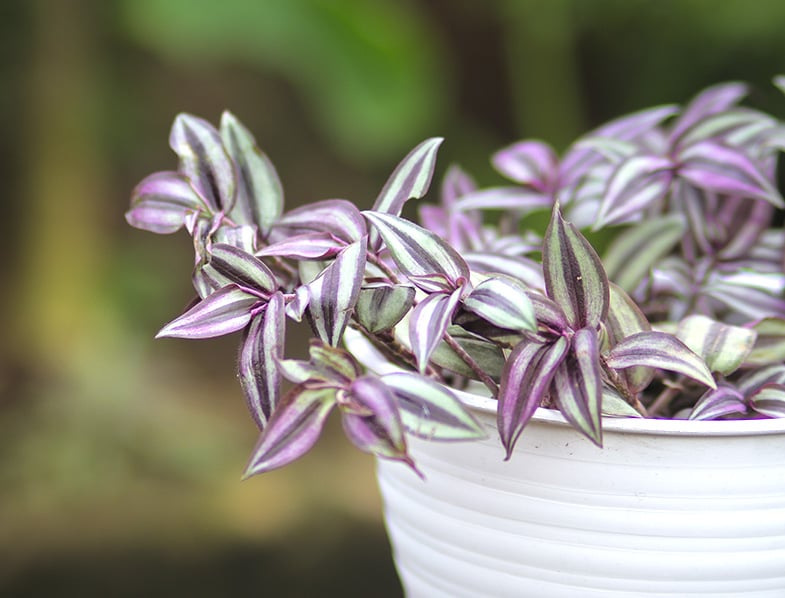
Tradescantia Fluminensis
This wandering Jew species features white flowers, and it’s a trendy indoor plant around the world. The species originates from the southeastern region of Brazil. It’s an evergreen perennial plant that flowers all-year-round and lasts for many years if the owner takes care of it correctly.
The oval-shaped foliage of the Fluminensis is green in color and has a glossy look. The leaves attach to fleshy stems, and the stem nodes quickly put roots down into the soil, allowing for the rapid spread and growth of the plant in ideal growing conditions.
When the plant flowers , it produces a set of flowers with three white petals. The flowers don’t bear any seeds, and they might also emerge in clusters. There are various sub-species of this plant as well, and some types, such as variegate, feature different leaf colors, such as yellow or cream streaks in the leaves.
The plant does best in USDA zones 9 to 12, as it loves the additional humidity in these regions as well. The wandering Jew doesn’t do well in colder climates, so stick to planting in the southern states.
The wandering Jew also prefers full sunlight during the day, and you’ll need to feed it a reasonable amount of water throughout the week. The plant doesn’t enjoy being dry for long periods.
Tradescantia Pallida
This variety originates in Mexico, and it’s the most attractive of the three Tradescantia genus. This wandering Jew produces long, pointy leaves that can reach lengths of 7-inches. The leaf will eventually turn a purple color, but the tips might remain red or green during the color transition.
There are visible segmentations on the stem of this wandering Jew, and it’s for this reason that many countries classify this plant as invasive.
The segments break easily, but they root readily, evolving into two plants with little care. Fortunately, for fans of the plant, it also makes it easy to grow the plants for cuttings as well.
Tradescantia pallida don’t like the cold, and it will die back in colder environments in the Northern states, especially if it grows outside. This wandering Jew produces small flowers that bloom in colors of pink, lavender, and white. The flowers feature three petals, and while they aren’t show-stopping, then do add a beautiful aesthetic to the plant.

- shipped in inproved box to save the plant

Last update on 2024-02-01 / Affiliate links / Images from Amazon Product Advertising API
Natural Air Cleaners
One of the reasons why the wandering Jew is such a popular house plant is its natural air-cleaning properties. The wandering Jew is an excellent “air scrubber,” and it removes bacteria and VOCs from the air inside your home, exchanging it for fresh air that enhances your home.
Some research also shows that the wandering Jew can assist in soil remediation, as well. The plant can remove heavy metals from the soil, helping restore the root health of other plants in the same flowerbed or pot.
Caring for Your Wandering Jew Plant
All varieties of the wandering Jew are easy to care for, provided that you grow them in the right climate and conditions. As long as the plant receives regular watering and pruning, it will thrive, and you’ll also manage to control the growth as well.
If you plant in a sunny spot in your home, then you can expect your tradescantia to last for many seasons. It’s also important to note that the plant might not flower it in its first season. However, by the third year, you should see plenty of flowers that emerge in the summer months.

As mentioned, the wandering Jew prefers sunny planting locations. The plant prefers later afternoon sun to morning sun, but it does well in any sunny area around the home. The more light you give the plant, the more flowers it produces in the flowering season.
If your wandering Jew does not get sufficient sunlight, you’ll notice that the color of the leaves starts to fade. Move the plant to a sunny spot, and it should recover in less than a week.
The wandering Jew enjoys a balanced moisture level in its soil . Don’t let the earth get too dry, as it might cause burning in the tips of the leaves. Likewise, the wandering Jew does not enjoy excessively wet soil either. The plant is susceptible to forming root rot if you “keep its feet wet.”
To check if it’s time to water your wandering Jew, push your finger about 1-inch into the soil. If it feels dry, then give your plant some water.
You must ensure you use a rich, loamy soil that drains well when planting your wandering Jew. When planting in a pot, make sure you add a layer of gravel at the bottom of the pot to enhance drainage. Add perlite to the soil to assist with drainage as well.
You can get away with using a standard potting mix when planting indoors , and other soil enhancements we recommend you add are the following.
- Coarse sand and perlite for drainage
- Humus or peat
- A light dusting of lime
- A few handfuls of rich organic compost
You want the soil to retain water but still allow optimal drainage.
During the growing season, fertilize your wandering Jew plant using a liquid-based fertilizer product. Make sure that you dilute the fertilizer to 50-percent strength.
Strong concentrations can result in burning in the tips of the leaves of the plant. You can also add a granular slow-release fertilizer to the soil once a year at the start of spring.
The wandering Jew grows quickly, and it might take over its pot in one or two seasons, depending on the size of the container. Therefore, you’ll need to pull up the plant and divide it from year-to-year, depending on its growth rate.
If you choose to re-pot your plant, make sure you use a pot that’s at least 50-percent larger than the old one. Line the pot with potting soil and a few handfuls of rich organic compost. Dig around the edges of the existing container to loosen the root ball. After loosening, pull the base of the plant to release it from the pot.
Move the plant to its new pot, and then fill with potting mix to cover the roots — Pat down the soil, and then water lightly.
Wandering Jew plants require regular pruning . The plant grows quickly, and if you don’t prune, then it can overtake the pot fast. Pruning also helps the stem, from getting “leggy,” meaning that the plant starts to look bare at the base. Pruning keeps the plant healthy and growing at an optimal rate.
All; you need to do is prune back any stems and pinch the stem tips. The wandering Jew will then send out two new shoots from the pinched top, helping your plant spread out into a bush-like appearance.
Propagation
The wandering Jew is easy to propagate . This plant grows quickly in a variety of conditions, which is one of the reasons why most countries list it as invasive. You can propagate your cuttings after your pruning session, without much effort.
Remove all of the leaves but the top set after pruning the stem. Place the cutting in another smaller pot with moist potting soil . Leave the container in the sun, and you should find that the cutting roots in a month.
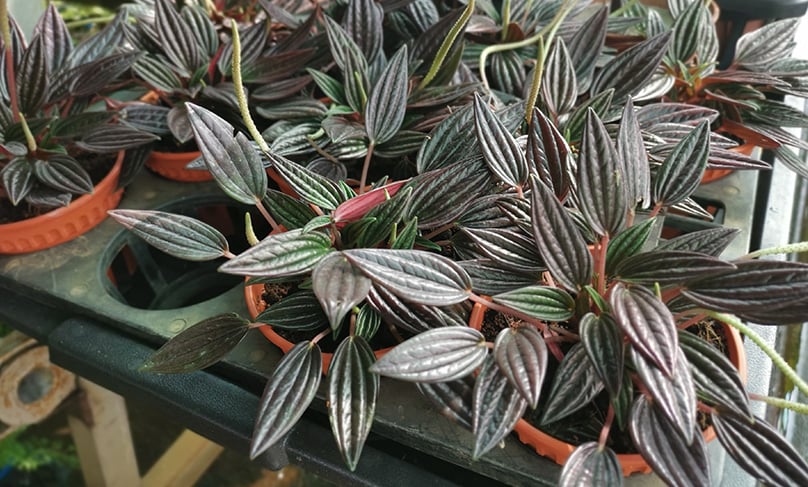
Being an indoor plant , the wandering Jew does not get much attention from pests. However, spider mites can be a problem for your plant if you don’t take care of it and watch for the presence of pests.
Spider mites are tiny spider-like bugs that form a web around the inside of the leaves of the plant. If left unmanaged and untreated, they might start to cause yellow spots in the foliage. The wandering Jew might also fail to flower in the summer months as well.
Over-watering your wandering Jew plant can result in the onset of diseases like root rot. Ensure that you have a well-draining soil mix before planting your wandering Jew. Provided that you do everything you can to ensure your soil drains well, you should never have a problem with root rot in your wandering Jew plant.
Wandering Jew Plants FAQS
What is the best way to grow a wandering jew plant.
The best way to grow a Wandering Jew plant involves placing it in a location that gets plenty of sunlight, preferably late afternoon sun. You should use well-draining, loamy soil to plant it, and ensure a balanced moisture level by watering it regularly but not excessively. The plant also appreciates humidity and occasional fertilizing with a liquid-based fertilizer diluted to 50% strength during the growing season. Pruning should be done regularly to manage its growth.
Is Wandering Jew easy to grow?
A: Yes, Wandering Jew plants are generally easy to grow. They adapt well to various conditions and are fast-growing. They can be propagated easily from cuttings and require minimal maintenance beyond regular watering, pruning, and an occasional application of fertilizer. However, they do not tolerate cold climates very well.
Does wandering Jew like full sun or shade?
Wandering Jew plants prefer locations with full sunlight. They can tolerate some shade but too much shade can cause the color of the leaves to fade. More sunlight exposure generally leads to more flowers during the flowering season.
How often do you water Wandering Jew?
Wandering Jew plants should be watered regularly to maintain a balanced moisture level in the soil. However, the soil should not be allowed to become too dry or too wet. Overwatering can lead to root rot. A good way to check if it’s time to water is to push your finger about 1-inch into the soil. If it feels dry, it’s time to water the plant.
Is Tradescantia Zebrina easy to grow?
Yes, Tradescantia Zebrina, a variety of Wandering Jew, is easy to grow. It requires similar care to other Wandering Jew varieties and is known for its adaptability and quick growth.
Does Tradescantia Zebrina need full sun?
Tradescantia Zebrina does best in a location with full sunlight. While it can tolerate some shade, insufficient sunlight can cause the leaves to lose their vibrant color. Like other Wandering Jew plants, the more light it gets, the more flowers it produces during its flowering season.

Hollie is a life-long gardener, having started helping her Dad work on their yard when she was just 5. Since then she has gone on to develop a passion for growing vegetables & fruit in her garden. She has an affinity with nature and loves to share her knowledge gained over a lifetime with readers online. Hollie has written for a number of publications and is now the resident garden blogger here at GardenBeast. Contact her at [email protected] or follow on twitter https://twitter.com/greenholliec
Pampas Grass Guide: How to Plant & Care for “Cortaderia Selloana”
Rhaphidophora tetrasperma guide: how to grow & care for “mini monstera”, corn plant guide: how to grow & care for “dracaena fragrans”.
under the photo “easy to propagate”, that is not a wandering jew-its a peperomia “rosso!”
My wandering jew plants leafs are getting dried. Why is that?
It’s not getting enough humidity
Could you elaborate on “rich organic compost”? What should it be made of, exactly? Can I use compost accelerator in the soil mix?
Worm castings are great, or worm tea, egg shell tea is another.
What month does the jew break ground to start growing?
All depends on your specific areas weather pattern and seasons.
Do NOT BUY ANY OF THIS SPECIES if you have a dog because dogs are very allergic to these plants & come out in bad rashes if they wander through them!
Leave A Reply Cancel Reply
Save my name, email, and website in this browser for the next time I comment.
Type above and press Enter to search. Press Esc to cancel.
- Privacy Policy

- Houseplants
- Gardening And Landscaping
Wandering Jew Plant (Tradescantia or Spiderwort): Care, Types, Images and More
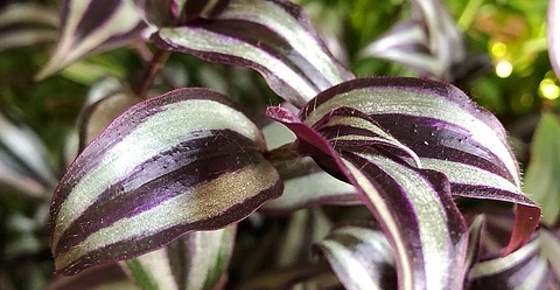
The wandering Jew plant is a common name for different species of plants that belong to the Tradescantia genus. There are around 75 different types of plants in Tradescantia genus and some are called inch plants, spiderwort, striped wandering Jew, Boat Lily, Purple Queen, or flowering inch plant. Wandering Jew plants are great house plants because they are relatively easy to care for. They are also easy to grow because the wandering Jew plant propagates easily from cuttings.
Some types of wandering Jew plants have green and gold leaves, some have reddish leaves, and others have green fuzzy leaves. There are also types of wandering Jew plants that flower. Depending on the species, the wandering Jew plant could have purple, white, or pink flowers.
How to care for wandering Jew plant : For the Tradescantia or spiderwort plant to thrive, grow in a plenty of indirect light and plant in fertile, moist potting soil with good drainage. Make sure the soil isn’t too dry or too damp and keep medium humidity levels. The ideal temperature range is between 65°F (18°C) and 75°F (23°C). You can fertilize every four weeks during the growing season with a diluted liquid houseplant fertilizer.
In this article, you will find all you need to know about this delightful houseplant. You will also get tips and ideas on how to care for your wandering Jew plants.
Wandering Jew Plant (Tradescantia or Spiderwort) – Overview of the Plant and Its Flowers
The botanical name for wandering Jew plant is Tradescantia zebrina and is also called the inch plant. However, the name wandering Jew is given to many herbaceous perennial plants in the Tradescantia genus. ( 1 )
Species of Tradescantias naturally grow outdoors in countries in Asia, Africa, Central and South America, and Australia. Varieties of wandering Jew plants also thrive well indoors, where, like their garden varieties, they grow well when it is warm, sunny, and moderately humid.
According to the United States Department of Agriculture, various varieties of Tradescantias are regarded as invasive plants in the wild. However, it is the fast-growing nature of spiderworts, wandering Jews, and inch plants that makes them perfect houseplants. ( 2 )
Many people like to grow wandering Jews or spiderworts in hanging baskets or grow them in pots to decorate a garden.
What does a wandering Jew look like?
Plants from the Tradescantia varieties have leaves that seem to grow in all directions (hence the term “wandering Jew”).
One of the distinct features about foliage on wandering Jews is that many of them have striped leaves. Sometimes, the leaves can be purple and silver stripes, whereas other types of Tradescantias have leaves that are almost all silver. ( 3 )
You may also notice that some varieties of wandering Jew plant have different colors on the underneath of the leaf. For example, the Tradescantia zebrina has green/silver leaves on the upper side and deep red or burgundy colors on the underside.
Wandering Jew flower
Wandering Jew houseplants also produce attractive flowers. These flowers can sometimes be white or can range in color from pink to various shades of lilac and purple. ( 3 )
However, plant lovers don’t usually grow wandering Jews indoors or outdoors for their blooms. It’s the beautiful variation of leaf colors that makes various types of Tradescantias so desirable houseplants.
Types of Wandering Jew (Spiderwort) Plants
The most popular types of Tradescantia plants to keep indoors are Tradescantia fluminensis ( spiderwort ), Tradescantia pallida ( purple heart ), and Tradescantia zebrina ( wandering Jew ).
Wandering Jew or inch plant ( Tradescantia zebrina )
This type of wandering Jew houseplant has purple and green leaves with a stripe pattern that resembles zebra’s stripes. There are types of wandering Jews that have bluish green leaves and purple hues on the underside.
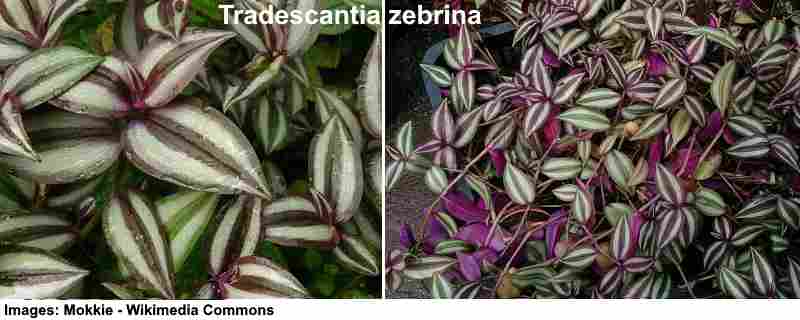
Tradescantia fluminensis (spiderwort)
There are a number of types of Tradescantia that are called spiderwort. This is distinguished from some Tradescantias as it has ovel shiny dark green leaves with pointed tips which are slightly fleshy .
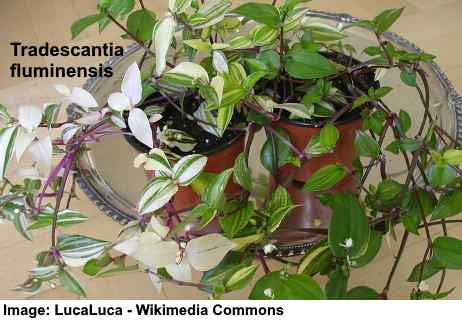
Picture of wandering Jew plant with white flowers
Tradescantia pallida (purple heart)
This type of spiderwort plant is also commonly referred to as wandering Jew. The T. pallida houseplants have vibrant purple leaves and light pink flowers when they bloom.
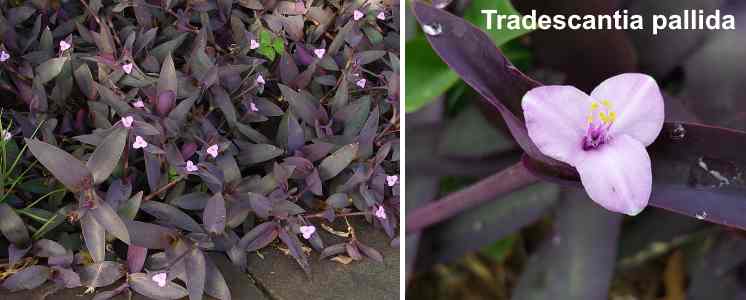
Wandering jew plant with deep purple leaves and light purplish-pink flowers
Tradescantia callisia
The leaves of T. callisia varieties are sometimes referred to as creeping inch plants. They have remarkably stripy leaves made up of green and white stripes.
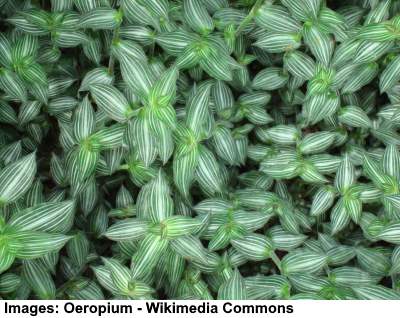
Picture of green wandering jew
Wandering Jew Plant Care (How to Grow Spiderwort or Tradescantia)
Caring for wandering Jew plants is fairly simple and straightforward. All plants in the Tradescantia genus enjoy moist soil, sunny but indirect sunlight, and warm conditions.
So, it doesn’t matter if you have fuzzy leaf Tradescantias, purple queen varieties, spiderworts, or wandering Jews, they all require the same type of care.
Light requirements for Tradescantias
To make sure that wandering Jew plants grow successfully, they require a good amount of light. This ensures that they grow with healthy leaves that have a vibrant green, silver, purple, or lilac colors.
The best place to place wandering Jew plant or spiderworts is in an east- or west-facing location. This means that they get plenty of natural light without being in direct sunlight when the sun is at its strongest.
The only exception is if you have Tradescantia pallida plants with dark purples leaves. They usually thrive in direct sunlight, although you should regularly check them in the summertime to make sure the sun isn’t too strong.
One sign that your Tradescantia isn’t getting enough light is if the color of their leaves starts to fade.
Best growing temperature for Spiderwort or Tradescantia
One of the reasons why wandering Jew plants are good for the home is that they thrive in room temperature.
The best temperatures for growing any type of Tradescantia plant is between 65°F (18°C) and 75°F (23°C). The houseplants also thrive in conditions that are described as “average humidity.”
If you grow Tradescantias outdoors, you should be aware of a drop in night temperatures and lower temperatures during winter. You should bring Tradescantias indoors if the temperature drops.
Best watering techniques for wandering Jew plant care
To care for your inch plant, spiderwort, or wandering Jew, you should keep the soil moist.
The best way to water a wandering Jew is to water the soil thoroughly and let the water drain out the bottom. Another way to water your purple house plant is to put water in the plant pot tray and allow the plant to soak up as much as it needs.
Some beginners who start caring for houseplants such as Tradescantias for the first time buy a soil moisture gauge to help get the soil moisture levels just right.
When it comes to proper watering for your wandering Jew, always make sure the soil isn’t too dry or too damp. Usually, weekly watering in the summertime is enough to keep your Tradescantia growing well.
The best fertilizer for wandering Jew houseplants
The reason why Tradescantias are so easy to care for is that they don’t usually require any feeding.
If you decide to encourage your inch plant or spiderwort to grow faster, then choose a liquid organic fertilizer mixed at half strength and use once a month.
Most houseplant growers don’t feed their wandering Jew plants in the fall or winter as they tend to become “leggy” or “straggly.”
Which type of soil to use for Tradescantias
To properly care for wandering Jew varieties of houseplants, you only need to plant them in regular potting soil.
How to prune wandering Jew plants
In time, Tradescantia plants require some cutting back and pruning. This helps to give your houseplant a bushier appearance and also gives you plenty of cuttings to propagate.
For Tradescantia pruning, you just need to pinch off the stem tips to leave about ¾ of the length. This will encourage your plant to grow better and become more attractive.
Growing Plants from Wandering Jew Cuttings
Even for the most novice of houseplant owners, propagating any type of Tradescantia plant is very easy. After you have cut back your “leggy” wandering Jew stems, you will have a large number of cuttings that you can use to grow new house plants.
How to propagate wandering Jew plant leaves
To prepare your wandering Jew cuttings or purple heart plant cuttings for propagation, you need a couple of stems about 1-2 inches long. Remove all the leaves apart from 2 or 3 at the end of the stem.
There are 2 ways you can grow wandering Jew plants from cutting:
- The first way is to just put a cutting in potting soil and wait for it to grow. All you have to do is make sure that the soil is kept moist and not overly damp.
- The other way to grow a Tradescantia from a cutting is to put the stem in water. You should notice that new roots start to grow within a week. When you notice new roots growing, you can transfer your cuttings to a pot to grow a new houseplant.
Wandering Jew Outdoor Plant Care
Tradescantia plants are great garden plants and grow well outdoors in warmer zones in the U.S. (USDA growing zones 9-11). In fact, it is because they grow so well outside in warmer countries and are quite invasive that they are classed as a weed in certain countries.
You can easily care for any Tradescantia plants to add color and beauty to your garden. Purple hanging plants or wandering Jew vines with stripy leaves can grace any patio, doorway, or garden area.
As with caring for wandering Jews or spiderworts indoors, Tradescantia plants growing outdoor should be protected from direct sunlight. So, place your plants in shady areas of the garden. But it’s good to remember that some bright light will help the wandering Jew plant produce more flowers.
Temperature
Also, frost can damage the plant, so, if you live in areas where fall and winter temperatures drop below 10°F (12°C), you should take them indoor and continue to grow them as houseplants.
Problems with Wandering Jew Plant (Spiderwort)
Even though it is relatively easy to care for wandering Jew plants, you can still come across certain problems.
Let’s look at some growing tips for Tradescantia plants to avoid or remedy some common problems.
The most common pest when growing wandering Jews indoors are bugs such as spider mites or aphids . The appearance of these pests on your bushy spiderwort or inch plant may be a sign that conditions are too dry.
To help remedy the problems of pests on your Tradescantia, mist the leaves regularly and make sure the soil is moist enough. You may need to wash off the mites with water to help get rid of the infestation.
One of the beauties about caring for wandering Jew plants indoors or outdoors is that they are not susceptible to disease. Usually, any discoloration of the leaves or poor growth is connected to the soil being too dry or too damp.
Fungal infections
Overwatering spiderworts, inch plants, or wandering Jews can cause a fungal growth called botrytis to develop in the roots.
Brown leaves
As with most problems associated with caring for Tradescantias, brown leaves can also indicate that the growing environment isn’t right. The leaves of your wandering Jew could have turned brown because of too much or too little sunlight. Also, too much watering can affect leaf health.
Where to Buy Wandering Jew Plants
Many garden centers and online stores stock many different varieties of wandering Jews. You will also find that Tradescantia cuttings are available online.
Because many different types of wandering Jews are so easy to grow yourself, you could ask a friend for a cutting if they have the plant. You can also get more Tradescantia houseplant or garden plants by propagating cuttings from plants you already have.
FAQ Related to Wandering Jew Plant (Tradescantia)
Do they need any pruning.
To properly care for wandering Jews, the leaves and stems require pruning. The stems can grow quite long and start losing their leaves from the base. The best time to prune any Tradescantia plant is just before the growing season in late winter or early spring.
You may also find that Tradescantias grow better if you give them a mild prune in late summer.
How to prevent wandering Jew roots from rotting?
Go easy on the watering to stop Tradescantia plants’ roots from rotting. Water them enough to keep the soil moist during summertime and only occasionally in the winter.
Are wandering Jew plant leaves toxic to animals?
While not toxic to cats or dogs, the leaves of wandering Jew plants can cause irritation. If you have pets that like to nibble on leaves, you can still benefit from the beauty of Tradescantias if you grow the outdoor plant in hanging baskets.
Can I grow my Tradescantia plant outdoors?
Yes, you certainly can. Wandering Jew plants grow well out of doors in warm climates. During the summertime, you can move your indoor houseplants to the garden and place them away from direct sunlight.
Dashes of purple colors, bright pinks, or interesting green and purple stripped leaves can make an interesting feature in any garden or balcony.
Can you train a wandering Jew plant?
Tradescantia plants are easy to train because their stems can grow very long and you can wrap them around objects. Wandering Jew plant stems can grow up on trellises or obelisks or up around any other item.
Heavily pruning wandering Jews in late winter can also help to train the plant to grow into a colorful bush.
How fast does wandering Jew plant grow?
Tradescantia cuttings should start growing roots within a week or so. Once the plant is established, you can expect it to grow about an inch every week. Some people claim this is the reason that some Tradescantias are called inch plants.
Can Tradescantia houseplants cause allergies?
The sap of wandering Jew plants or prolonged skin exposure to its leaves could cause allergic reactions.
The journal Allergy reports that indoor plants such as Tradescantia can also cause symptoms such as itching of the throat, swelling, wheezing, and runny eyes and nose. ( 4 )
Do wandering Jew varieties have any health benefits?
Although not widely used, extracts from Tradescantia zebrina have certain medicinal properties. You can buy inch plant herbal liquid extracts that are said to have many antioxidant properties.
Researchers have found that therapeutic compounds in Tradescantia extracts have antibacterial, anticancer, and antioxidant uses. ( 5 )
Related articles:
- Moses In Cradle Care: How to Grow Tradescantia spathacea
- Chinese Money Plant Care: How to Grow Pilea Peperomioides
- Dracaena Marginata Plant Care: How to Grow Madagascar Dragon Tree
Grow. Play. Every Day!

- House & Home
- Houseplants
Wandering Jew Plant Care: Complete Growing Guide for Tradescantia Zebrina (Inch Plant)
Tradescantia zebrina (commonly known as wandering Jew, spiderwort, or inch plant) is popular for a reason: This beginner-friendly houseplant is low-maintenance and grows quickly. It’s also super easy to propagate more plants so you can fill your home with more of the colorful striped foliage the species is known for.
Written by Linda Ly

When it comes to vigorous, colorful, and easy-to-grow hanging houseplants, there aren’t many that can compare to Tradescantia zebrina (known more commonly as wandering Jew—and I’ll touch on the history of that name below). Whether you’re a houseplant beginner or a veteran, most indoor gardeners have owned one of these potted plants at some point.
Keep reading for everything you need to know about Tradescantia zebrina and growing this stunning houseplant in your own home.
Disclosure: If you shop from my article or make a purchase through one of my links, I may receive commissions on some of the products I recommend.

About inch plants
Natural habitat.
Tradescantia zebrina is a native of Central and South America, from Mexico down to Colombia, as well as the Caribbean. Here, it forms part of the undergrowth in lightly forested and often very moist areas. It can form very dense, wide mats thanks to its creeping growth pattern and ability to throw roots extremely quickly.
Unfortunately, its vigorous growth has also made Tradescantia zebrina an invasive plant in some regions. This includes Hawaii, Brazil, and Australia, where the species easily takes hold in moist, forested areas.
As a 2019 study carried out in the Brazilian Atlantic Rainforest notes, this is problematic due to the species choking out native plants.
Some of the above was caused by careless gardeners allowing bits of the plant to get into the wild, where they quickly root. If you’d like to grow spiderworts like this one in your garden, please make sure to dispose properly of any trimmings left after pruning!
This also applies to zebrina’s popular cousins, like Tradescantia fluminensis, T. pallida, and T. spathacea.
Description
It’s not difficult to see why Tradescantia zebrina gained popularity as a houseplant. Wandering spiderwort plants (not to be confused with spider plants , another beginner-friendly species) are low-maintenance and grow just about anywhere—they even just grow in water !
Easy care and quick growth aside, spiderworts are also just good-looking plants. The pointed, oval leaves on thin, fleshy stems overlap slightly and are characterized by their zebra pattern in purple and silvery green. The leaf undersides are deep purple in color and the tiny, three-petaled flowers are bright pink.
Although this species is naturally a creeping plant, it’s often grown indoors in hanging planters. As long as the plant is provided with enough light, the foliage will be very dense and brightly colored, forming a spectacular waterfall that can reach more than 3 feet in length.
What’s in a name? In the case of common houseplants, sometimes a lot.
Tradescantia zebrina is a classic houseplant (I found mention of it in a 1964 German book about houseplants, but it’s probably been around longer than that!) and among most English speakers, it has long been known as wandering Jew. This is probably a reference to the “wandering” nature of the plant, as it does have a creeping growth pattern.
The legend of the wandering Jew is hundreds of years old and is now commonly considered to be rooted in antisemitism. It describes a Jewish man cursed to walk the planet until the Second Coming because he taunted Jesus on his way to the cross.
Because of this, the plant name has partly fallen out of fashion and has been the source of much debate in the plant world over the past few years.
Some plant enthusiasts have embraced the alternative “wandering dude,” which I personally think is a great option.
“Inch plant” (houseplant enthusiasts don’t agree on whether this refers to the fact that it can grow an inch a day, or that you only need an inch of stem to propagate it), “spiderwort,” or “wandering spiderwort” are also popular alternatives, though these are common names for other Tradescantia varieties, such as Tradescantia Nanouk.
The best way to avoid any confusion is to just stick to the scientific name.

Inch plant varieties
There are three subspecies of inch plant (wandering Jew): Tradescantia zebrina var. zebrina, var. flocculosa, and var. mollipila. Unsurprisingly, after it having been a popular houseplant for so many years, nurseries have also managed to create a whole bunch of cultivars through selective cultivation.
A few of the popular Tradescantia zebrina cultivars you may come across in your local plant store include, but are certainly not limited to:
- Tradescantia zebrina ‘Quadricolor’: Yep, as the name suggests, this one adds an extra color to the mix. The leaves are cream, pink-purple, light green, and dark green.
- Tradescantia zebrina ‘Burgundy’: Characterized by its very dark purple coloration.
- Tradescantia zebrina ‘Silver Plus’: Less purple, more shiny silver.
- Tradescantia zebrina ‘Red Gem’: Less silver, more intense (light) purple.
- Tradescantia zebrina ‘Purple Joy’: Less silver, more dark purple.
- Tradescantia zebrina ‘Tikal’: A rare, naturally occurring variety that collectors pay a pretty penny for.
Do keep in mind that most of these cultivars aren’t patented and the amount of mislabeling and variation within a cultivar are both huge. Just growing your wandering Jew in lower-light conditions can completely change the way it looks, so it’s not surprising that confusion sometimes reigns supreme.
Luckily, care is the same across all cultivars, so your best bet is to just enjoy your plant even if you’re not sure what Tradescantia variety you’re dealing with!
Where to buy wandering Jew plants:
- California Tropicals
- Daylily Nursery
- The Green Escape

Caring for an inch plant
Light and temperature.
It’s important to provide your Tradescantia zebrina with enough light. It’s tempting to use plants to brighten up dark, shaded spots in your home, but that just doesn’t work with this one: It loses its dense growth pattern and beautiful coloration in low light.
To prevent your wandering dude plant from growing sparse and green, place it near a window that gets bright indirect light. Some full sun isn’t a problem either, but do make sure you acclimate it gradually to a higher light location.
Temperature-wise, this species is a lot hardier than many of the tender tropicals we like to grow in our homes (like Anthurium andraeanum and Begonia maculata ).
Wandering dude plants can handle a very wide range of temps, making it perfect for those chillier windowsills that your other plants may not appreciate. Room temperature is ideal, but anything between 50°F to 85°F will keep them happy.
Water and humidity
Your Tradescantia zebrina will appreciate lightly moist soil. You can water a bit more during the summer months, when the plant is actively growing and needs a lot of moisture, and less during winter, when soil tends to take significantly longer to dry.
If you’re not sure whether it’s time to water your wandering Jew plant yet, you can always turn to the age-old trick of sticking a finger in the soil.
- If it still feels damp, wait a little longer, until the first inch or two has dried.
- If it feels bone dry, you’ve waited too long; you may also see limp leaves on your plant at this point. It’ll bounce back, but not always without lasting damage.
- If the soil feels wet, you watered too much and need to keep an eye out for root rot.
As for humidity, given its rather wet natural habitat, wandering Jew does appreciate higher air moisture levels. The great thing is, though, that it doesn’t demand it. As long as you keep its soil lightly moist and the air isn’t extremely dry, your plant should do well.

Soil and planting
Wandering Jew is not fussy about its potting mixture at all. I’ve grown it in pure houseplant potting soil with no additives. If you do want to take things to the next level, you can add some perlite and/or peat moss, although this is really not a must.
Most houseplant enthusiasts like to place their wandering Jew in a hanging planter so they can enjoy the look of the leaves cascading down. This is not a must, though. You can also emphasize the species’ creeping growth habit by filling up a large, shallow planter, growing it in a terrarium, or even keeping it in water on a semi-permanent basis.
Recommended products for wandering Jew plant care:
- FoxFarm Ocean Forest Potting Soil
- Espoma Organic Potting Mix
- Perfect Plants Organic Perlite
Fertilizing
Like most other houseplants, Tradescantia zebrina appreciates a bit of fertilizer during the growing season, which extends from spring to early fall. You can use a normal houseplant fertilizer according to the instructions on the bottle.
Don’t fertilize during the winter months unless your plant is growing well. It doesn’t need extra nutrients if it’s inactive.
Recommended fertilizers for wandering Jew plants:
- Houseplant Resource Center Liquid Fertilizer for Houseplants
- Instant Biologics Instant Plant Food (Fizzing Nutrient Tablets)
- Maxsea All-Purpose Seaweed Plant Food
Pruning
There’s a good chance you’ll have to prune your Tradescantia zebrina regularly, because as I mentioned, this is a very quick grower. It also roots very easily, so any trimmings can be replanted! I’ll describe how to do this in the section on propagation below.
Aside from stem trimming, you can remove any dead leaves, which are bound to pop up from time to time in very dense plants like this species.
Dividing or repotting
Inch plants don’t grow by producing plantlets at their base like many other houseplants (such as spider plants ) do. Instead, inch plants spread by rooting along the stems.
This means that division is not really the way to go; keeping these plants manageable is usually done through pruning. You can shape your plant by pinching off any long, leggy stems to create a fuller appearance and control its spread.
You’ll notice that Tradescantia really doesn’t mind being a bit cramped in its planter. Still, it’s a good idea to provide your plant with some fresh soil every year or two by repotting it.

Propagating an inch plant
If you’ve never propagated a houseplant before, this is truly one of the best species to start with. It’s known for rooting extremely quickly in both water and soil, meaning it’s easy to fill endless planters to keep or give away.
All you need to propagate your Tradescantia zebrina is a pair of clean scissors. Here’s how you do it:
- Snip the ends off existing branches. An inch or two with a few leaves works best.
- Remove the leaves at the bottom so part of the stem is exposed.
- Place the cutting in a glass of water to root or plant it directly in soil. You can put cuttings back in the mother plant’s pot to give her a fuller appearance on top.
- It can take a little longer during the winter months, but the first roots should appear within a week or so. You can give soil cuttings a slight tug to verify they’ve rooted.
- Once the first signs of new foliage appear, you’ll know your propagation attempt has been a success!
- If you propagated in water, you can leave the rooted cuttings in water almost indefinitely, although you can also pot them up in fresh soil.

Common questions about inch plant care
How do i make a wandering jew plant bushy.
By their very nature, wandering Jew plants are not bushy. Their creeping growth habit means they naturally grow leggy over time, especially in containers.
However, you can mimic a fuller appearance by strategically pinching off any long, spindly stems to shape the plant more. These stems can also be replanted near the mother plant.
As the baby plants grow, they’ll help fill in sparse areas and create the illusion of a bushy wandering Jew.
How long do wandering Jew plants live?
Wandering Jew plants have a limited lifespan of just a few years, and as a potted plant, you’ll notice your wandering Jew becoming very leggy after just two to three years.
Unlike other fast-growing plants that benefit from pruning, cutting back a wandering Jew doesn’t work well to renew its growth; it simply controls the spread.
The best way to keep your plant coming back year after year is to propagate new plants from stem cuttings, which—fortunately—is super easy with a high success rate.
Is wandering Jew perennial?
Wandering Jew (Tradescantia zebrina) is a trailing evergreen perennial in its native habitat (USDA hardiness zones 9 through 12). Where it’s not winter hardy, wandering Jew is grown year-round as a houseplant.
Are wandering Jew plants toxic to cats and dogs?
Wandering Jew is not considered outright toxic, but it can cause some skin irritation. If your pet gets into your plant, don’t worry too much, although it can be a good idea to have a look in its mouth to make sure there’s no excessive swelling. Be sure to offer water. To prevent skin rash, it can be a good idea to wear gloves if you need to handle your wandering Jew plant. This especially applies if you have sensitive skin.
https://www.cabi.org/isc/datasheet/110354
Racism in Taxonomy: What’s in a Name?
Chiba de Castro, W. A., Xavier, R. O., Garrido, F. H., Romero, J. H., Peres, C. K., & da Luz, R. C. (2019). Fraying around the edges: negative effects of the invasive Tradescantia zebrina Hort. ex Bosse (Commelinaceae) on tree regeneration in the Atlantic Forest under different competitive and environmental conditions. Journal of Plant Ecology, 12(4), 713-721.
Encke, F. (1964). Pflanzen fur Zimmer und Balkon; Auswahl, Pflege, Vermehrung.
I'm a plant lover, passionate road-tripper, and cookbook author whose expert advice and bestselling books have been featured in Time, Outside, HGTV, and Food & Wine. The National Parks Cookbook is my latest book. Garden Betty is where I write about modern homesteading, farm-to-table cooking, and outdoor adventuring—all that encompass a life well-lived outdoors. After all, the secret to a good life is... Read more »
We bought a full grown Bolivian Jewel mid summer last year. It was in a 14” raised pot and flowing 2 foot over the sides. It was beautiful next to our fountain outside. We live in Minnesota so we had to discard it in the late fall since we had no place to care for it in the house. Since we can’t find another like it we’d like to plant one from scratch but how. We still have the pot and riser but have no idea how to start from that. One plant, a few or just how many to make a bushy over grown plant so it looks like the one we purchased last year. Does this make sense or should we just forget it since it is already the middle of May. The greenhouse that we bought it from last summer doesn’t have any this year, just small ones in 4” pots. Thanks
If you can only grow it as an annual (and won’t be overwintering it indoors), you can plant a few smaller ones together to make them look fuller as they grow.
It seems counterproductive to talk about the problematic origin of the name wandering Jew, recommend multiple alternative names (including scientific), but then continue to call it wandering Jew in the rest of the article. If the name is anti-Semitic just set a good example and use a different name.
Leave a Reply Cancel reply
Your email address will not be published. All fields are required.
Save my name and email in this browser for the next time I comment.
This site uses Akismet to reduce spam. Learn how your comment data is processed .
Recommended Reads
- Garden of eatin’

The No-Dig Garden Method: Make Amazing Soil With Less Work

Solarizing Your Garden: How to Use the Sun to Control Weeds and Pests in the Soil

How to Plant a Three Sisters Garden: The Original Companion Plants

[Chart] How Much to Plant for a Year’s Worth of Food

What You Should Know Before Buying Land (My Real-Life Tips)

Construction Loans: What I Wish I’d Known As a First-Time Borrower

Dark Room? 9 Actually Low-Light Plants That Don’t Need a Lot of Sun

Getting Rid of Fungus Gnats: 11 Remedies That Really Work

My Favorite Ruby Red Sauerkraut Recipe (and Why It’s So Good For You)

How to Make Nukadoko (Fermented Rice Bran Bed) for Pickling

Easy 4-Ingredient Colorful Homemade Pasta—No Pasta Maker Needed

The Best Homemade Limoncello
Subscribe to my newsletter.
Get my best secrets, practical tips, useful resources, and real stories from my own experiences.
- About Linda Ly
- What’s In My Garden
- Lazy Gardening Academy
- Sponsorships
- Site Policies

Back to the top
Disclosure: Garden Betty independently selects products to feature on this site. I may receive a commission when you buy something through one of my links. As an Amazon Associate, I earn from qualifying purchases.
© 2024 Garden Betty. All Rights Reserved.


Wandering Jew Plant (Tradescantia zebrina): Types, How to Grow and Care
Sharing is caring!
Plants with trailing and creeping habits are some of the best plants to keep. They are fast-growing and make thick carpet of groundcovers for gardens in no time and they also create striking hanging indoor plants.
Among the all-time best trailers to grow is the wandering jew. Easy to maintain and drapes beautifully, this colored plant will make any space more inviting and interesting.
Medicinal Properties
Propagation and maintenance, what is a wandering jew plant.
Tradescantia is one of the 37 genera under the plant family Commelinaceae (1). Some of its 75 species are commonly called ‘wandering jew’ (also known as inch plant), a name they adapted due to their long lifespan like the Jewish character from a Christian folklore.
Another name for this group of herbaceous perennial plants is ‘spiderwort’ after the spiderweb-like sap they produce when the stem breaks. They are native to Canada, Mexico, and Argentina and have been naturalized in other parts of the world (2).
The most common tradescantia grown ornamentally is the T. zebrina also previously called Zebrina pendula . It has long fleshy stems where the wandering jew plant leaves and roots appear. The lance-like leaves are a mixture of green and purple with silver stripes on the upper side and deep purple under (3). The plant grows close to the ground and can only reach 20 to 30 cm high.
Does Tradescantia Zebrina Flower?
The wandering jew is considered an ornamental plant primarily because of its showy colorful foliage but the plant does produce pink flowers.
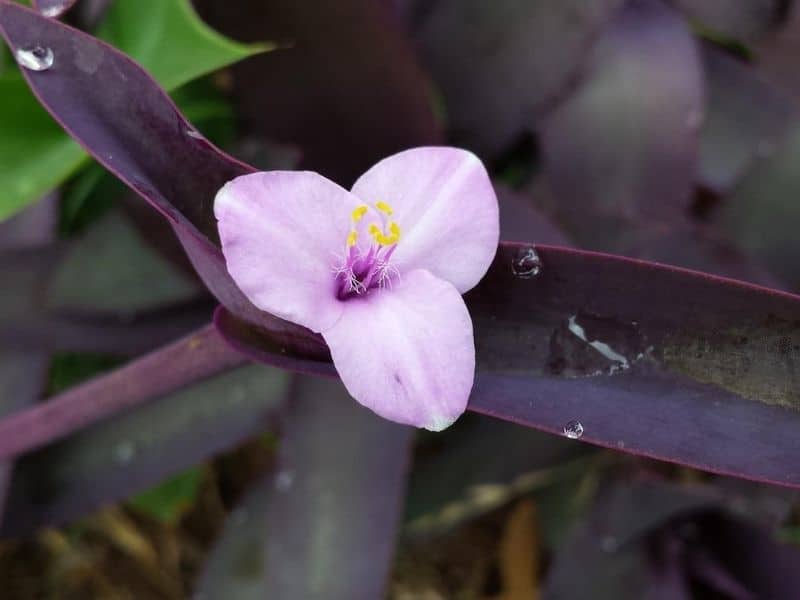
Small three-petaled pinkish purple flowers appear sporadically throughout the year (4). The resulting fruit is a capsule containing tiny brown seeds.
Is it Toxic to Pets?
Spiderworts are normally harmless plants but they contain toxic properties that may cause mild gastric problems and dermatitis to pets. Although they don’t lead to anything serious, it will be safe to keep the plants out of reach of pets and to keep the hands protected when dealing with the sap of the plant.
Because of the plant’s hardiness and adaptability to different environments, the wandering jew establishes well, in fact so well that it can be considered an invasive species. In countries like Australia, the plant has the capacity to invade natural vegetation. Although growing them is not prohibited, everyone is obliged to keep the plant’s growth under control (5).
Studies showed that Tradescantia has significant effects as an anticancer, antioxidant, and antibacterial medicinal plant. In traditional Chinese medicine, the wandering jew plant is highly valued as treatment for kidney failure.
The extract from the whole plant is cooked with dates, ginger, and water and consumed by patients. The plant is also known to treat high blood pressure, cough, urinary tract infection and tuberculosis (1).
How to Grow and Care for a Tradescantia
Here’s how to care for a wandering jew plant, one of the easy house plants to own.
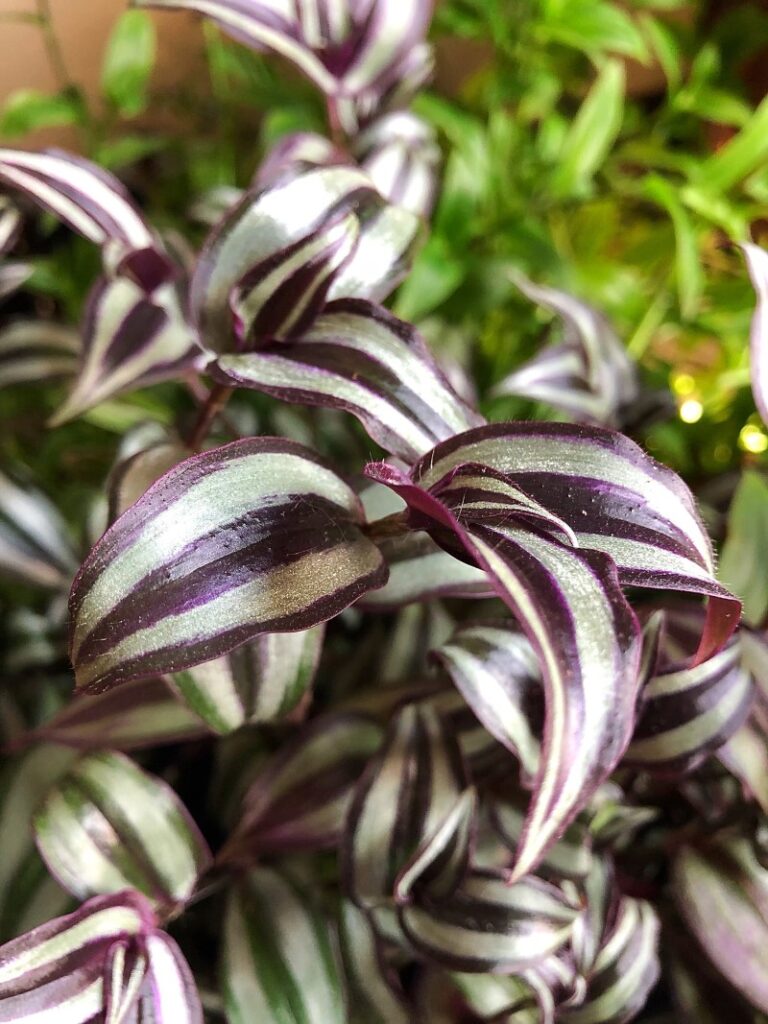
Light and Water
In the wild, the wandering jew plant thrives without assistance but under the right conditions. It likes filtered sun so indoor fluorescent light is enough. Placing them by the window and turning the plant every two weeks will keep the leaves colorful and the growth even on all sides (3).
The plant spreads easily in damp areas that’s why it naturally grows along riverbanks and roadsides. When potted, the soil should be kept moist but well-drained. Saturated soil often causes root rot.
Fertilize your Tradescantia plant once a month during the growing season (spring and summer) with a balanced, water-soluble fertilizer diluted to half strength. Avoid fertilizing in fall and winter when the plant is dormant. Over-fertilizing can lead to fertilizer burn and damage the plant, so follow the instructions on the fertilizer package carefully.
Temperature and Humidity
Spiderworts like it warm but there should be enough air circulation or else the leaves will sag. During the heat of the summer, taking the plant outside under shade will provide the necessary cool to the plant.
Mist the hanging plant early in the morning and late in the afternoon. If the plant is on a table, place a glass of water beneath the leaves or put the pot on a wet pebble tray. This will humidify the immediate vicinity of the plant aiding in its photosynthesis and transpiration processes.
Pests and Diseases
The most common living enemies of the wandering jew are aphids, mealybugs, scale, white flies, and spider mites. Manual removal at the onset of infestation is effective but they should be closely monitored as serious attack may lead to the plant’s death. If left unnoticed and the infestation has become severe, get rid of the plant by burning to avoid contamination.
Since the creeping inch plant is mainly soft almost like a succulent, soggy soil and too wet conditions lead to root and stem rot (4). As long as the plant is receiving just enough moisture, this disease will be avoided.
Propagating wandering jew plants is very easy. They can grow from seeds but will take years to establish so the more convenient stem cutting is best. The trailing or creeping stems form nodules where the roots will eventually grow as it comes in contact with the potting soil (2). When the hanging plant has longer trails than intended, it can be trimmed and the resulting stem cuttings can be rooted to form new plants.
There will be times that the potted wandering jew will become leggy, especially if it’s been receiving more shade. To promote a bushier growth pinch back by literally pinching the tip of the plant where the new growth occurs (4). This practice allows the formation of lateral stems.
In two or three years, these hardy plants may become pot bound, with the roots taking up most of the space in the pot. Repot in a larger container with a good mixture of soil, coarse sand, and compost to replenish the nutrients and provide room for the roots to breathe. Additionally, fertilize once every two months by foliar application just to improve plant vigor.
Common Varieties of Wandering Jew
The oldest and most common indoor wandering jew, this species has leaves alternating, often overlapping when young, purple leaves with silvery green thick stripes and solid purple underside. The stem is also a mixture of purple and green.
T. blossfeldiana
The leaves of this species are quite thicker, glossy, and covered in miniscule hairs called trichomes. The three-petalled flower is an ombre of white and pinkish purple with yellow anthers.
T. fluminensis ‘Tricolor’
This attractive variety showcases leaves with white, lilac, and green variegation. It appears smaller than the common wandering jew but bushier in form.
T. sillamontana
This whimsical species looks frosted with its silvery trichomes covering the entire plant. The green leaves are still alternately arranged but more compact which make a potted plant look more bushy than trailing. The light color of the leaves provide a complementing backdrop to the bright purple flowers.
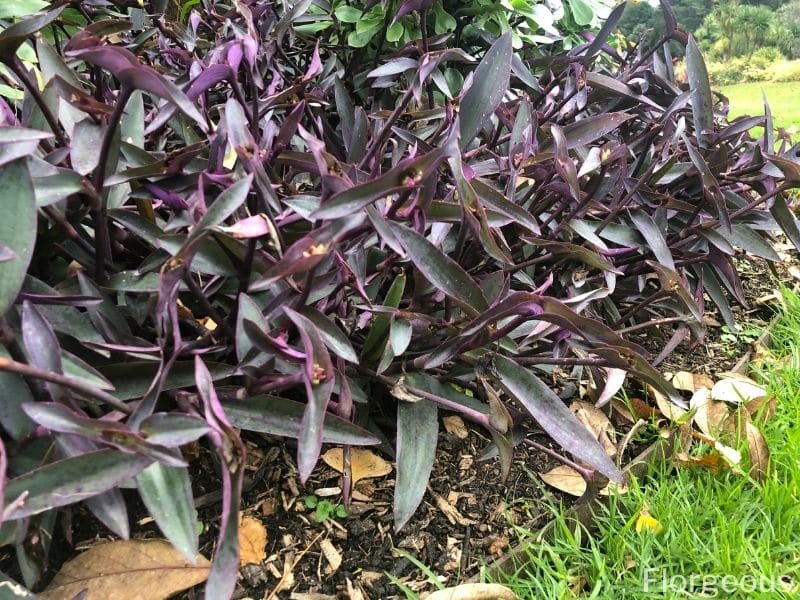
The leaves and stems of this species are in striking deep purple color hence the common name ‘ purple heart ’. Under shaded, they turn a hint of dull green. The leaves are also longer and have wider space in between.
Does Wandering Jew plant need full sun?
Wandering Jew plants (Tradescantia zebrina) prefer bright indirect light but can tolerate some direct sun, especially in the morning or late afternoon. However, prolonged exposure to intense sunlight may cause their dark green leaves to scorch.
How do you care for a wandering Jew plant indoors?
To care for a Wandering Jew plant indoors, place it in a location with bright, indirect sunlight, such as near a window. Water it when the top inch of soil feels dry, typically every 1-2 weeks, and provide well-draining soil. Additionally, mist the plant occasionally to increase humidity and remove dust from the leaves.
How do I make my Wandering Jew fuller?
To make your Wandering Jew plant fuller, prune it regularly to encourage branching and bushier growth. Pinch off the tips of the stems or trim back leggy growth to promote new growth and create a more compact appearance. You can also propagate wandering jew cuttings to create new plants and fill out the pot.
How long do Wandering Jew plants live?
Wandering Jew plants are generally long-lived when provided with proper care. With the right growing conditions indoors, they can thrive for several years, often becoming fuller and more lush over time with regular pruning and maintenance.
Reference List
(1) Dash, G., et. al. Tradescantia zebrina: A Promising Medicinal Plant. 2017. IAJPS, 4 (10). P. 3498-3502 .
(2) Arakelyan, H. Tradescantia zebrina- Mother Nature Healing. 2019. Researchgate.
(3) Vermeulen, N. Encyclopedia of House Plants. Taylor and Francis. 1999. P. 320.
(4) North Carolina State Extension. Tradescantia zebrina. NC State University. 2018. https://plants.ces.ncsu.edu/plants/tradescantia-zebrina/ . Accessed on 12 August 2020.
(5) The State of Queensland. IPA-Zebrina. Department of Agriculture and Fisheries. 2020. https://www.daf.qld.gov.au/__data/assets/pdf_file/0020/51284/IPA-Zebrina-PP102.pdf . Accesed on 12 August 2020.
Photo by Wirestock/depositphotos
Have you seen these?
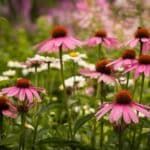
5 Best Coneflower Companion Plants and The Worst to Avoid
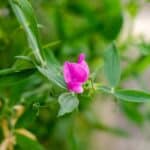
Enhance Blooms & Soil Health: Top 12 Companions for Sweet Peas
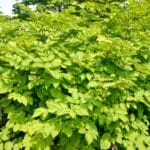
6 Best Aralia Sun King Companion Plants and Landscaping Ideas
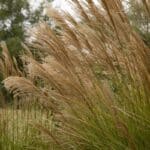
Growing and Caring for Maiden Grass (Miscanthus sinensis)

How to Grow and Care for Fountain Grass (Pennisetum)
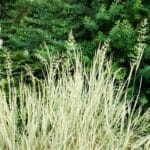
Growing and Caring for Blue Oat Grass (Helictotrichon sempervirens)
About the author.
How to Grow and Care for a Wandering Dude Plant
Here’s how to care for this pretty trailing plant.
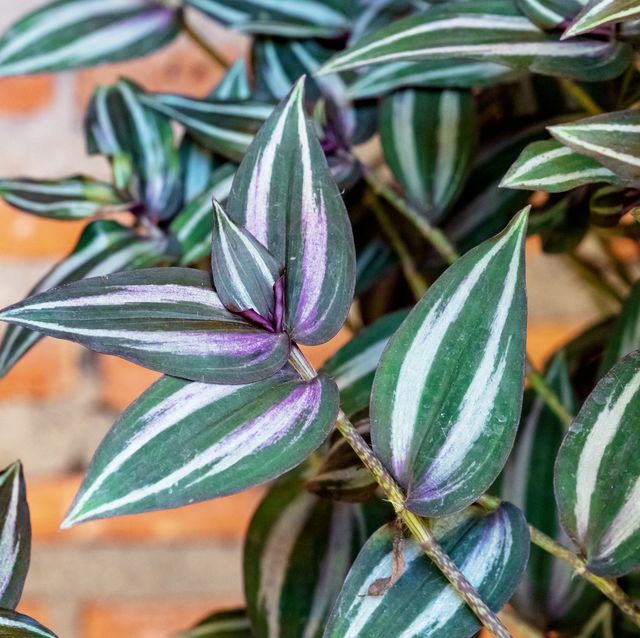
Country Living editors select each product featured. If you buy from a link, we may earn a commission. Why Trust Us?
With its long dangling stems, this plant tends to “wander” all over the place. Today, the plant often is called by its botanical name, Tradescantia, with “zebrina” referring to its silver striping.
It’s sometimes also called silver inch plant, but it can be confused with another plant, commonly called inch plant, Tradescantia fluminensis , which has solid green foliage.
Other varieties of wandering dude have become widely available in recent years, including the very popular nanouk type, which has foliage with pretty pinkish stripes and magenta undersides.
Native to Mexico, Belize, Guatemala and Honduras, the wandering dude usually is grown as a houseplant, but in USDA Hardiness zones 9 to 11 , it can be grown as a low-growing ground cover, too. ( Find your zone here .)
Read more: 15 Common Houseplants to Grow and Brighten Up Your Home
Ahead, learn everything you need to know about how to care for a wandering dude plant:
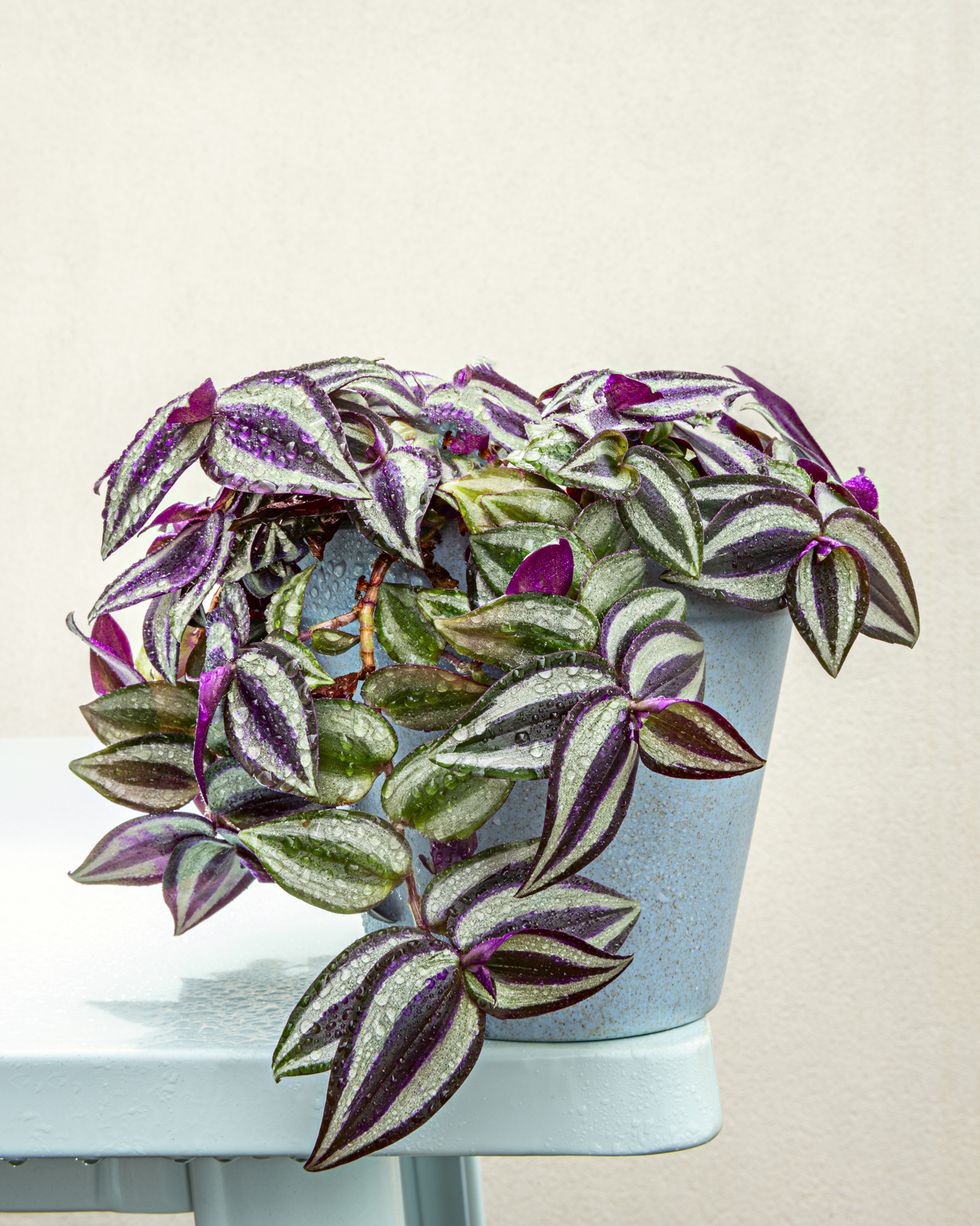
Wandering Dude Basic Info:
- Common Name: Wandering dude
- Botanical Name: Tradescantia zebrina
- Plant Family: Commelinaceae
- Type of Plant: Perennial, grown as houseplant
- Native Origin: Mexico, Belize, Guatemala, Honduras
- Sun Exposure: Full sun to part shade
- Mature Size: 6 inches tall by 1 foot wide
- Toxic to pets: Yes
Why Trust Us
I'm a garden writer with more than 15 years of experience growing houseplants, edibles, and landscape plantings. I also regularly trial new plant cultivars for performance and reliability, and test garden products to evaluate practicality and durability.
How Do You Care For a Wandering Dude Plant?
Give wandering dude bright, indirect light. If it doesn’t get sufficient light, this plant tends to get gangly and unattractive. Its purple coloring also may fade in low light, which means you should move it to a more brightly-lit room or use a grow light.
If your wandering dude is starting to get scraggly, simply snip off a few inches from the end of each stem to help stimulate the plant to push new, bushy growth. You can use plant snips or your fingers. You may need to pinch back frequently because wandering dude is a fast grower.
How Do You Water a Wandering Dude Plant?
You should water only when the plant feels mostly dry. Poke your finger in the soil before watering; if soil clings to your finger, wait a few more days and recheck.
If you let it get too soggy, that’s a sure way for it to get mushy and die. Like most houseplants, it’s better to err on the side of too dry, rather than too wet.
If you like, you can feed this plant with any general-purpose houseplant fertilizer, but it’s not entirely necessary.
Miracle-Gro Miracle-Gro Water Soluble All Purpose Plant Food, 3 lb
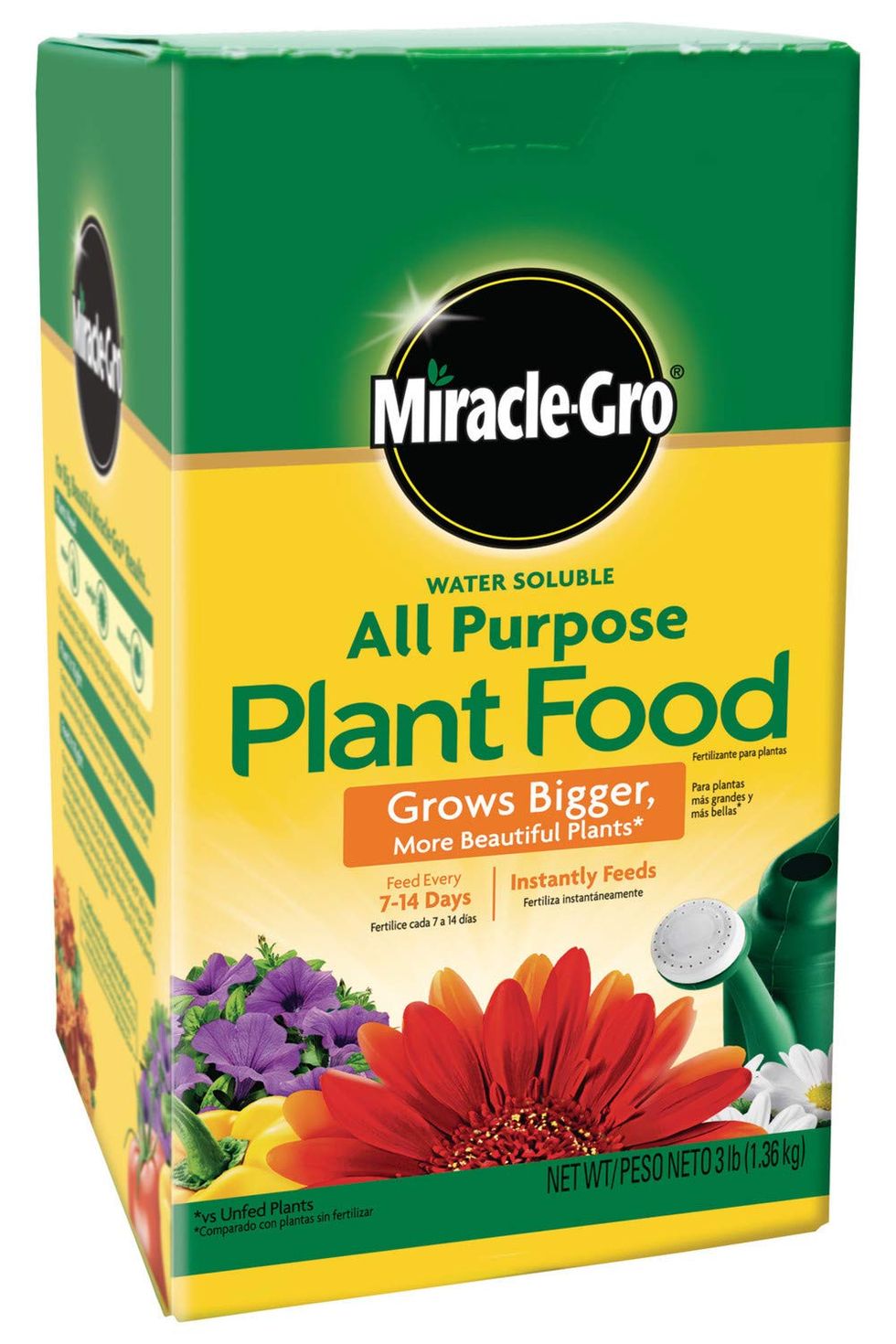
Can You Grow Wandering Dude Plant Outdoors?
Yes, it makes a great trailing plant spilling out of containers! Pair it with tall plants such as hibiscus, canna, elephant ears, or other tall, upright tropicals. If it starts to get leggy, just trim it back. Outdoors, it does best in full sun (northern climates) to part shade (southern climates). It may develop tiny pinkish flowers outdoors, though it rarely flowers indoors.
How Do You Propagate a Wandering Dude Plant?
Like pothos , this is a great plant to propagate to share with friends or to make new plants for yourself. Simply take a cutting, say, if it’s getting too long, then place it in a glass of water to root. Keep it in a bright spot in your home (not direct sunlight), and watch for roots to develop within about two weeks. Then plant in regular potting soil, and keep the soil lightly moist while it settles in.
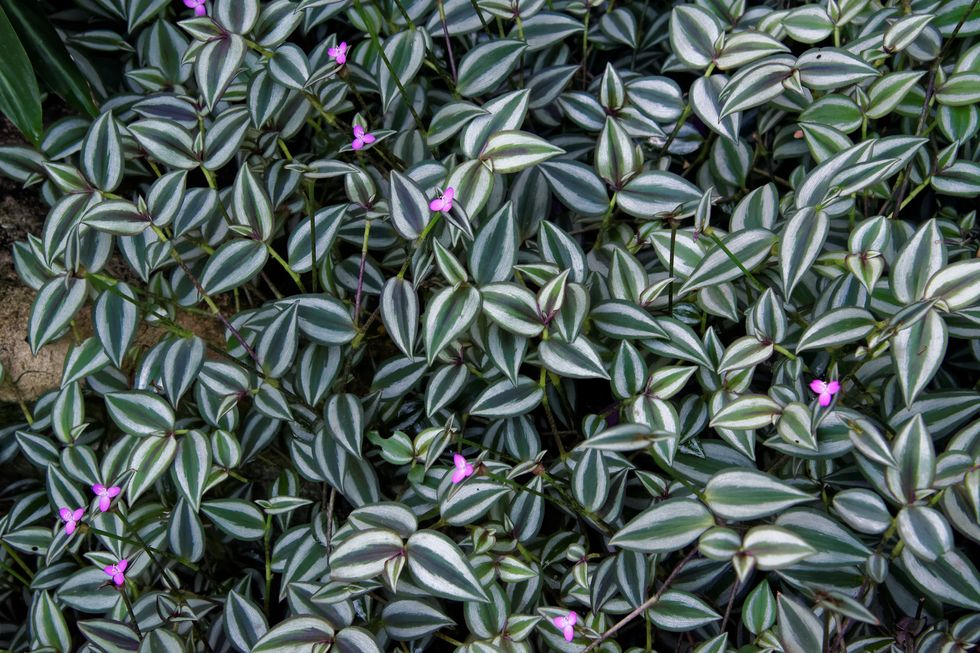
Is Wandering Dude Toxic to Pets?
According to the ASPCA , this plant is toxic to pets and may cause dermatitis, or irritation of the lips and mouth. But remember that any plant may cause vomiting or GI distress if eaten in large enough quantities, so keep this away from pets who are nibblers. Finally, call your vet ASAP if you suspect your pet has ingested it, even if you’re not sure. It’s always better to be safe than sorry!
In addition, the plant sap also may cause skin irritation in some people. Wear gloves when handling cuttings if you tend to have sensitive skin.
Read more: 28 Pet- Friendly Houseplants You Can Grow Without Worry
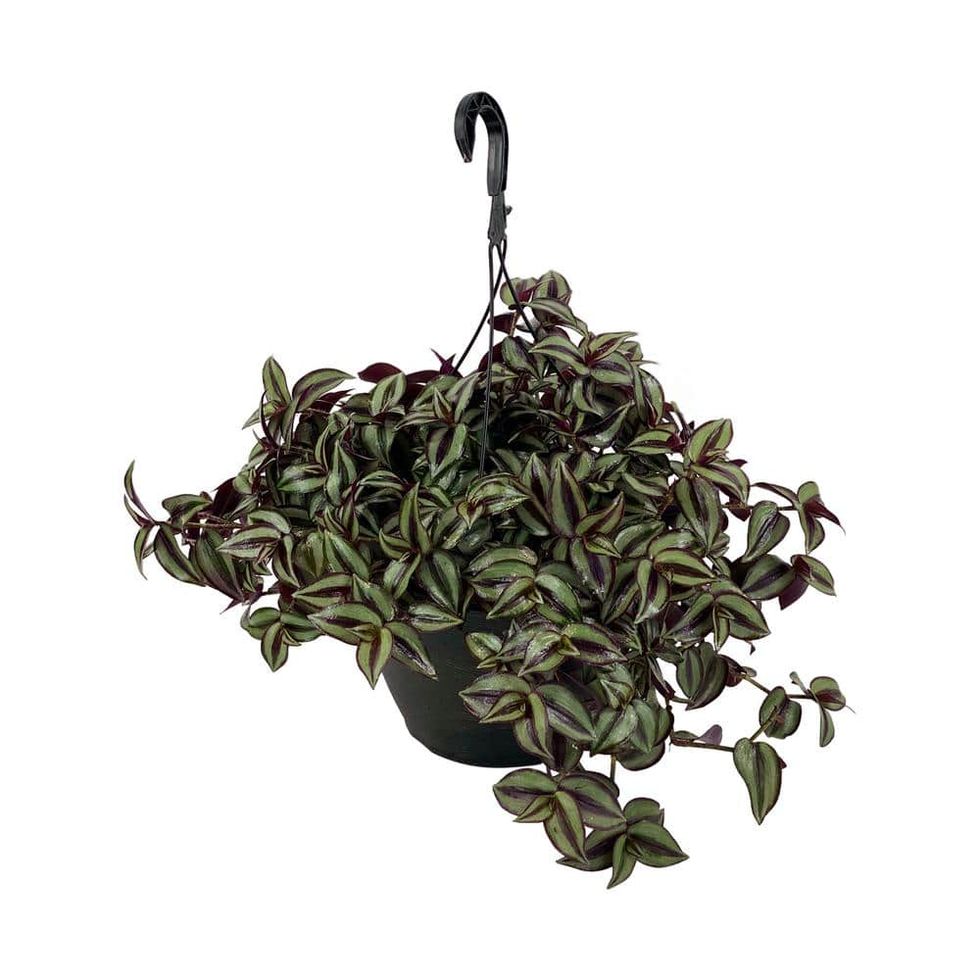
Vigoro Tradescantia in 11-inch Hanging Basket
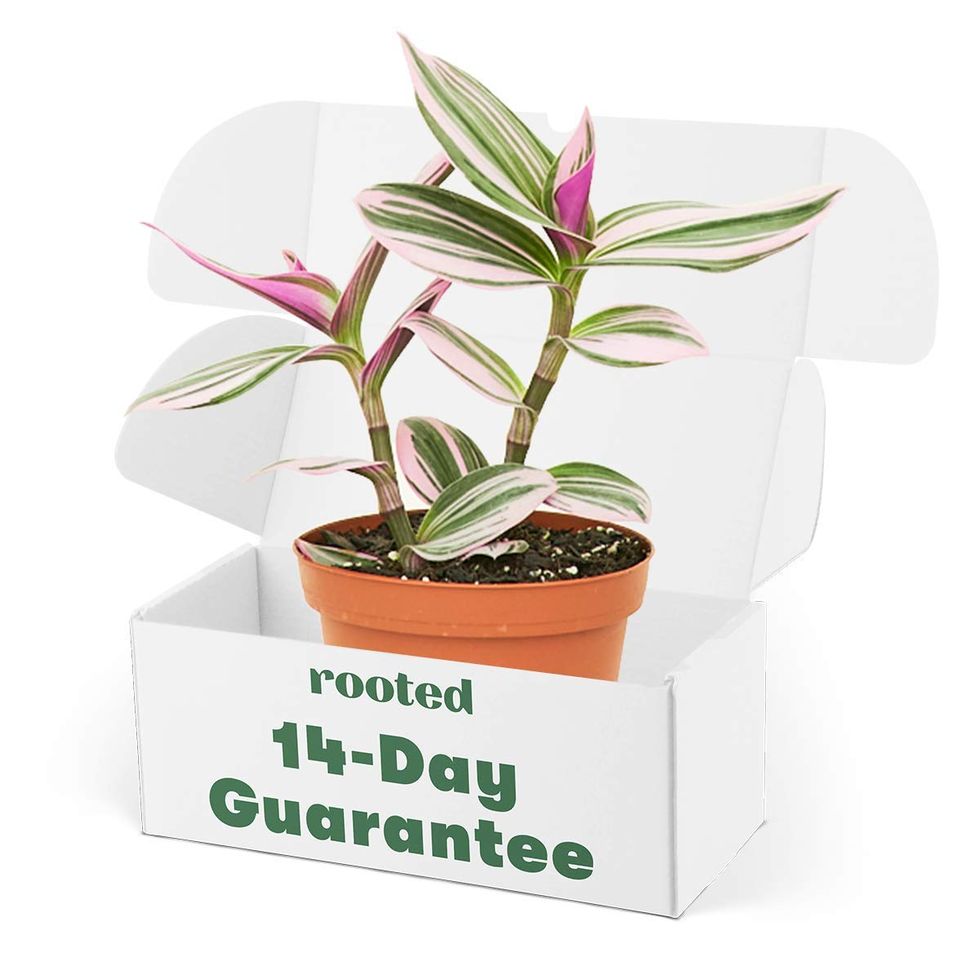
Rooted Tradescantia Nanouk, 4-inch pot
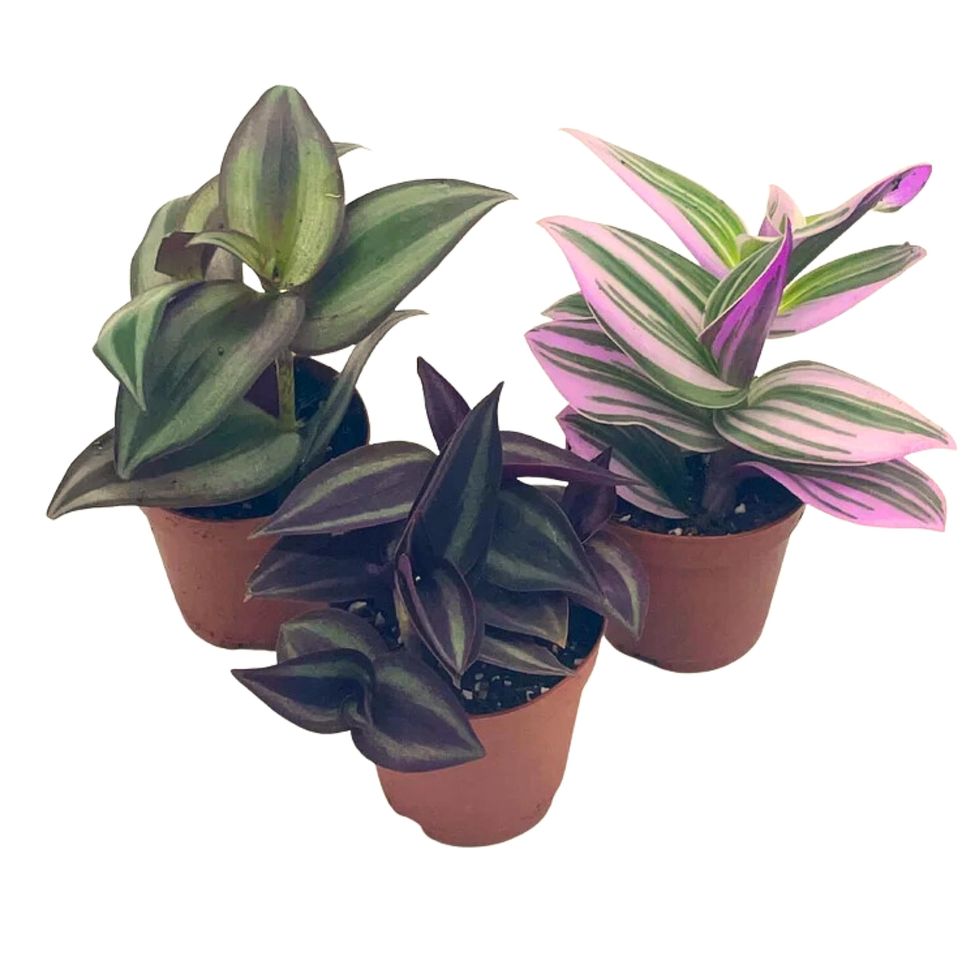
BubbleBlooms Wandering Dude Assortment
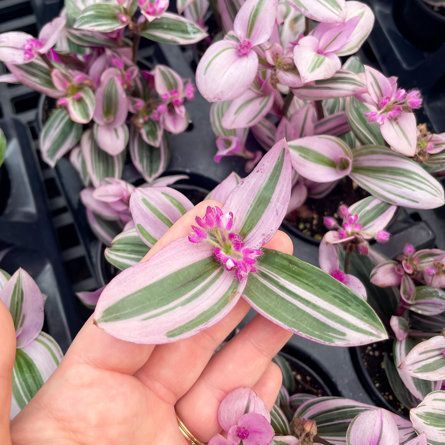
Wayfair Tradescantia Nanouk, 4-inch pot
Arricca Elin SanSone has written about health and lifestyle topics for Prevention, Country Living, Woman's Day, and more. She’s passionate about gardening, baking, reading, and spending time with the people and dogs she loves.
.css-1shyvki:before{background-repeat:no-repeat;-webkit-background-size:contain;background-size:contain;content:'';height:0.819rem;margin-bottom:0;margin-right:-0.9375rem;width:3.125rem;}.loaded .css-1shyvki:before{background-image:url('/_assets/design-tokens/countryliving/static/images/arrow.svg');}@media(max-width: 48rem){.css-1shyvki:before{display:none;}}@media(min-width: 40.625rem){.css-1shyvki:before{display:inline-block;}} Gardening Encyclopedia .css-unxkmx:before{background-repeat:no-repeat;-webkit-background-size:contain;background-size:contain;content:'';height:0.819rem;margin:0.7rem auto 0.9375rem;width:3.125rem;}.loaded .css-unxkmx:before{background-image:url('/_assets/design-tokens/countryliving/static/images/arrow.svg');}@media(max-width: 48rem){.css-unxkmx:before{display:block;}}@media(min-width: 40.625rem){.css-unxkmx:before{display:none;}}
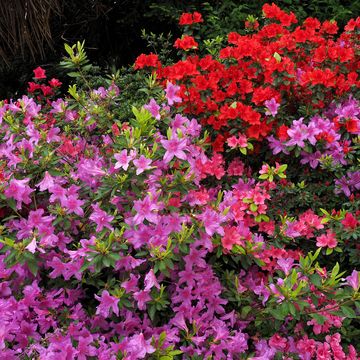
18 Spring Vegetables That Are Best Right Now

86 Essential Garden Flowers (With Pictures)
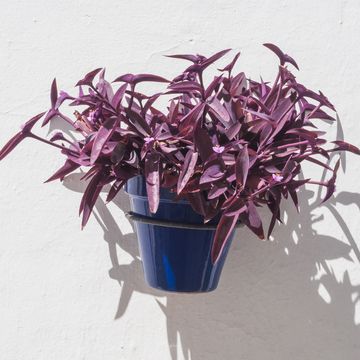
Here's How to Keep Purple Heart Plant Colorful
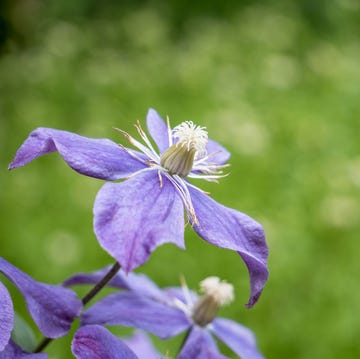
Your Guide to How to Plant and Grow Clematis

21 Indoor Plants to Breathe Life Into Your Home
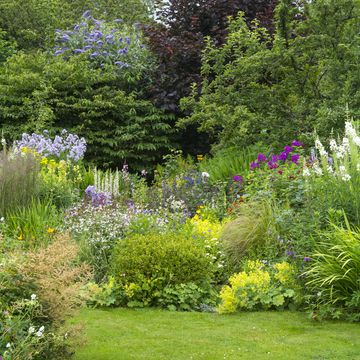
Get Started on Your Spring Garden Plan Now
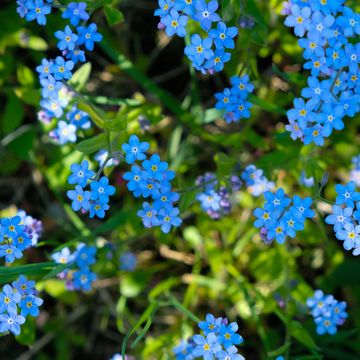
Here's How to Grow Forget-Me-Not Flowers
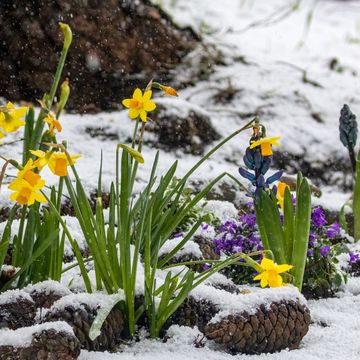
20 Winter Flowers That Add Life to a Snowy Garden
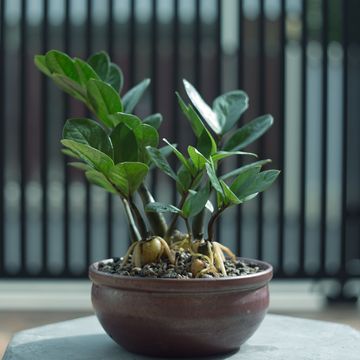
How to Care for a ZZ Plant
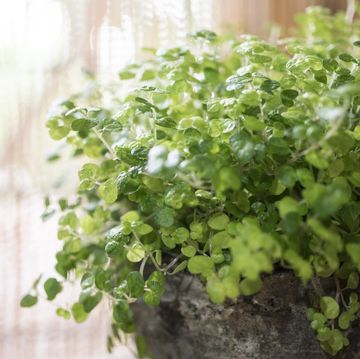
How to Grow Baby’s Tears Plants at Home
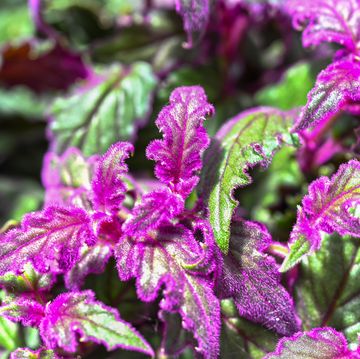
How to Grow and Care for Purple Passion Plant
- Growing Houseplants
- Indoor Garden Ideas
- Cactus & Succulents
- Houseplants Care
- Flowers & Blooms
- Gardening Guide
- Plant Care and Tips
- Beans/Fruit Vegetables
- Companion Planting
- Culinary Herbs
- Flowering Herbs
- Garden Design
- Gardening Ideas
- Growing food
- Growing Trees and Shrubs
- Leafy Vegetables
- Medicinal Herbs
- Patio Gardening
- Root Vegetables
- Shade Plants
- Temperate Fruits
- Tropical Fruits
- Balcony Gardening
- Container Fruits
- Container Gardening Ideas
- Container Herbs
- Container Vegetables
- Rooftop/Terrace Gardening
- Urban Gardening
- Vertical Gardening
- More Than Gardening
- Best and Top of Gardening

- Container Gardening
- Indoor Gardening
8 Types of Wandering Jew Plants+Care Tips

2-Minute Read
When it comes to versatility, there’s none like the adaptable wandering jews check all different types of wandering jew plants in this detailed article.
Wandering Jew Plant comprises various species in the Tradescantia genus. As the plant is adaptable to both indoor and outdoor conditions, it doesn’t matter if you are planning to have it as ground cover, in hanging baskets, or in containers; it’ll do equally well! Also, d o you know you can grow wandering jew in the complete shade, as well as in full sunlight? In full sun, it looks more colorful. Whereas, shade gives its leaves a greenish hue. Here are the Types of Wandering Jew Plants you should consider growing!
Have a look at the plants you can start with just one cutting and a glass of water here
1. tradescantia fluminensis.

It’s a popular indoor houseplant, which is also used as ground cover. Its white flowers are triangular and formed by three petals and look glorious attached to fleshy stems with oval-shaped leaves that are glossy and deep green.
Check out our article on colorful houseplants here !
2. tradescantia zebrina.
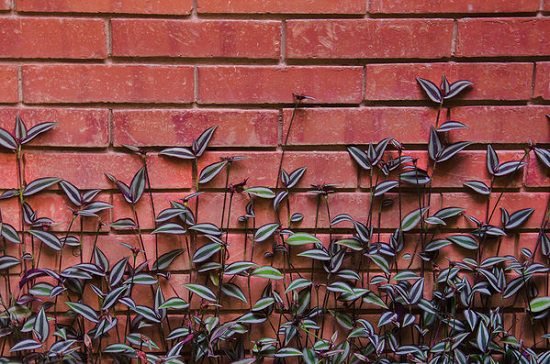
The variegated leaves resemble the stripes of the zebra, hence the name! The purplish-green foliage has a silver outer edge and white stripes running down lengthwise. It grows low to a height of 6-12 inches, and that’s why it can be grown as ground cover. It is one of the best types of wandering jew plants on the list.
3. Tradescantia pallida

It also goes by the name “Purple Heart” and is native to Mexico. Deep purple foliage, adorned with light purplish-pink flowers, looks marvelous and is the reason that it’s one of the most popular types of wandering jew plants! Apart from growing it as a striking ground cover, you can also have it in hanging baskets.
To know about more purple houseplants, click here !
4. tradescantia blossfeldiana.

Commonly known as the ‘Inch plant,’ it’s also referred to as Tradescantia cerinthoidebs . The thick green leaves have a fuzzy texture and a purple hue on the underside. You can easily propagate it from the cuttings, both in soil and water, once it gets growing. It bears delightful clusters of blue, purple, white, or rose pink flowers, making it one of the best types of wandering jew plants on the list.
5. Tradescantia Sillamontana

If precise geometric patterns are your thing, then you’ll love it because of its foliage. Growing from a thick succulent stem, the leaves are around two inches long and covered entirely in white hair. Magneta flower protrudes from the terminal end of the stem in summers.
6. Tradescantia spathacea
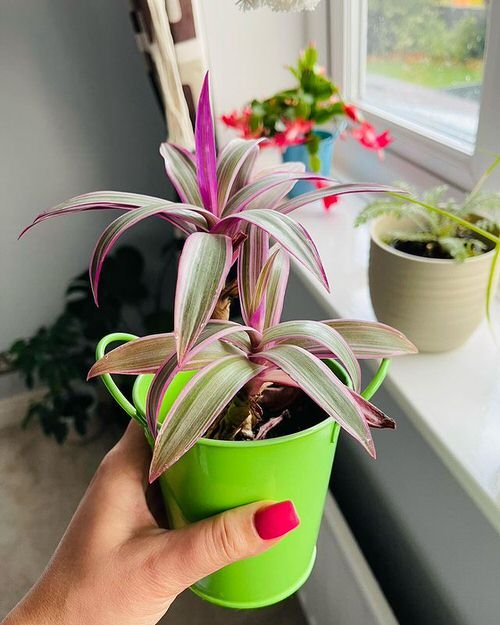
Known as Moses-in-a-basket, Oyster plant, or Boat lily, it is a sub-succulent herb from southern Mexico, Guatemala, and Belize. It grows in 6-12 inches long rosette and sword-like, narrow, and spiral-shaped dark green leaves, with purple bottom sides. The white flowers are enclosed with boat-like purple bracts, hence the name.
7. Tradescantia virginiana

Commonly known as the spider lily, it is a herbaceous perennial from the Commelinaceae family. The plant produces violet-purple to blue, three-petaled flowers, with yellow stamens and dark green arching leaves. You can grow this one of the most popular types of wandering jew plants under full to partial shade.
8. Tradescantia longipes
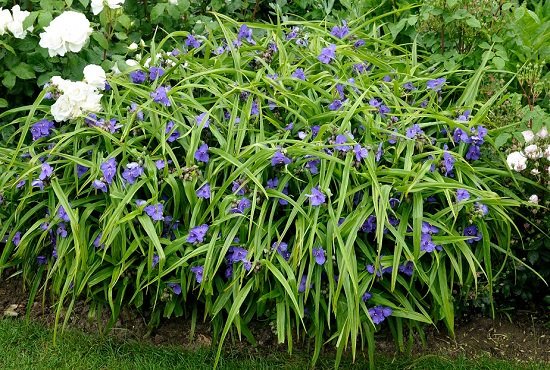
Adorn your garden by growing beautiful, purple-blue flowers of tradescantia longipes or spiderwort. It is native to Southern Missouri and northern Arkansas from the family Commelinaceae. Grow these three-petaled flowers for rock or naturalize gardens, in partial shade, by using well-drained, moist, acidic soil, making it one of the most popular types of wandering jew plants on the list!
Check out our article on indoor rock garden ideas here !
Wandering jew plant care tips.
- Grow a wandering jew plant in bright, indirect light or expose it to full sun, which it won’t mind either. Just keep in mind that low light can fade the markings on leaves.
- Water the plant directly around the roots, avoiding the crown, as it can result in rot.
- The plant prefers slightly moist soil, so maintain the right watering schedule.
- Use an all-purpose, water-soluble fertilizer, once a month, during the growing period.
Recent Posts
8 climbing green vegetables that are vines, 10 extra large houseplants you must grow, 11 most fragrant hawaiian flowers, how to grow so many tomatoes in so little space: 9 best ways, 15 diy hanging baskets for herbs, how to grow watermelons from seeds | planting watermelon seeds, 24 trendy snake plant arrangements for 2024, 8 vines with red berries, join our 3 million followers:, related articles, why everyone should have a spider plant at home: 8 reasons, how to grow cilantro indoors easily, how to make ponytail palm grow taller and large: 6 tricks, 8 different ways to grow houseplants without soil, how to propagate an elephant ear plant: 4 best ways.
dO YOU NEED TO BRING A POTTED PLANT INDOORS DURING THE WINTER MONTHS?
Depends on the plant and where you live. Do research on the specific plant.
Sooooo number 4…. Is not a blossefeldiana. It’s a flumensis. …. You posted a tri-color-mundula variegata……. Not a nanouk. A nanouk is a blossefeldiana centerthoides
LEAVE A REPLY Cancel reply
Save my name, email, and website in this browser for the next time I comment.

Get the Best of BalconyGardenWeb Directly in your inbox.
POPULAR CATEGORY
- Best and Top of Gardening 1562
- Flowers & Blooms 616
- Growing Houseplants 599
- Gardening Guide 413
- Gardening Ideas 380
© 2023 Balcony Garden Web | All rights reserved
- Privacy Policy
- Terms of Service
- Feedback Page
9 Essential Tips for Wandering Jew Plant Care
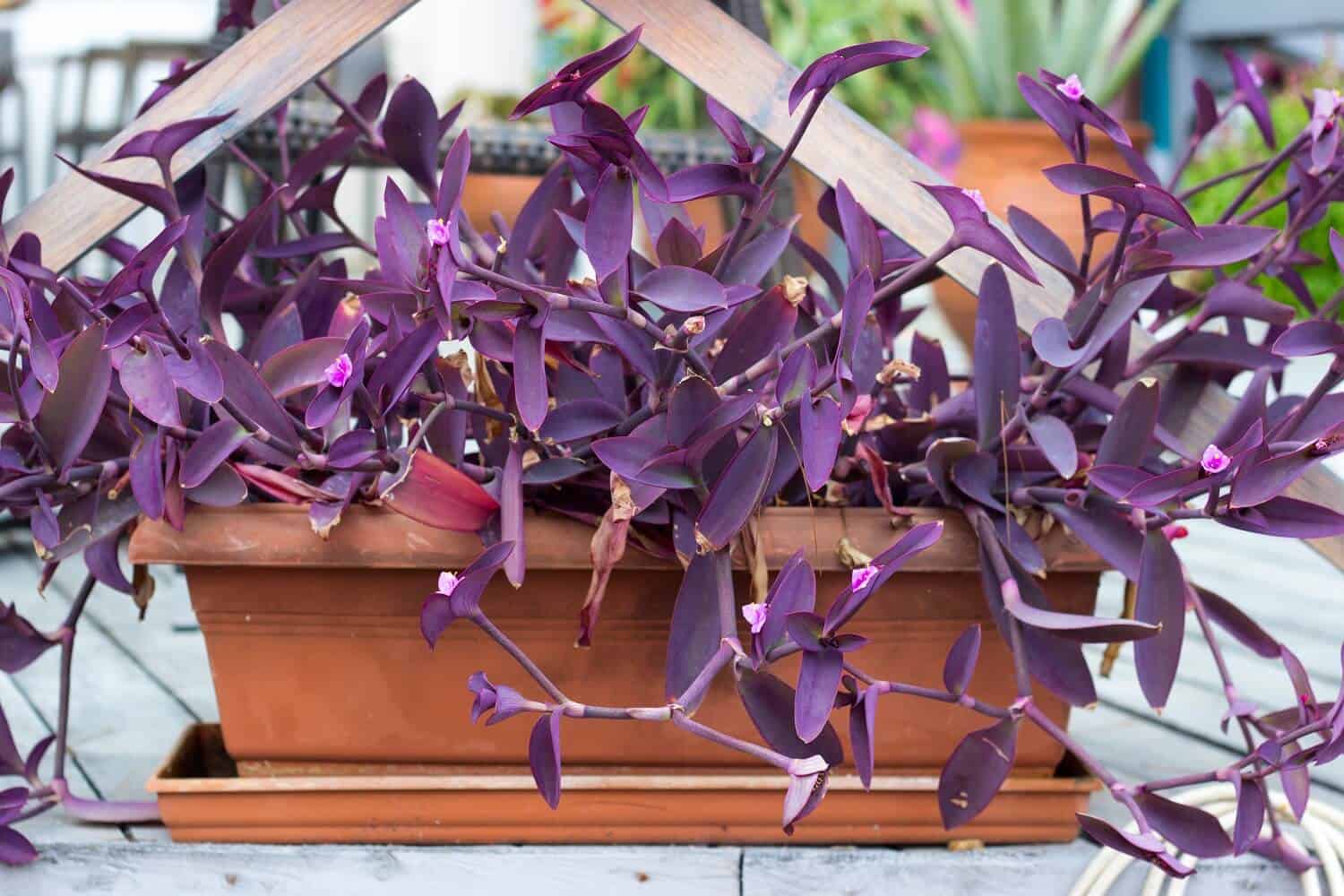
Sharing is caring!
Have you been looking for information on Wandering Jew Plant Care? Well, look no further. Call it luck or, pure coincidence that you have landed on this piece of information.
The article contains most if not all the things you need to know about taking care of this beautiful indoor vining plant . Be it propagation, watering, temperature and light requirements, pruning, repotting, or fertilizer application, it’s all in here.
Furthermore, I have touched on pests and diseases affecting this colorful, fast-growing indoor trailing succulent plant as well as common physiological problems associated with it.
Want to learn more about this plant?
Let’s begin.
Wandering Jew Plant Care: How to Grow and Care for Inch Plant ( Tradescantia zebrine )
1. propagate from stem cuttings.
Propagating a wandering Jew plant from stem cuttings is easy and quick. What’s more, is that you don’t need a special rooting medium or hormone for successful rooting. You just need to root the cuttings in water or soil.
Let’s start with rooting a Jew plant in water. First, cut at least 6-inch long cuttings from the healthy stems of the plant.
Then remove the bottom leaves from each stem and place the stems in a glass of water. Ensure that the bottom leaf node is submerged. In just a few days, tiny roots start to show, and in about 4 to 6 weeks, new growth appears.
At this stage, your cuttings are ready for transplanting. Use an all-purpose potting mix to grow your plants.
When it comes to rooting the Jew plant in soil, start by snipping several cuttings from the ends of healthy branches of your plant. Then using a clean and sharp blade, make a 45-degree cut just under the leaf node.
The next step is to fill an approximately six-inch hanging basket or pot with an all-purpose potting soil to about an inch below the top of the pot.
Afterward, make four holes approximately 2 inches deep around the edges of the pot and one more hole at the center.
Plant one cutting in each hole and add more soil as you press gently to hold the cuttings in position. Keep the soil evenly moist by regular watering and expect a new, full-leafy plant in a few weeks.
Pro Tip: Planting more than one stem in a single container makes the container appear fuller.
The plant thrives best in good-drained soil and with just an all-purpose potting mix, you are good to go!
It’s also fine to use regular potting soil provided that the soil doesn’t get soggy. You can improve soil drainage and aeration by adding some pumice or perlite.
In another case, your soil might seem to dry too quickly as opposed to holding moisture. Under these circumstances, mix in some vermiculite, peat moss or, coco coir to help the soil retain moisture.
3. Sunlight
This groundcover plant is hardy to zones 9 through 12 and it’s a nice houseplant.
Keep your indoor Jew plant, in a spot with bright but indirect light for example in an east or west-facing window. Your plant, therefore, will get plenty of natural light in the morning or evening, and bright indirect sun for the rest of the day.
This is important because when grown in too little light, the leaves’ color appears faded while under too much light, the leaves are prone to scorching.
On the other hand, an outdoor-grown plant requires a bright but partially shaded environment. This way the plant gets some shade during the hottest hours of the day.
This also applies to when you move your indoor plant outside for the summer.
4. Watering
Even though this plant is drought tolerant , it requires regular watering or, it won’t survive long spells of dryness or wetness. So, practice good watering habits and keep the soil moist but not soggy.
Using your finger, check whether the topsoil feels dry, or use a soil moisture gauge to check if the plant needs watering. If it does, water the plant thoroughly until water comes out through the drainage holes in the pot.
Then empty the sauce to avoid the development of diseases such as root rot.
5. Fertilizer Application
Although this plant doesn’t need to be fertilized, feeding it once in a while will benefit the plant by replacing the nutrients lost every time you water it.
Apart from this, fertilizing also encourages the plant to bloom. Imagine enjoying the beautiful view of purple, pink or white flowers even in winter!
Hence, feed the plant each month in spring through summer with a liquid fertilizer formulated for houseplants mixed at half strength.
Furthermore, this plant can be sensitive to chemical fertilizers so, use organic plant foods such as compost tea or a general-purpose fertilizer. Adding slow-release organic granules in the soil works well too.
You can also use liquid kelp and fish emulsion but only on outdoor-grown Jew plants as the two formulations can get somewhat stinky when used indoors.
6. Humidity & Temperature
Humidity is another key requirement for a healthy and good performing Jew plant. This plant loves lots of humidity.
Although maintaining good humidity levels indoors especially during winter can be challenging, it is possible to increase the levels using a humidifier .
Alternatively, fill a pebble tray with water and place the pot on the tray (don’t allow the pot to sit directly on water). This way, humidity around the plant increases as the water evaporates from the tray.
When it comes to temperature, the plant prefers warm temperatures of about 50-80 degrees. And when the temperature goes above 90 degrees, you need to water the plant more frequently and provide some shade to bring down the temperatures.
During winter, you need to be careful especially when the temperature is in a 45 degrees range. The plant will tolerate the condition for a short period but will die if the condition prolongs.
For this reason, device a way to help keep your plant’s ambient temperature above 50 degrees, for instance, a cold frame or a piece of woven cloth.
Pro Tip: When humidity levels are too low, the plants’ leaves start to turn brown and eventually die.
7. Repotting
This plant is fast-growing and repotting is quite necessary whenever the plant becomes crowded in its pot/container.
To repot, first select a container that’s approximately 50% wider than the existing one. Then, use some fresh potting mix around the sides of that container, remove the plant from the current container/pot and place it into the new one.
Next, remove or add the potting mix as needed to keep the plant into place and fill to about 2 inches below the containers’ rim.
Finally, press the potting mix lightly to hold the plant into place.
With time, there is a likelihood of your plant becoming leggy. When this happens, prune back the plant and pinch off the stem tips as well.
This way, the plant produces two new growths from right below the pinched areas and the plant becomes bushier and healthier.
Also, prune off the long tendrils if you like to have your plant thick and compact.
9. Look out for Pests and Diseases
Spider mites.
These are some of the most common pests in Jew plants and they cause damage by sucking sap from the plant. They like dry and warm areas.
Get rid of spider mites by misting, keeping the humidity high, or wash the plant with water to knock off the pests.
Plus, remove the infested plant parts/areas or use a systemic insecticide when the infestation is severe.
Aphids are another sap-sucking pests in wandering Jew plants. They are tiny, pear-shaped bugs that congregate along the stems in large masses.
Under severe infestation, the plant gets weak and eventually dies. Get rid of aphids by wiping the pests off the plant using a moist cloth (this works for low infestation), or spray the plant with an insecticidal soap or neem oil when the infestation is high.
This is the most common disease in wandering plants. It is caused by either over-watering or, your soil holding too much water. So, if the soil drains well but there is an occurrence of root rot, reduce the watering frequency.
And if the problem is poor drainage, devise ways of improving soil drainage such as adding some perlite or compost to the soil.
Common Problems in Wandering Jew Plant
Leggy plants.
Your plant might become leggy as a result of lack of light, especially during winter. You should hence keep your plant at a spot where it gets the right amount of sun.
However, if you don’t have such a spot in your house, try using grow lights to compliment the available natural light.
Brown leaves on inch plant
The leaves on your inch plant turn brown due to lack of enough moisture or humidity. Also, as the leaves age, they start dying out in the middle and this makes them appear brown. When this happens, prune the vines to refresh the plant.
Faded color on leaves
Faded or dull color on leaves is an indication of too much light, not enough light, or a bug infestation. Therefore, provide the appropriate growing conditions for your plant.
Now that you have read this article, I bet the question of wandering Jew plant care is a thing of the past.
But most importantly, you have seen the things that must be done correctly for a healthy plant.
For example; choosing an appropriate soil/potting mix, selecting the best propagation method, proper watering and, applying the correct fertilizer and at the right time.
Apart from this, pruning and, repotting crowded plants as well as protecting the plants from pests and diseases is a great way of ensuring you have a good–performing wandering plant.
Oh! And don’t forget to keep the environment humid enough.
What has been your experience growing wandering plants?
Share with us in the comments.
University of Wisconsin-Madison
Home Guides
1 thought on “9 Essential Tips for Wandering Jew Plant Care”
I ONCE READ THAT YOU SHOULD LET YOUR WATER SIT FOR 24 HOURS BEFORE USING IT TO WATER YOUR PLANT. ANY TRUTH TO THIS? ALSO, HOW DO YOU RECOMMEND ROTATING THE PLANT FOR EVEN SUNLIGHT. THANK-YOU, GG
Comments are closed.

Grow your knowledge, grow your garden
Wandering Jew Winter Care: Complete ‘How To’ Guide
- By Kaci Reigns
- Updated March 11, 2023
You may have heard about the wandering Jew plant. This beautiful plant is an excellent choice as an indoor or an outdoor plant. If you're wondering how to care for these low-maintenance plants in the winter months, you're in luck. We've done the research and have compiled some of the best ways to care for your plant during the winter!
Here are some tips for caring for your wandering Jew plant in the winter:
- Reduce the amount of watering
- Ensure that you have sufficient humidity
- Keep the plant away from cold drafts
- Stop fertilizing
- Avoid pruning
- Put your plant in a sunny location
This quick-growing, low-maintenance plant is very popular because it is easy to grow! Keep reading to learn more about the changes you need to make in winter for the wandering Jew and more critical information about this wonderful plant!

Wandering Jew (Dude) Winter Care

The inch plant ( Tradescantia zebrina ) is also known as the wandering Jew. More recently, the plant has been called the wandering dude (a less offensive term). Regardless of its name, this plant is a tropical plant that is only hardy for USDA zones eight through 11.
Inch plants are commonly grown as houseplants. They have a low frost tolerance. However, you still need to adjust the care you give these plants in the wintertime.
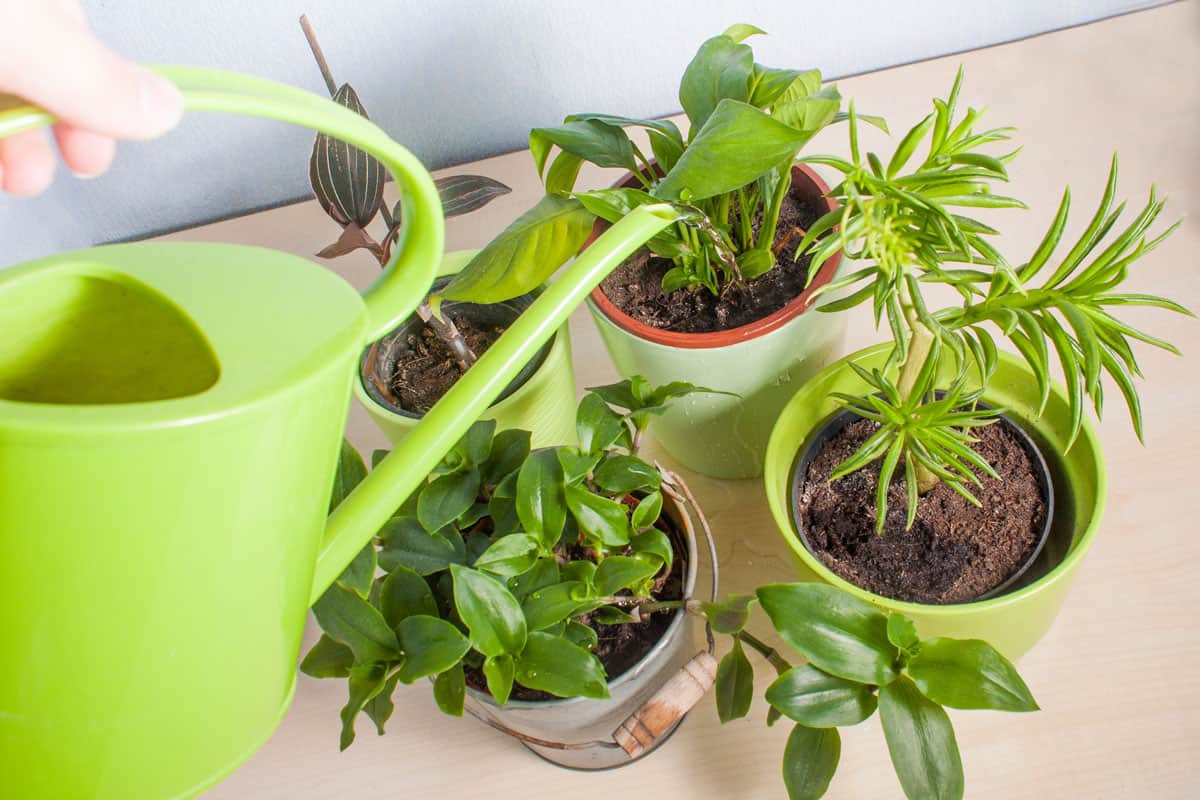
Inch plants are dormant during the winter months. Their dormancy means that you need to cut back on watering. During the plant's growing months, you need to keep the soil moist and well-draining.
In the fall and winter, you can allow some of the soil to dry out before watering. You want to do this because the plant isn't growing as rapidly and doesn't require as much water.
Allow the first two inches of soil to dry out for large plants before watering again. You should only allow up to the first inch of soil to dry out for smaller ones.
Humidity Levels
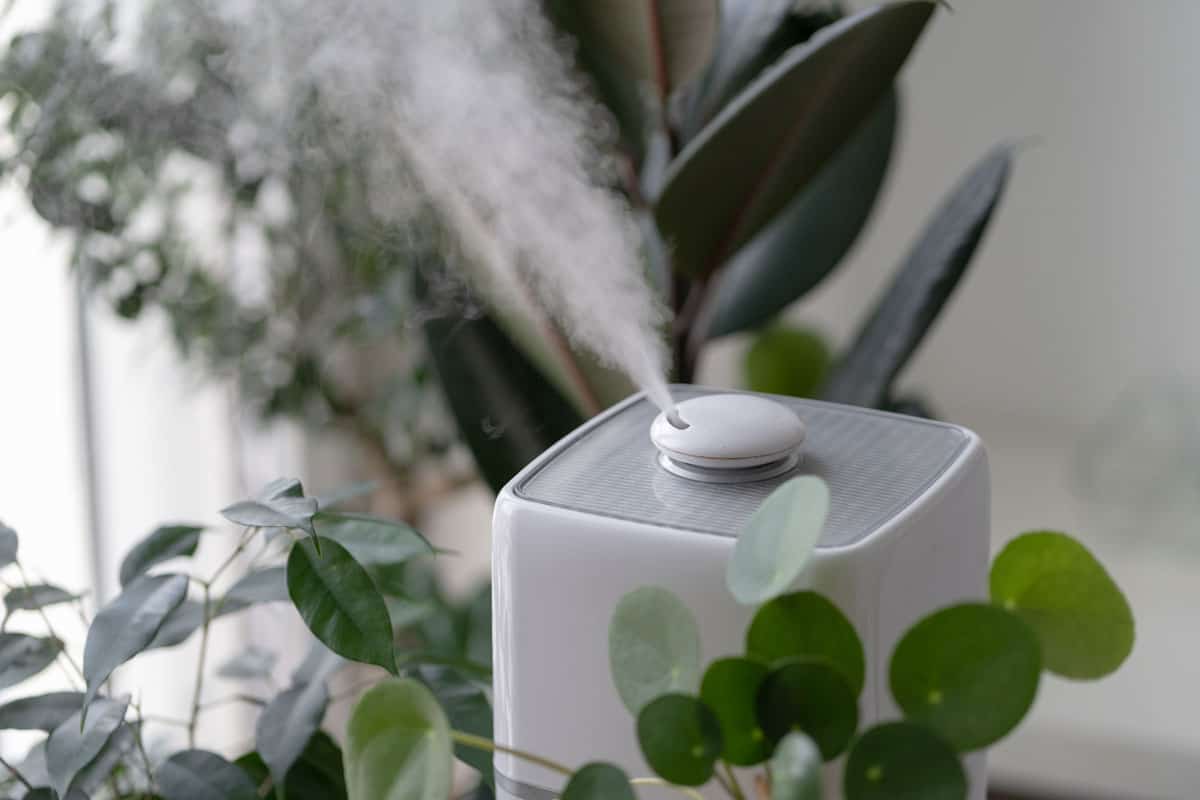
Your wandering dude will still need humidity during the winter. In fact, you may have to increase the humidity levels in your home during the winter. This is because most people use their heaters during this time. Yes, it keeps homes warm, but it also takes away the moisture in the air.
You'll know that you need to adjust your humidity levels if you notice leaves with brown edges or falling leaves. To increase your humidity levels, you can use a humidifier.
Another option is to use a pebble tray. Pebble trays are small dishes filled with rocks and water. You place your plant on top of it, which increases the nearby humidity.
Avoid Cold Drafts

Remember that inch plants are native to tropical regions with higher temperatures. They do well when indoor temperatures are between 60 and 80 degrees Fahrenheit. For the most part, this is within the range most at which people keep their homes.
However, be careful to avoid any cold drafts from your windows. Your inch plants must be brought inside when outdoor temperatures drop below 50 degrees Fahrenheit. A cold breeze, even indoors, can cause severe damage to your wandering dude.
Stop Fertilizing
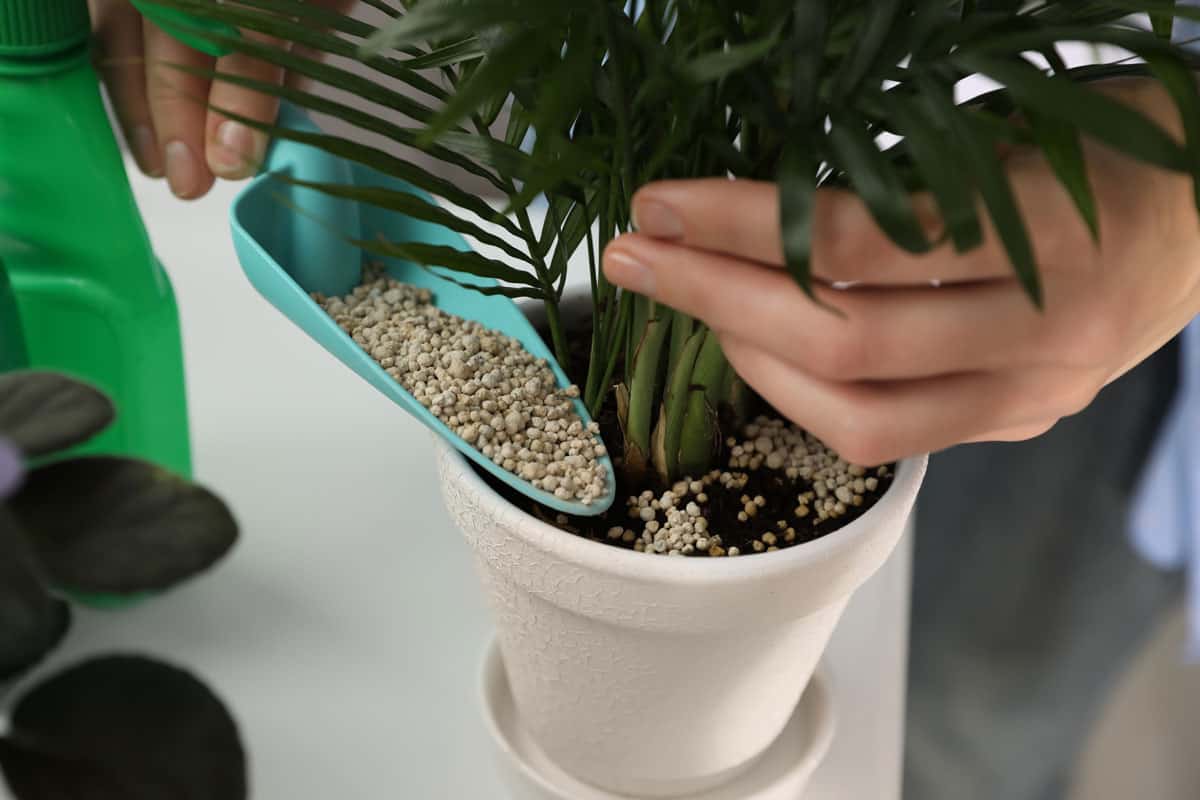
You should stop fertilizing your inch plants during the fall and winter months. Remember, the plants are dormant in the winter. Even if you see new growth, the plant isn't growing rapidly enough to warrant any fertilizing.
It can be challenging to determine if you've over-fertilized your plants. The symptoms can easily be confused with overwatering. However, keep an eye out for yellowing and wilting leaves and leaves dropping. You may also notice a crusty white surface on the soil.
Avoid Pruning
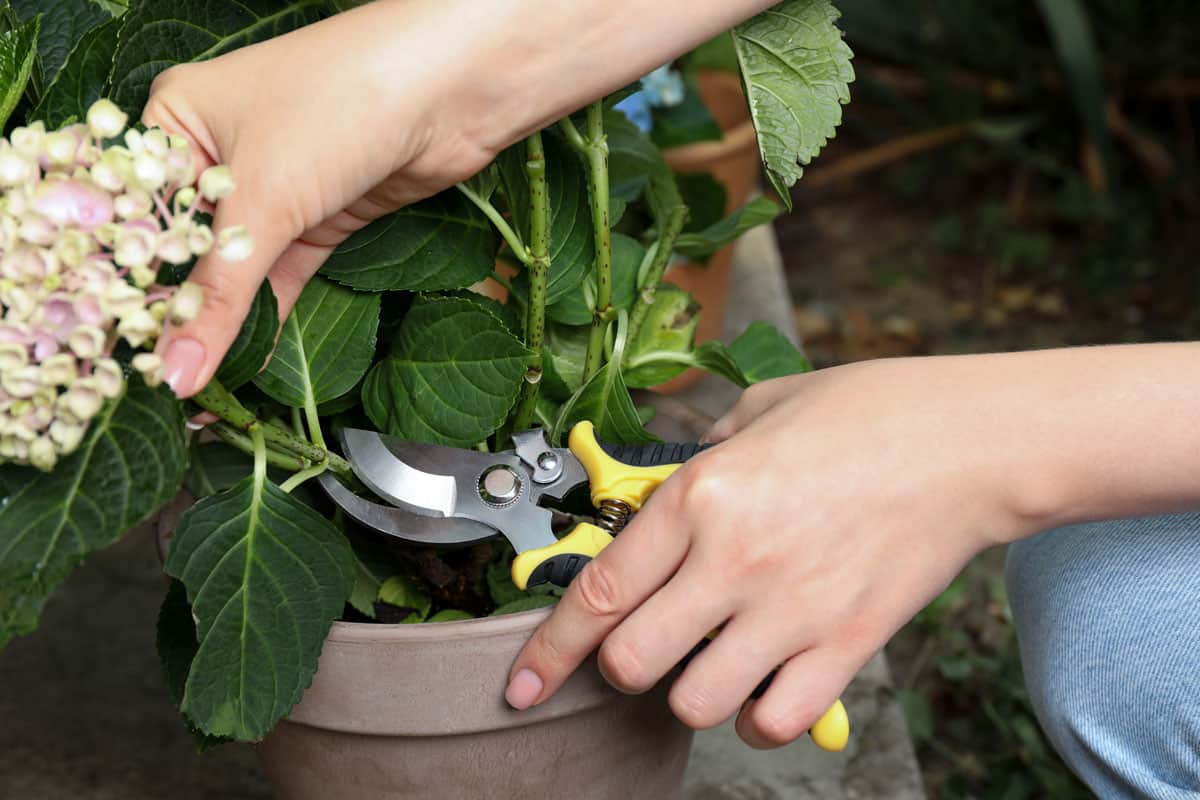
Technically, you can prune your wandering dude plant during the winter months. However, you need to be incredibly careful. New growth can occur when pruning during the fall and winter. Unfortunately, this can lead to weak and leggy growth.
The best time to prune your wandering dude is during the active growing period. These plants can handle a hard pruning in the spring.
Keep Sunlight Levels High

Wandering dudes prefer areas with bright indirect light when grown indoors. They prefer this amount of sunlight year-round. So, even though we get less light, your plant still wants the same amount.
Consider the area where your inch plant is currently. If your plant is at a north-facing window, you may need to move it. You can move it closer to the window or near a south-facing window. South-facing windows are best for getting light without any glare and heat like with east- or west-facing windows.
Another option is to use a growing light. This can help you control the amount of light without moving your plant.

Take a look at this full spectrum light on Amazon!
When To Repot Wandering Dudes
You shouldn't repot your wandering dudes in their dormant months. Changing containers when your plant isn't actively growing can cause shock or root rot.
If you're going to repot, first determine if your plant needs it. Tradescantia can be invasive . You don't have to worry about it overtaking your home. However, its invasive tendencies mean you may not have to repot it as often as you think.
If your wandering dude has roots growing out of its container or slower growth, you should switch to a larger container.
How To Repot
Select a pot that is at least two inches wider and deeper than your current container. It should also have drainage holes. You can also choose a pot that is wider than it is deep. These types of plants typically have shallow roots, so you don't necessarily need the extra space on the bottom.
Water your plant and put on a pair of gloves before repotting your wandering dude. You'll have to work carefully and away from pets and kids. These plants are toxic.
Move your plant's vines to the side and lay the pot horizontally. Then gently remove the plant from its container. You can put your gloved hand between the soil and the container wall to move the plant out.
Put a layer of soil at the bottom of the new container. Then make sure the plant's root ball is untangled. Next, put the plant into the container and fill the sides up with soil. Water the inch plant from above to help settle the soil.

Check out this pot with a drainage hole on Amazon!
What Problems Do Wandering Dude Plants Have?
For the most part, there are no serious issues that you have to worry about for the wandering dude.
However, you should be on the lookout for a few common diseases. Root rot is commonly caused by poor drainage or overwatering. Stem rot can also occur if moisture is left on the plant.
Wandering dudes can be affected by aphids, mealybugs, spider mites, thrips, and slugs. If your plants are being grown exclusively as houseplants, then you don't have to consider slugs.
You should still monitor your plant for signs of other small pests. When left unchecked, aphids and mealybugs can attract ants, and thrips can spread disease to other parts of the plant.
Final Thoughts
The wandering dude, or wandering Jew, is an easy-to-care-for tropical plant that requires a little bit of care to survive the winter.
Be wary of over-watering and cold drafts, which can be damaging for your plant. Keeping that in mind, you'll have a happy, healthy plant to prune and fertilize come springtime!
Are you looking for more wandering dude information? Check out one of the posts below.
Why Is My Wandering Jew Dying [And What To Do]
Will A Wandering Jew Climb A Trellis?
I look forward to receiving new gardening tips!
I always enjoy learning new things about gardening
Yes it help me very much a lot to understand and why it dries up and falls off
I like wondering who’s the pretty they’re pretty easy to take care of you can clip and reboot them make us more Fuller and bigger pinch back and they get full too and I’m going to try to send a picture if I can thank you 😊
I got some samples now I’m having them in the jar of water rewarding and see what happens soon as it works to get up small pots to see if it if I can get it going good 😊
Leave a Reply Cancel Reply
Your email address will not be published. Required fields are marked *
Name *
Email *
Add Comment *
Post Comment

- Rustic Home Decor
- Outdoor decorations
- Storage Ideas
- DIY Projects
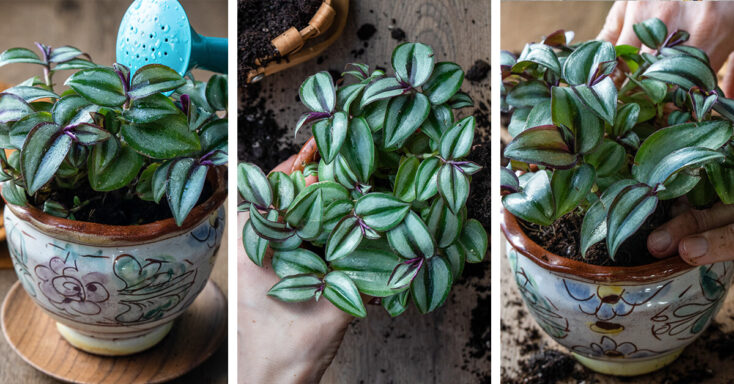
Wandering Jew Plant Care – How to Plant, Grow and Help Them Thrive
Tradescantia zebrina, commonly called the Wandering Jew plant, is a striking houseplant known for its variegated leaves tinted with green, silver, and purple. It originated in Central America and Mexico’s tropical regions. So, the Zebrina is a perfect choice for growing indoors. The good news is that Wandering Jew plant care is not difficult at all!
Key Takeaways
- Zebrina is a low-maintenance, fast-growing plant.
- The Zebra Plant makes an excellent choice for beginner gardeners because care isn’t overly complex.
- This plant quickly fills up empty spaces in your indoor landscaping efforts.
- Pruning is good for Zebrinas. It maintains their shape and keeps them from becoming invasive.
Wondering about the Wandering “Dude”
The Zebrina has numerous nicknames (many from cultivars), including Silver Inch Plant, Striped Trad, Striped Wandering Creeper, Purple Heart Plant, Small Leaf Spiderwort, Moses in the Cradle, and Zebra Plant. Because the name Wandering Jew is offensive to some, gardeners usually use one of these, the botanical name, or the new moniker, Wandering Dude.
The flowing leaves on this plant measure about ½ inch long and about ¼ inch wide. When used outdoors, they make a colorful ground cover. The flowers are pink to purple and bear brownish seeds. Take care when you work with the zebra plant. The sap proves irritating to some people.
Light Play: When Zebrina is in bright light, the colors become even more vibrant. If you have a window location with indirect light, the exposure enhances leaf pigments. It is very visually appealing.
The Basics of Wandering Jew Plant Care (Zebrina)
In taking care of any indoor plant, there are certain important points in your care routine.
- Temperature: Zebrina plants thrive when the temperature is around 70 degrees. Keep the plant away from drafts or air conditioning ducts.
- Light: South or eastern-facing windows work best, provided the light is indirect. If they’re not getting enough sun, they become spindly.
- Water: Keep your inch plant moist. Avoid over-watering or letting the plant’s soil dry out completely.
- Soil: Plant your Wandering Dude in a peat-based potting mix with good drainage.
- Humidity: Good news! The average humidity in your home should work fine.

The Battle of Fronds vs. Flowers: Many people buy houseplants for their flowers. Zebrinas do produce delicate petals, which look charming. However, the true allure of the Wandering Dude is its foliage.
Wandering Jew Plant (Zebrina) Needs
When you’re looking for a beautiful backdrop to your indoor garden efforts, Zebrina fills that need. Mix the type of container you use for greater visual impact. You can take your plants for a summer stroll, but you cannot leave them outdoors during winter.
Except for Purple Queen Zebrina, which loves direct light, the fronds of these plants will burn if left in direct sunlight for too long. If you have a window that gets light in the morning and indirect light later, the Wandering Dude will thrive.
Tip: Turn your pots periodically so all sides of the plant benefit from sunlight.
If you’d like to expand your Zebrina family, propagation is simple. It begins with taking a stem cutting. Look for a healthy stem and snip it below a node. You can then root it in a glass of water or put it directly into the soil. A little rooting compound improves the results from direct soil planting.
Choosing a Wandering Jew Plant for Your Home
Inch Plant (blossfeldiana): Thick, fuzzy leaves with purple undersides. It blossoms in flower clusters of white, rose pink, or blue. Mature height 6-12 inches.
Longpipes (Wild Crocus): These bluish-purple flowers appear from May until June. It’s thin, arching leaves grow up to 7 inches long. If you have a rock feature inside, longpipes will do well there.
Moses-in-a-basket (Oyster Plant; Boat Lily): The dark green leaves are sword-like and grow in a spiral. The undersides of the foliage are purple, and it blossoms with white flowers. Dwarf plants are 6-12 inches tall and require 6-8 hours of indirect light daily. The vibrant purple undersides of this plant’s leaves are truly striking.
There are two popular variants of Moses-in-a-Basket. One is a Tricolor, bearing pink, green, and cream leaves. The other is a Golden Oyster with bright gold-yellow leaves.
Pallida: A native of Mexico, Pallida goes by the name Purple Heart. The foliage is eggplant purple, adorned with light pink flowers bordering on orchid—a good choice for hanging baskets. Grows 1-2 feet tall and wide.
Striped Inch Plant (River Spiderwort, Speedy Henry): Average size is 12” x 12”. The plant’s leaves are dark green, shiny, and pointy (2 inches). Striped inch plants blossom with white flowers.
Virginia Spiderwort: Bright green narrow leaves topped with violet, three-petaled flowers that measure 2” across. Each flower only lives for a day, but there are so many you won’t notice. This is a larger member of the Wandering Jew family, with an adult height of 18-20 inches and a width of 12-18 inches.
White Velvet: Gray-green leaves covered in white hairs distinguish this Wandering Jew from others. It blossoms for about a month in bright pink-purple flowers. Received the Award of Golden Merit from the Royal Horticultural Society. Mature height: 12 inches.
While humans suffer no illness from Zebrina, ingestion by pets can be toxic. Keep this in mind when placing them around your indoor garden.
Wandering Jew Plant Watering Techniques
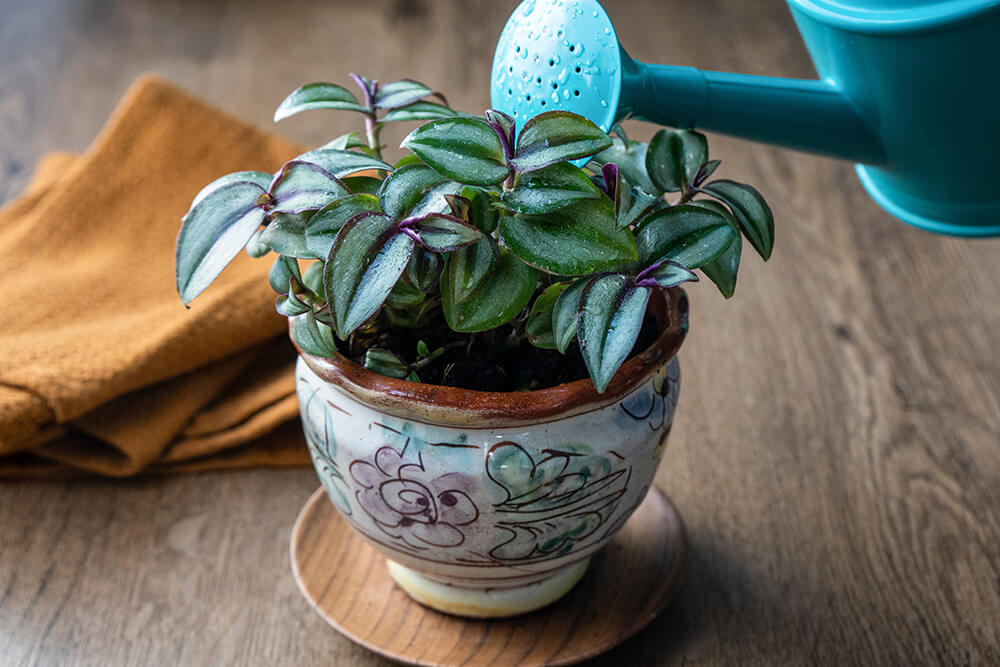
While these plants handle random overwatering, it won’t continue being healthy if left waterlogged too long. When you apply water, do so from the base of the plant. Watch and you can see the water absorption. Alternatively, you can take the plant to your sink and give it a good bottom watering until the liquid comes out of drainage holes. Let it finish in the sink, then put it back in place.
When you walk through your home, regularly check your plant’s soil. Put your finger down to the ½ inch point in the soil. If it’s dry, then water. Because your Wandering Jew may grow at different rates throughout the year, this test alleviates guesswork.
If you are busy and may forget, try an aqua globe.
Vertical Space: If you want a plant to fill some of your vertical space, you’ll be happy to know Zebrina can be trained. By using a support, you can guide it toward climbing. Use a moss pole or trellis as a support system.
Wandering Jew: Potting and Repotting
Tradescantia are fast growers, so you may need to repot it every two or three seasons. When it’s time, you want to give the plant a larger container and fresh soil. Zebrina’s roots will start peeking out of drainage holes to tell you they need more space. Alternatively, they may move up the side of the pot toward the container’s edge.
When you remove the plant from the current container, begin by putting it down on its side. Hold the pot with one hand and the base of the foliage with the other. Gently wiggle (the stems can be quite delicate). Once it slides out, shake off old soil and inspect for signs of disease or pests.
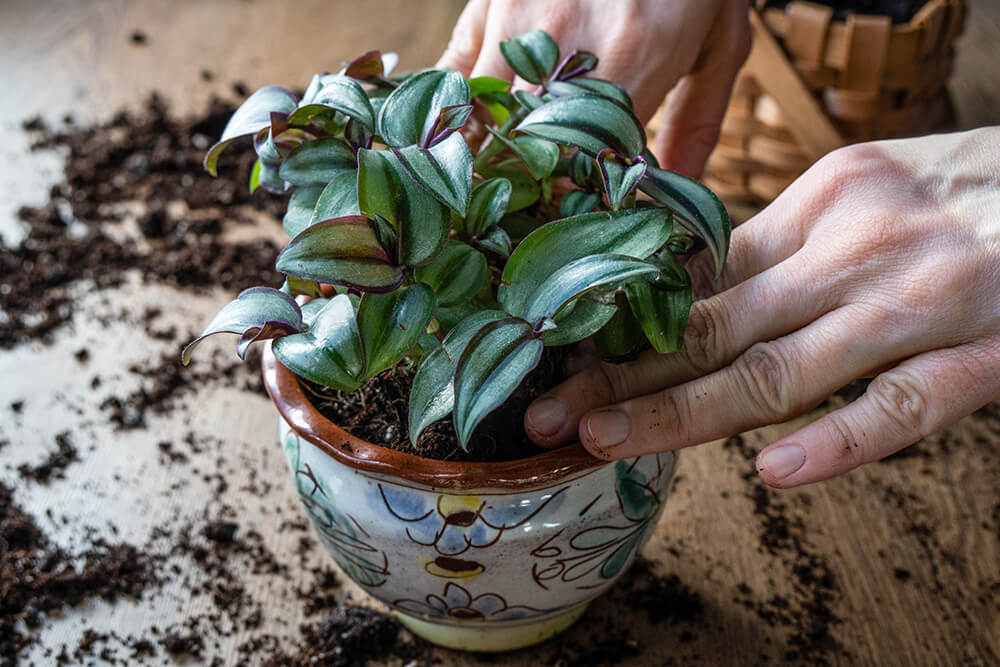
As a generalization, Zebrina represents adaptability, growth, and resilience. Because of its hardy nature, this plant has become a metaphor for overcoming adversity and showing grace during times of transformation. It is an emblem of the human spirit’s perseverance and enduring hope. In literature, the flower appears as a symbol of beauty, strength, faith, and diligence.
Dream books say the Wandering Jew appearing reminds you all is not lost. Stay true, stand tall, and succeed. If you’re holding the flower, it portends luck and prosperity.
Pruning and Maintenance
Because this plant grows quickly, heavy pruning is good for it. Make it an addition to your regular Wandering Jew care routine. Trim off long tendrils, dead leaves, and weak growth. Pinch off new growth and thin it out. This helps create a bushy appearance and transforms the plant into something suitable for your indoor efforts.
Sometimes, per their name, Zebrina goes a-wandering. It becomes leggy stems with few leaves. Keep those trimmed down so the plant can focus its energy more effectively. If you’re plants look rather dull, trimming is the trick for promoting thick leaves.
Perhaps the most important reason for pruning Wandering Jews is to keep them healthy. Removing unhealthy or dead parts deters fungus and disease.
When: Indoor plants often follow nature’s lead, resting during fall and winter. So, give them their haircut in spring or early summer at the latest.
Zebra Plants and Therapeutic Properties: Inch plants have antioxidants and antimicrobial properties. In areas like Jamaica, people treasure them as a treatment for high pressure and cough while applying leaves for swelling. In China, this plant has the name “Water Turtle Grass.” It’s recommended for kidney disorders. Mexicans have an inch plant leaf decoction used as a tonic. Along the same lines, Guyana healers brew the leaves and offer the tea for influenza and digestive issues.
Blooming and Resting Periods
This plant’s flowers benefit from a dormant period the previous winter. Since it’s indoor, you’ll need to put the Zebrina in an area hovering around 60F. Reduce water. You want the soil to dry for two weeks between irrigation. Always use room-temperature water so you don’t shock your plants.
Once the Wandering Jew is growing, you’ll need to water it once a week. Now is the time for fertilization.
There is a legend that surfaced in the 13th century. It says that a Jewish person taunted Jesus on his way to crucifixion. As a result, the person was cursed to walk the earth until the second coming. Another sad account was that of a condemned man separated from his sister by the Bering Straight. He set out to find her, yet wherever he traveled, plagues followed. There is no happy ending here. The fellow never finds his sister.
There is no question that the Wandering Jew is diligent and sometimes invasive, so perhaps some of those characteristics contributed to the plant’s name.
Common Pests & Plant Diseases
Wandering Dudes rarely have pests indoors. Occasionally, you may find aphids or spider mites. You can wash both off the leaves or use a natural insecticide.
When you see small white webs on the undersides of leaves, that’s a spider mite. They like it warm and dry, so amp up the humidity using a household humidifier near the plant. Spray it periodically. Should the critters persist, wash the plant in your sink.
Signs of Aphid infestation include:
- Weakened growth
- Yellowing, twisting, or curling leaves
- Small white flakes on the leaves (this is the result of aphids shedding their exoskeleton)
- A sticky, shiny substance on leaves and stems (honeydew)
- Black, sooty mold (a result of honeydew)
- Diseased plants (aphids carry over 100 different viral diseases that can settle into the Wandering Jew)
Neem oil is a trusted remedy. Apply, then re-apply in a week. Continue more applications until they’re gone.
When it comes to disease, most develop because of over-watering, which leads to root rot. Roots can only retain so much water before they start getting mushy. The good news is you can remedy this easily. Reduce your watering schedule and improve the drainage in the soil. Just add some coarse sand or perlite.
Black patches and white powdery particles on your plant’s leaves reveal fungal issues like leaf spots, botrytis, and powdery mildew. Clean away affected foliage. Make sure your plant isn’t over-watered. If you get stuck and the fungus won’t go away, you should dispose of the Wandering Jew and sterilize the container before reusing it.
In an odd twist, you can grow wandering jew plants in water. You will need to change the water every 4 days and add a little fertilizer (3:1 ratio in freshwater). Using purified water is best. Salt and chlorine can adversely affect these plants. Also, make sure the water is at room temperature. With the right lighting, you can keep Zebrina alive in water for a long time, much like money plants.
Troubleshooting Common Wandering Jew Problems
- Bare stems and spindly growth: Over the years, this is natural. However, in younger plants, it may indicate a lack of light, water, or fertilization.
- Loss of leaf color: When variegated leaves begin turning all green, your plant is getting too much direct sunlight.
- Limp stems: Typically means a lack of water, but could be a sign of insects.
Word Play: The Inch Plant’s name is descriptive to a T. This foliage grows approximately one inch every week! It can also propagate itself using only an inch of stem.
Frequently Asked Questions About Jew plant
Does a wandering jew plant need sun.
Yes, but not direct sun. An area with indirect light is best for these plants. Turn the plant periodically so all sides get filtered light regularly.
How do you care for a wandering Jew indoors?
Now, you may have Wandering Jews that are just indoor plants. But if you have outdoor pines, you; 'll need to bring them into your home before the threat of frost. They’ll do just fine in your household landscape as long as you give them adequate light and proper watering.
How often do you need to water a wandering Jew plant?
If your Wandering Jew develops mushy stems, you’re over-watering it. Don’t automatically bring over the water pail. Check the soil. If it’s dry down to 1”, it’s safe to add moisture. Otherwise, wait.
How long will wandering Jew last?
Wandering Jews are fairly hardy. As long as you care for them correctly, your Tradescantia plants will live for many years.
How big do wandering Jews get?
Much depends on the type. Most plants don’t grow beyond one foot tall but may have longer (2-foot) stems.
Zebrina plants have a rich history and a variety of interesting traits. It thrives in a variety of environments, and has alluring striped leaves, and people enjoy looking at it. When you want to add some living greenery to your indoor garden, Zebrina is one possibility. It’s exotic yet understated, and you will enjoy it for years to come.
- Living Room
- Dining Room
- Laundry Room
How to Care for Wandering Jew for Massive Growth (7 Ideal Conditions)
Having the colorful wandering Jew at home is a sure and easy way to brighten up the room without needing to care for high-maintenance flowering plants. But for you to boost their growth and not just hang around with a couple of leaves a year, you need to take care of them properly!
Ideal growing conditions for wandering Jew plants are 1) 8-inch wide clay pots with drainage holes, 2) moist well-draining soil, 3) regular watering when the top 2 inches of soil is dry, 4) 6 hours of sunlight or 12 hours under 15W grow lights, 5) temperatures between 65–75°F, 6) humidity around 40–70%, and 7) a diluted 20-20-20 fertilizer applied 1–6 times yearly.
Although they are considerably low-maintenance houseplants, they can still die if they are not taken good care of. This is especially true for certain varieties that necessitate more specific growing conditions. So avoid wondering and worrying over why your spiderworts keep dying by familiarizing yourself with what they want and need for optimal growth!
It’s best to grow wandering Jews in clay or plastic pots that are relatively shallow but at least 8 inches wide. This allows them to grow thick and trail whether kept indoors or outdoors. The planter should have drainage holes.
You don’t really need any special type of planter to grow a lush wandering Jew plant . A regular pot will do so long as it is at least 8 inches wide. Otherwise, they will become very leggy !
As you may or may not know, the inch plant tends to trail on and off the soil it grows on. So it’s indeed normal for it to spill over pots, especially hanging baskets even when grown in optimal conditions.
However, this wandering plant still needs plenty of room in its growing container for it to anchor itself into the soil by forming roots along the nodes of its succulent stems and shoots.
Most wandering Jew or Tradescantia plants grow very thickly, reaching 2–3 feet in both length and width. Even the boat lily, Tradescantia spathacea , can grow 2 feet wide despite its upright growth.
Because of this, you’ll also need to go up by 1–2 inches once you need to repot your wandering Jew. If you don’t, you’ll be left with a scraggly spiderwort.
Now, you can also grow this trailing foliage plant in your yard if you want to add pops of color. However, be mindful when using this as a groundcover as it can grow quite wildly and become highly invasive.
Wandering Jew is considered a noxious weed not only in the southeastern region of America but also in Australia and New Zealand. So owners are strongly recommended to keep it controlled in a container even when placed in gardens.
Additionally, if you live in a drier area, opt for plastic pots as they help retain moisture in the soil. On the other hand, home gardeners living in more humid areas can grow their inch plants in clay pots to allow for good drainage and aeration.
Either way, make sure that your spiderwort has at least one drainage hole to prevent water from standing in the pot, which could result in root rot . You will also want a catch plate so the excess water won’t come spilling out of the planter.
Most wandering Jew varieties and cultivars can tolerate a wide range of soil conditions. They can grow in sandy, loamy, and clay soils that are acidic, neutral, or alkaline. Regardless, their soil is best kept moist yet well-draining.
The wandering Jew, unlike many other houseplants, is not picky when it comes to the soil it likes to grow on. It grows fast almost anywhere, from mountainous regions to coastal areas all around the Americas—starting from Canada, going all the way down to South America.
You can keep it in soils rich in sand, silt , clay , and even rocks . Due to its highly tolerant nature, it can grow and flourish in different regions and any corner of your house.
However, there is a difference between surviving in a corner of your house with little water and light and thriving producing lush purple and green leaves. Who doesn’t love to let their inch plant shine?
When grown as an indoor plant, however, you can use ordinary ready-to-use potting mixes for houseplant for your wandering Jew. I personally like this organic mix from Amazon.
Still, there are a few big no-nos if you want to keep a wandering Jew happy and healthy in the soil. First, it doesn’t tolerate soil well. Besides that, it doesn’t like constantly wet soil.
As such, make sure to check the soil condition of your inch plant from time to time. Otherwise, you may only notice that something’s wrong once it has already started wilting significantly.
Prevent your soil from becoming too wet by choosing mixes containing perlite and vermiculite. You can also add them to your regular soil mix. Alternatively, you can go soil-free to virtually eliminate all chances of getting and spreading soil-borne diseases.
Pro Tip: Many houseplants, including wandering Jew plants, do well with soil-less growing mediums composed of 60% sphagnum moss, 20% perlite, and another 20% vermiculite.
3. Watering
As it is a moderately drought-tolerant foliage plant, the wandering Jew plant must only be watered once the top 1–2 inches of its soil has dried out. If unsure, then it’s recommended not to water it.
Similar to how it is with soil, the wandering Jew isn’t fussy with water either. If you really want to get into it, you can use regular tap water, well water, distilled water, rainwater, and even melted snow.
Moreover, chlorine and fluorine in city water are generally harmless to plants. But if you want to be 100% certain, check with your local provider.
All it asks for is evenly moist soil that will let its roots grow well and strong. You can do so by using a slender-spouted watering can like this copper one from Amazon. This will help you avoid getting the foliage excessively wet.
Having said that, it’s important to never let spiderworts in either condition wilt. On the other hand, it should never be left to stand in water—which is why it’s best to go for relatively shallow pots over deep ones.
You will have to adjust your watering frequency based on several factors such as:
- Wandering Jew size
- Container size and material
- Type and amount of light received
- Average local temperature
- Overall humidity
For instance, inch plants grown with sandy soils and hotter temperatures require more frequent watering. Conversely, ones in clay soils and cooler temperatures need less water.
Outdoors, wandering Jew grows best with about 6 hours of direct or partial sunlight each day but it can survive with 4 hours a day if only for winter months. When grown indoors, it can be placed near east or west-facing windows or under LED grow lights that are at least 15–30W.
The vibrant purple, green, and yellow hues of your wandering Jew can be improved and maintained with proper lighting.

Generally, these beautiful colors become more intense as it gets more direct sunlight exposure. At the same time, however, harsh sunlight—as is normal in southern states like Florida—can also cause the wonderful colors of the inch plant to fade.
In other words, you want to strike the perfect balance between the two, especially with wandering Jew plants kept outdoors. But don’t worry, I won’t leave the guesswork to you!
Give your wandering Jew plants about 2–6 hours of full or partial sun exposure before moving them to shadier areas in your garden, balcony, or patio.
Providing wandering Jew plants with some shade prevents them from growing too aggressively and becoming invasive. Even indoors, artificial shading can make it more manageable!
For potted wandering Jews kept indoors, however, a good full-spectrum LED grow light with a power rating between 15 to 30 Watts will be necessary for good growth. Just place the grow light about 1–2ft above the top-most part of the plant and adjust the height as it grows.
To ensure that the light stays on for 12–14 hours, you can use an electric timer. Remember to also regularly rotate the pot so that it won’t become leggy or lopsided.
5. Temperature
The wandering Jew plant thrives with moderate cool to warm temperatures, around 65–75°F. It tends to become very weedy in sustained warm temperatures.
Many newbie home gardeners may find it surprising that spiderwort grows quite well with cool temperatures of 65°F or 18°C as it is widely known to be native to Mexico a hot country. In reality, however, you can also find native species from southern Canada to the United States.
As such, it can live and grow even in relatively cool regions. But in such cases, they are best kept indoors where their growing environment can be better monitored and kept regulated.
Simply put, you wouldn’t need to worry much about your wandering Jew dying from extreme cold if you have a working thermostat along with reliable space heaters.
You see, a wide variety of inch plants can be grown in USDA plant hardiness zones 4–12. Certain species though are less hardy. For instance, T. fluminensis thrives in zones 9–12, T. ohiensis in 4–9, and T. pallida in 7–11.
On the other hand, it can also handle heat quite well. Although it’s ideal to keep the temperature around it at 75°F or 23°C, the wandering Jew can tolerate even higher temps.
Despite its seemingly restricted temperature tolerance , wandering Jew can be grown from Alaska all the way down to Hawaii. Just remember that it can become invasive in hotter areas.
To put things into an even more broad perspective, its tolerance to not only varying temperatures. Wandering Jews can also withstand different growing conditions. All of these combined have allowed it to become naturalized in virtually all parts of the globe.
6. Humidity
Keep moderate to high humidity levels of 40–70% to promote growth in wandering Jew plants. Doing so can help prevent pest problems.
Considering that I just told you they do well in cool climates may confuse you with what I’ll be saying now if it’s new information for you. Sure, cool temperatures normally equate to dry air while warm temperatures correspond with humid air.
But it’s important to keep in mind that these factors naturally fluctuate through seasons and even a single day.
Plus, taking into account that most people grow spiderwort as potted indoor plants , the relation between temperature and humidity isn’t always as linear.
Having said all that, inch plants thrive with high humidity of up to about 70%. This is in line with the fact that they do well in humid climate zones.
Once you notice the tips of your wandering Jew leaves are turning brown, it’s a sign that it isn’t getting enough humility. So turn it up using a room humidifier because regular misting could do more harm than good for this foliage plant. You could also put it in the bathroom!

By increasing the humidity to at least 40%, you can prevent pests such as spider mites from feasting on and killing your otherwise lush and thriving inch plant. Alongside boosting humidity, make sure to also provide sufficient ventilation for your plants.
7. Fertilizer
Wandering Jaw plants do not require fertilizer to survive for many years. However, the application of one can dramatically boost growth. Apply a 20-20-20 liquid fertilizer for wandering Jew once every 2 months to once a year in the summer months. Dilute 1 1/2 teaspoons of fertilizer will 1 gallon of water.
One thing I want you to keep in mind as we end this article is that the wandering Jew plant isn’t a heavy feeder it only needs 1–6 yearly applications of complete fertilizers like the one below from Amazon. It’s mostly content with optimal lighting, temperature, and humidity.
More importantly, overfertilizing your inch plant could lead to very serious consequences—which does include plant death. The thing is, the wandering Jew has a very low tolerance for salt in its growing medium. So you should also water it before fertilizing.
Oftentimes, the accumulation of salt in the soil is a result of too much fertilizer and frequent bottom-watering which can lead to:
- Stunted development
- Discolored leaf tips
- Leaf dropping
- Damaged roots
So although I gave you a general rule to go by above, I still strongly advise you to double-check the instructions for the fertilizer you’ll be using to be absolutely certain.
When your wandering Jew plants start becoming unruly as a result of regular feeding, get your pruning shears and cut away excess stems. But don’t throw them out.
Instead, propagate them for even more plants which you can give out to fellow plant lovers—heck, send them this care guide too!
I have a few wandering Jews myself and I honestly never fertilized them. They are doing fine (not thriving by any means) but such a plant is not demanding. So, no worries if you can’t fertilize it. It will still survive as long as its lighting and watering are right!
How long can wandering Jew plants live?
In warm regions, with climates similar to their native habitats, the wandering Jew is an evergreen perennial plant—meaning it can live on and continue growing for several years or indefinitely. However, when grown and kept in much colder and drier areas, the spiderwort lives as an annual plant dying after just one growing season.
What are the common pests of wandering Jew plants?
Common pests of wandering Jew plants include aphids, caterpillars, deer, mealybugs, rabbits, scales, slugs, snails, spider mites, and vine weevils. They can seriously damage spiderwort shoots, especially young ones. However, some species are more resistant to pest damage than others. For example, purple spiderwort, T. pallida, is resistant to deer.
Is spiderwort poisonous?
Spiderwort, also known as wandering Jew or inch plant, can be poisonous to humans, cats, dogs, and horses. It will mostly only cause contact dermatitis possibility due to oxalate crystals in its leaves. However, the Tradescantia spathacea, in particular, can be moderately toxic when it is eaten in large amounts, causing severe stomach pains.
Summary of How to Care for Wandering Jew
The wandering Jew is a fast-growing low-maintenance plant that can survive a wide variety of growing conditions. However, it grows best in even moist well-draining soils container in shallow but at least 8-inch wide clay or plastic pots. It must be watered once the top 2 inches of the growing medium has become dry.
If grown outdoors, the wandering Jew thrives with 6 hours of direct or partial sunlight. Conversely, it needs 12 hours of artificial light indoors from 15–30W LED grow lamps.
Wandering Jew plants grow well with moderate temperatures at 65–75°F or 18–23°C and considerably high humidity of 40–70%. For feeding, it only needs occasional application—as seldom as once per year—of a diluted water-soluble complete fertilizer after it is watered.
- “Tradescantia” by n/a in N.C. Cooperative Extension
- “Tradescantia” by Leonard Perry in Perry’s Perennial Pages
- “Zebrina pendula wandering jew” by Edward F. Gilman in University of Florida IFAS Extension
- “Caring for Houseplants” by n/a in University of Missouri Extension
- “Indoor plants – Cleaning, fertilizing, containers & light requirements” by Debbie Shaughnessy and Al Pertuit in Clemson University Cooperative Extension
Similar Posts
Brown philodendron birkin leaves causes and solutions.
Philodendron birkin is one of the simplest and quickest houseplants to grow. Aside from that, they can also add greenery inside your home. So, I understand how irritating it is to see brown spots or edges on this lovely foliage plant! Philodendron birkin leaves turn brown due to cold injury, improper watering, plant diseases, overfertilization,…
Moss Pole For Houseplants? (How to Use and Make It)
If you want your plants to grow healthily and vertically, tying them to a moss pole will do the trick. I’ve been doing this for years so here’s a comprehensive guide on how you can do it efficiently. Moss poles give structural support, moisture, and micronutrients to plants, especially those with air roots. To use…
How to Propagate Monstera With Photos (We Did it For You)
Monstera plants tend to grow quite rapidly when they’re happy. You also can use the cuttings to propagate them. To help you learn how and see which technique is the best, I tested different methods. Here’s what I’ve gathered! Monstera can be propagated by planting stem cuttings in soil, sphagnum moss, or rooting it in…
The Best Varieties of Snake Plants (With Photos!)
There are more than 70 species of snake plants that we know of, and it can be difficult to choose which ones to get! To help make decisions easier for you, here’s a compilation of all the easiest and most beautiful snake plants that you can pick from. The 14 best types of snake plants…
9 Reasons Why Wandering Jew Drop Leaves (With Solutions!)
One of the features I love the most of tradescantias is their striking foliage, especially varieties that are variegated. So as you can imagine, it’s never a fun experience to see a wandering Jew plant lose its leaves! A wandering Jew plant will generally drop and lose leaves because of 1) overwatering, 2) underwatering, 3)…
19 Stunning Houseplants With Large Leaves [Photos]
If you don’t know which houseplant with large leaves suits your home decor needs, my compilation can inspire you. In fact, I have been using some of the large-leafed beauties below to cover an ugly patch on my wall. Beautiful houseplants with large leaves include: Monstera deliciosa, Strelitzia nicolai, Dieffenbachia, Ficus lyrata, Fatsia japonica, Ficus…

fresh + local Moscow, ID
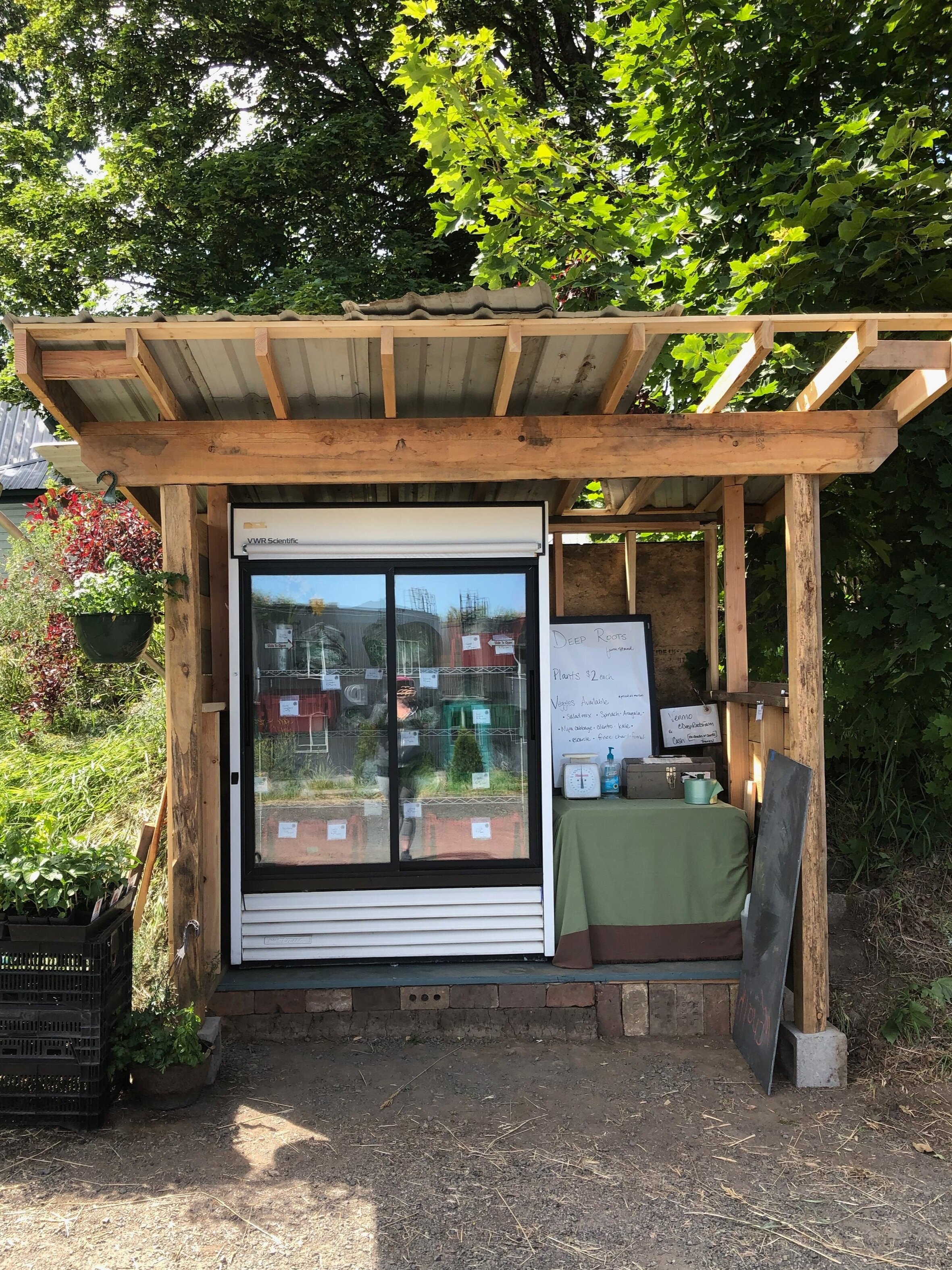
Find the farm stand at the very end of Henley Street in Moscow, ID
2023 Update : Farm Stand will be open for the season by March 18th, updates to follow! We will open for a few weekend before that so keep an eye out on Instagram and Facebook for those dates. You can visit our Moscow farm stand 7 days a week at 225 E Henley St . Open 9am-dusk each of those days. Fresh from the farm veggies, Brush Creek Creamery cheese, Love’s Kombucha in a can, and free-range chicken eegs. The farm stand is self-serve and payment is on the honor system. Venmo (@DeepRootsFarm make certain it’s paid to Greg Freistadt), cash and check are accepted. We are very excited to offer this to our community, please help us by not touching what you don’t need and paying for items you take. Thanks!
You might also find us at the Moscow Farmers Market in May and early June for plant starts and veggies. After plant start season you will find all of your fresh, locally grown and Certified Naturally Grown vegetables at our farm stand.
Deep Roots Farm in Moscow, ID grows vegetables and small fruits using techniques that promote biodiversity on their farm. We practice an intensive planting rotation to create diversity for plant health while increasing production on a small land base. We provide open and untouched space for beneficial insects and wild animals. We grow a wide variety of crops that are well suited to the climate utilizing locally grown and saved seeds when possible. Deep Roots Farm sells directly to their loyal customers at local farmers markets , and at their farmstand. We also love working with local chefs. You can find Deep Roots Farm produce at Maialina , FoodOlogy and Nectar for much of the year. We use only natural methods and do not use any synthetic chemicals for raising healthy food in small spaces all in Moscow city limits. As perennial students of nature and design combined with knowledge and experience of others, we continue to change and adapt the farm and its systems for environmental, human and economic sustainability.
LEARN how to farm on a small scale while making a profit by bringing one of the farmers to speak to your group. Find more information here .

Greg Freistadt
Growing up in Montana Greg always had an appreciation for the natural world. Although focused on outdoor recreation, he developed a green thumb by helping his parents garden and landscape. Greg's love for travel has taken him around the world where in Southeast Asia he gained an appreciation for fresh, local foods and small farming. While pursuing a BS in natural resources from the University of Idaho ('10), he developed a passion for sustainable agriculture. As an intern at the WSU Organic Farm and working at a few other local farms he gained the knowledge to start his own farm and consulting business.
Please understand that during our busy season we may not respond to your emails or phone calls right away.


IMAGES
VIDEO
COMMENTS
But when it's over 90 degrees, they're going to need much more frequent watering. A little shade during the hottest part of the day is helpful. Wandering jew plant outdoors is best placed in a spot where it stays between 50-80 degrees most of the year. Provide a bright, but partially-shaded environment, and your plant will be thrilled.
Tips For Propagating Wandering Jew Plants. Wandering jew plants are super easy to propagate. Take cuttings that are 3-4″ long, and include a couple of leaf nodes. Dip the cut ends into rooting hormone, then stick them in moist soil. Don't allow the soil to dry out, and keep the air around the cuttings humid.
Fill a 6-inch to 1-gallon container that drains with a rich, well-drained potting mix. Water the soil to settle it. Make about a 2-inch indentation in the soil where you want to place the Wandering Jew cutting. Remove the bottom leaves from the cutting where you will be inserting it into the soil.
Wandering Jew plants prefer rich and moist soil that drains well if you're planting them outdoors as a ground cover, mulch around the soil to maintain the moisture. Keeping the soil damp helps in maintaining the humidity that your plant loves. If the humidity is too low, your plant's leaves will eventually turn brown.
3. Pot your Wandering Jew plant. Fill the pot about two-thirds of the way with light, well-draining potting soil, then place the plant in the center of the pot. Add soil to surround and fill in the sides. Gently press down on the soil around your plant and water it until the soil is completely moistened.
W andering Jew Plant Care. To keep your Wandering Jew plant thriving, ensure it receives bright, indirect sunlight. Keep it in average room temperatures of 60-75°F (16-24°C). Fertilize once a month during spring and summer. In winter, relocate the plant to a cooler area with temperatures of 54-59°F (12-15°C).
Repotting Tradescantia Plants. If your wandering jew is beginning to become a bit crammed in its pot, select a pot that's 1-2″ wider than its current one. Prepare your pot with a little fresh potting soil around the sides. Remove your inch plant from its existing pot, setting the root ball into the new one.
Growing Wandering Jew As An Outdoor Plant. Wandering Jew thrives in a temperate climate with fairly high humidity. Hardy in USDA Zones 9-11. Tradescantia tricolor makes a good ground cover in spots receiving bright indirect light, such as around the base of tall trees, which are shady areas. They also serve as a great ornamental and basket plant.
Wandering Jew plants should be watered regularly to maintain a balanced moisture level in the soil. However, the soil should not be allowed to become too dry or too wet. Overwatering can lead to root rot. A good way to check if it's time to water is to push your finger about 1-inch into the soil.
How to care for wandering Jew plant: For the Tradescantia or spiderwort plant to thrive, grow in a plenty of indirect light and plant in fertile, moist potting soil with good drainage. Make sure the soil isn't too dry or too damp and keep medium humidity levels. The ideal temperature range is between 65°F (18°C) and 75°F (23°C).
Wandering Jew plants have a limited lifespan of just a few years, and as a potted plant, you'll notice your wandering Jew becoming very leggy after just two to three years. Unlike other fast-growing plants that benefit from pruning, cutting back a wandering Jew doesn't work well to renew its growth; it simply controls the spread.
Wandering Jew Plant Care. Wandering jew is a stunning plant that have heart-shaped green leaves with purple stripes and a silvery sheen. Depending on the type, the leaves may be solid or have different colors on them. ... Take your indoor plants outdoors and treat them with neem oil or a vigorous water stream. If aphids persist after 7-10 days ...
To care for a Wandering Jew plant indoors, place it in a location with bright, indirect sunlight, such as near a window. Water it when the top inch of soil feels dry, typically every 1-2 weeks, and provide well-draining soil. Additionally, mist the plant occasionally to increase humidity and remove dust from the leaves.
The wandering dude is a novice plant parent's dream: It's an easy to grow plant, has beautiful silver, green and magenta foliage, and drapes beautifully from pots.Wandering dude (Tradescantia zebrina) also is super-simple to propagate so you can make more baby plants (for free!).With its long dangling stems, this plant tends to "wander" all over the place.
The thick green leaves have a fuzzy texture and a purple hue on the underside. You can easily propagate it from the cuttings, both in soil and water, once it gets growing. It bears delightful clusters of blue, purple, white, or rose pink flowers, making it one of the best types of wandering jew plants on the list. 5. Tradescantia Sillamontana.
1. Propagate from stem cuttings. Propagating a wandering Jew plant from stem cuttings is easy and quick. What's more, is that you don't need a special rooting medium or hormone for successful rooting. You just need to root the cuttings in water or soil. Let's start with rooting a Jew plant in water. First, cut at least 6-inch long ...
Move your plant's vines to the side and lay the pot horizontally. Then gently remove the plant from its container. You can put your gloved hand between the soil and the container wall to move the plant out. Put a layer of soil at the bottom of the new container. Then make sure the plant's root ball is untangled.
Let it finish in the sink, then put it back in place. When you walk through your home, regularly check your plant's soil. Put your finger down to the ½ inch point in the soil. If it's dry, then water. Because your Wandering Jew may grow at different rates throughout the year, this test alleviates guesswork.
Ideal growing conditions for wandering Jew plants are 1) 8-inch wide clay pots with drainage holes, 2) moist well-draining soil, 3) regular watering when the top 2 inches of soil is dry, 4) 6 hours of sunlight or 12 hours under 15W grow lights, 5) temperatures between 65-75°F, 6) humidity around 40-70%, and 7) a diluted 20-20-20 fertilizer ...
406.461.8467. Moscow Farm Stand. 225 E Henley Street. 7 days/week 9am - dusk. Moscow Farmers Market. Main Street Moscow. Saturdays May-June. 8am-1pm. Deep Roots Farm in Moscow, ID grows vegetables using techniques that promote biodiversity on our farm. We practice an intensive planting rotation to allow plants to support and nurture each other ...
Living just 3 kilometers from Yug (South), a waste processing complex near the village of Myachkovo, Anna's quality of life has dramatically declined since the facility's October 2019 opening ...
The museum project was initiated by the Federation of Jewish Communities of Russia — the umbrella organization for Chabad-Lubavitch in Russia — supported by the Kremlin and financed by a ...
Two servicemen stand on a tribune of Lenin mausoleum closed due to security reasons, Red Square in Moscow, Russia, Saturday, June 24, 2023. (AP Photo)